

Farrago
vol. 101, ed. 2 est. 1925
CLASSIFIEDS
Notice of Elections
Notice of UMSU By-election
Nominations are now open for an UMSU by-election to fill vacancies in the Indigenous Committee and for Burnley campus positions.
Nominations close at 12 midday on Wednesday 7 May, and a poll, if required, will be held 19–21 May.
Full details, including the Returning Officer’s contact details, can be found here: https://umsu.unimelb.edu.au/makedifference/elections/2025-byelection-may/
Notice of UMSU International Election
Notice is hearby given of the 2025 UMSU International Annual General Election. The election will take place online from the 12th–16th May 2025. All voters will be sent a personalised voting link to their student email account.
All international students enrolled in a higher education award course are eligible to vote.
Nominations are open from Friday 11th April 2025 and close at 5pm (Melbourne time) on Wednesday 30th April. This deadline is strict and cannot be extended; candidates are encouraged to submit their nominations well in advance.
Volunteering
If you spotted the errors in our first edition...
Join us as a sub-editor! Please! We need you! Positions available in news, nonfiction and creative. Inquire at farragomagazine. com/join
looking for young contributor. Hard-working, of good character, meticulous hygiene, social drinker, lives on 4th floor of Building 168 and wishes for long-term companionship. Preference for student journalists, writers, sub-editors and visual artists.
Interested parties may visit farragomagazine.com/contribute
Above Water
Enter the annual creative writing competition and anthology.
Categories include:
Prose: Genre Fiction, Literary Fiction, Creative Non-Fiction (1500 words max)
Verse: Formal poetry and Free Verse (50 lines max)
Other: Experimental, hybrid, playscripts, ergodic, etc.
Winners and Shortlisted competitors will be published in the print anthology.
Email all submissions to abovewater@ farragomagazine.com
Please ensure your name does not appear in your piece (use an alias if you must). All submissions must state in SUBJECT LINE: Category, Title, Word/Line Count, UniMelb student number & optionally: if the piece’s subject matter concerns a marginalised experience, you may disclose whether you belong to the relevant group.
Applications close: 21 July 11:59 pm
Win a $50 Readings Gift card
Enter Farrago’s Nightmare Puzzles raffle!
If our usual puzzles section is too anodyne and sensible for a hardcore puzzler like yourself, why not try our Nightmare Puzzles? Find them on the last page of this edition. Send us your best attempt to be entered
in our raffle for a $50 Readings gift card. No cheating!
Write to Farra-gossip!
Sick of heartache? Life got you down?
Submit your woes annoymously to receive sage advice from our Farr-Agony Aunts.
Just scan the QR Code below.

Follow us on socials!
Follow us @farragomagazine on all major social media platforms. Stay up to date with campus reporting, events, workshops and live-tweets from UMSU Students’ Council.
Boring Disclaimers
Farrago is the newspaper of the University of Melbourne Student Union (UMSU). Farrago is printed on recycled paper by Kosdown Printing. Please recycle this magazine. Farrago is published by the General Secretary. The views expressed herein are not necessarily those of UMSU. If you want to raise an issue with the Union, contact the President and General Secretary at president@union.unimelb. edu.au and secretary@union.unimelb.edu. au respectively.
Farrago is produced and published on the stolen lands of the Wurundjeri and Boonwurrung peoples of the Kulin Nation. Sovereignty was never ceded. We pay our respects to the Traditional Owners of this land and to all the lands on which our University operates: the homes of the Wurundjeri, Boonwurrung, Yorta Yorta
Quiz: Which UniMelb Mascot is Giving YOU a BIG SMOOCH?
Sophie He
Why Does Everyone Hate Farrago?
Lucy Russ
Make Climate Activism Messy
Roro Kinasih
Isaac
Fergus Sinnott
Community Second: Death of the Internet Forum
Dom Lepore
Our Leadership Team and Their Crimes: the Farrarogues Gallery
Infamous Alumni! UniMelb’s Best and Brightest!
Best Ice Cream Spots in Melbourne: The Ultimate Showdown
with Love: Recipes
Emily Macfarlane & Jayden Alexander
Bar Menu Review
Gwynn & Azalea Rohaizam
is NOT about the 2024 Farrago Editors
First Controversy: The Question of the Gown
World’s First Racist Horse
Ivy Pierlot & Ava Vu
Puzzle’s Nightmare Page
Ivy Pierlot & Ava Vu
and Dja Dja Wurrung peoples. We acknowledge that the University of Melbourne is an inherently colonial institution, built not only on stolen land physically, but on the systematic exclusion of Indigenous peoples and Indigenous systems of knowledge. As the University’s student publication for 100 years now, we
recognise our complicity in such systems and strive to actively resist and unlearn colonial ideologies, both our own and the University’s.
Always was, always will be Aboriginal land.
EDITORIAL
This semester, the University of Melbourne enshrined multiple measures to restrict protest, including new University Rules made under Emma Johnston’s Vice Chancellor Regulation and an updated Wireless Terms of Use. Implemented under the guise of community safety, these restrictions fail to address systemic racism while being in complete lockstep with broader crackdowns on pro-Palestine actions.
Earlier this year, the University of Sydney used its own newly minted protest restrictions to threaten an international student with possible suspension. The student, a trans asylum seeker from Malaysia, had written messages on whiteboards condemning the University’s complicity in the war in Gaza. Likewise, the Trump administration has detained pro-Palestine activist Mahmoud Khalil without a criminal charge, instead citing Cold War-era immigration law in an attempt to deport the permanent resident. For those with migration statuses contingent upon enrolment, the threat of expulsion under the new University Rules jeopardises their visas. This precarity is amplified for those who face persecution at home. While all students have been marginalised by Emma Johnston’s new restrictions, compared to their domestic peers, international students have had their political expression effectively designated secondary. The weaponisation of immigration status to suppress dissent is shameful. Because they do not vote, international students are easy targets for political interests in Australia. They have been scapegoated for the housing crisis despite recent research by the University of South Australia finding no direct correlation between rental prices and international student numbers; and further specifying that international students are not competing for the same rentals as locals. International student caps are immigration restrictions. As a nation shaped by over seven decades of the White Australia policy, these proposed limits are merely a new avenue
through which we express old anxieties.
Finally, we want to draw attention to a blatant abuse of power in the Maldives. Muan’s journalist colleagues at Adhadhu New were directly called and threatened by the country’s President. The matter was reported to the police, only to be dismissed by the Prosecutor General’s Office without further inquiry.
Collectively, these incidents collectively highlight an alarming global pattern aimed at silencing dissent.
Mathilda, Sophie, Muan and Marcie


Covers: Chiaki Chng and Maria Quartel
Designers: Sophie He, Mathilda Stewart, Maria Quartel and Chiaki Chng
Sub-editors: Pryce Starkey, Isaac Thatcher, Pip Murphy-Hoyle, Polly Allchin, Ren Richards, Charlie Simmons, Zeinab Jishi and Lachie Carroll
Managers: Angela Nacor & Nathan Pham (Photo/Video), Chiaki Chng & Lucy Brownlie (Social Media), Hallie Vermeend (Creative), Maria Quartel (News and Design), Madeline Barrett (Nonfiction), Hayley Yeow & Ruby Weir-Alarcon (Reviews), Tom Weir-Alarcon & Pamela Piechowicz (Archives)
The editors love: A1 Bakery, Pope Francis (rest in peace), the mighty NTEU, Dolly Parton, all editors past, Emma Johnston (1995 Version), Mary Kin Chan, Michelle, Lachie, Simon, Sluntz and Pat from Above Quota, Antony Green (retire in peace), Blahaj (dead in absentia), Millie, Caro, Charlie, Trades Hall, Kathleen Syme Library, William McMahon Ball Theatre, Poetry Says Podcast, Alice Allan, Patrick Nguyen Kieu, Joshua Barnes, Jo Chandler, Radio Monash, School of Culture and Communication, Lot’s Wife and student media comrades worldwide.
Your 2025 editors are Mathilda Stewart, Sophie He, Ibrahim Muan Abdulla, and Marcie Di Bartolomeo.
CHINESE COMMUNIST PARTY PROPAGANDA AT MELBOURNE UNIVERSITY?
Jangchup Cohen
University of Melbourne Student
On 28 March, I had just finished my class and stepped into the sunshine of South Lawn when some posters on a stall caught my eye. ‘America is not our friend, China is’ / ‘anti-imperialism’.
Being Tibetan, when I see pro-China discourse, I feel I must speak up. So, I spoke to a woman at the stall who told me she was Chinese and that she had spoken to people in Tibet who said they were fine. I responded by telling her that everyone in my family was a Tibetan refugee and that things were not fine as they didn’t flee their homeland for fun. She said that was an imperialist lie and that human rights abuses against the Uyghur people were also lies. Having your family’s lived experiences and trauma dismissed as false was not my idea of a fun Friday afternoon. Shaking with anger, I informed her that people in Tibet had quite literally set themselves on fire in protest of the Chinese government before storming off. I reported this by calling the University’s ‘Safer Community Program’, who, whilst sympathetic, told me they could not do anything about it as they said she had not been aggressive towards me.
After this, I did some digging and found the University of Melbourne has previously allowed for Chinese propaganda that denies the genocide and crimes against humanity occurring in Tibet. In 2009, the University signed a contract with the Confucius Institute. Funded by the Chinese Communist Party (CCP), the institute supposedly supported Chinese language and cultural education. In fact, many critics argue and studies agree it spreads Chinese propaganda. The Federal Government closed the institute in 2021, citing ‘ foreign influence’. ASIO warned that they
could be used by the CCP as a spy in Australia. Studies found the institute presented the Chinese government in a ‘positive light’ and avoided discussion of ‘Chinese political history and human rights abuses’, representing Taiwan and Tibet as ‘undisputed territories of China’.
Why would the University, for so long, allow a CCP-funded ianstitute that has been shown to spread propaganda onto campus? The simple answer is money. Australian universities are afraid of losing revenue from international students from the People’s Republic of China. Take the University of Sydney cancelling a visit from His Holiness the Dalai Lama in 2013 after initially approving it. His Holiness, a Nobel Peace Laureate, no longer makes political statements about China and has only ever advocated for peace. That Australian universities would avoid showing public support for Tibet due to a fear of backlash from the CCP, ignoring human rights abuses for profit, is disgusting. We should be outraged that our money is funding institutions with so little integrity that they are willing to abandon all morals, turning a blind eye to propaganda in the interests of maintaining relations with a government that continues to commit crimes against humanity.
How the University would regulate incidents like what happened to me is more complicated, and I respect other students’ freedom of speech and opinion. However, telling me that the genocide of my people is a lie is not okay, and I will, evidently, have something to say about it.
ANTISEMITISM ON CAMPUS IS HURTING STUDENTS
The University of Melbourne’s new Vice-Chancellor, Professor Emma Johnston AO, has taken office with an enormous and wide-reaching effort to crack down on free expression, protest and academic debate on campus. Given the immense scrutiny last year of the student-led movement against the war in Gaza, these decisions can only be described as political pandering
The University of Melbourne Student Union and National Tertiary Education Union have condemned the actions of the new Vice-Chancellor. In the joint statement, the President of the Student Union, Joshua Stagg stated, ‘this new protest rule has the potential to polarise students, not make them feel safe or wel-
come. Students’ experience of racism is an issue of endless complexity. It requires proper consultation with all relevant members of the community, including peer-to-peer rather than a top down approach. UMSU is committed to listening to students’.
This is something I agree with wholeheartedly. Many communities do feel unsafe on campus, and moves to address racism are necessary. Sadly, the University has failed to act on this.
Recently, I have felt increasingly unsafe on campus due to the comments made by University Council member Mark Leibler AC online. One such comment was ‘Nothing, but nothing, is worse than those Jews who level totally unfounded allegations of
Connor Trainor
University of Melbourne Student
genocide and ethnic cleansing against the State of Israel. They are repulsive and revolting human beings. Their relatives who were murdered by the Nazis - the role models for Hamas - will undoubtedly be turning in their graves. Their avowed anti Zionism is clearly no more than a cover for the reality that they are vicious antisemites.’
I found this disgusting and intimidating. To openly call Jewish students antisemites. To diminish the identity of Jewish students. How can Jewish students feel safe on campus with such hostile commentary being made by the leadership of our university? Is there no duty of care that the University has? Does this not breach University workplace safety policy? Or is this active ignorance by the University, who only seek to address antisemitism when it is politically convenient for them; not when it would improve students’ safety on campus?
Yet, the hate speech from Mark Leibler, who remains on the University Council, the board of directors for the University, continues. A recent repost of Leibler’s on Twitter by the White House glorified the illegal arrest and deportation of a student in
the United States is inherently Islamophobic, and threatens the University’s international student population.
The Vice Chancellor has sought to address antisemitism on campus and create an environment that is ‘safer’ for students and staff. Yet the University continues to ignore the antisemitic and intimidating comments by Mark Leibler, someone who is actively involved in the governance of our University.
As an elected member of the Queer Committee of the Student Union, it is imperative that I work towards maintaining a safe and respectful environment for our queer and gender diverse students. Yet, I myself feel continually unsafe on this very campus because of the increasingly bigoted rhetoric from our University leadership. To allow this rhetoric to continue unabated is to allow antisemitism, islamophobia and racism to continue to fester in our institutions.
I find it increasingly difficult to say that I am proud to be a student of this University, and let alone feel any sense of safety.
UniversityofMelbourneStudentUnion
Office Bearer Reports

President Joshua Stagg
My friends, these are dark times, both in the world, and here at the University of Melbourne. I hope that all of you are doing well.
Firstly, the Vice Chancellor has, upon the first day of semester one 2025, imposed a new ‘Vice Chancellor Specific Rule’ that prohibits a broad range of protest activity across all University of Melbourne campuses. These rules were implemented with no consultation with elected student representatives, nor with the National Tertiary Education Union (NTEU). Hence, UMSU and NTEU released a joint statement shortly following the VC’s new rule. I ask that students look beyond their views on what is occurring in the Middle East when assessing the new rule as it goes beyond a single issue - it will prohibit student activism indefinitely. In the past, the student union at the University of Melbourne fought against the conscription of professors, we protested against the White Australia Policy, and we advocated against the Vietnam War. The right to peaceful protest is fundamental to our student union and we must preserve it for future generations. I am in talks with senior members of the university administration to develop guidelines that will establish what forms of peaceful protest will currently be permitted, but rest assured I am working to protect our right of political expression. I will note that there is a sharp distinction to be drawn between protest activity that makes a student feel uncomfortable as opposed to protest activity that makes a student


feel unsafe. Protests of the latter are not something that myself, nor UMSU, will ever support. However, having a held belief challenged will always make a person feel uncomfortable - it is an irremovable part of the freedom of political expression, and, by extension, democracy. We must, as a community, find the right balance between protecting our right to peaceful assembly and the right of all students and staff to feel safe at our University.
Secondly, I wanted to extend my thoughts to all students wand their families who have been impacted by the Myanmar earthquake. If any student requires support regarding access to CAPS or special consideration, please do not hesitate to reach out.
Lastly, I wanted to note UMSU’s continued work on advocating for reform to support students through the cost of living crisis. Myself and Sara Guest, a PhD student here at the University of Melbourne, have finalised a policy brief to be sent to all Victorian Members of Parliament asking for three key low to no cost reforms including PTV concession for international and graduate students, more tenant protections for students in student accommodation, and a requirement for not-for-profit food providers in state-owned infrastructure.
Again, I want to reiterate that my door is always open. But given that I spend most of my life running between meetings, I established Office Hours each Friday during semester from 3 pm4 pm where I am guaranteed to be in my office. My office is room 227 on level 2 of Building 168 (UMSU Building). Feel free to come by with any issues, or just for a chat.
Look after yourselves,
Joshua

Education (Public)
Viraj Patel & Sonika Agarwal
We launched the first UMSU Assembly of the year, focusing on workers’ rights and union action in Melbourne. Our Education Action Collectives have already tackled topics like ‘What is UMSU?’, digital learning, attendance hurdles, and challenges in first-year subjects.
Beyond these discussions, we’re actively advocating for students’ rights to protest, pushing for improved rehearsal and performance spaces for student theatre and performing arts groups, and working towards a more accessible, employment-ready education experience.
We’re also excited to launch our new badge-making initiative. Come by Bites and Bustles every two weeks, collect a badge, and be part of raising awareness across campus.

Education (Academic)
Harrishman Shobanan & Rhea Sankar
If you’re passionate about student issues or want to share your perspective, join an Education Action Collective and help shape change. Your voice matters. 2025 is our Academic Comeback Year! This year, we’re here to hear any issues/concerns you have with your course/subjects/anything to do with Uni, so please contact us via educationacademic@union.unimelb. edu.au. Using this feedback, we can better advocate on your behalf to the University when ourselves or our Student Representative Network attends like 20 different University meetings! For example, if you’re finding Special Consideration confusing or difficult, or you have issues with your supervisor, send us an email! P.S.: Grab our Know Your University booklets if you’re confused about anything at Uni - they are available at stands now!

Creative Arts
Riya
Gupta & Tianyi Yu
We’ve been all about arts and good times this semester! Our Arts and Craft Market is rocking it at the Amphitheatre-come by to check out the cool stuff or set up your own spot. And if you’re into sharing your vibes, our Open Mic Nights at IDA Bar are where it’s at.
Feeling the mid-semester stress? Groove it out at our Dance Therapy sessions. Plus, don’t sleep on the Mudfest EOI -it’s coming up quick! And guess what? We’re teaming up with Southbank soon, so things are about to get even more exciting. Drop by, get involved, and let’s make this semester unforgettable!

Clubs & Societies
Esther Hiu Wai Luk & Ewan Bezzobs C&S has been busy over the past month! We have been working on providing training for and collecting feedback from execs, as well as reviewing our regulations to clarify and simplify responsibilities. In addition, we granted initial approval to over 20 clubs, and are looking forward to them joining our community. Most excitingly, the first executive mixer of the year was held at Ida Bar, giving our executives a chance to meet each other, share knowledge, and collaborate on future events. Clubs will continue to hold events throughout the year, so definitely get involved if you haven’t already :)

Womens
Khwaish Jadeja & Eya Takrouni Hi everyone!! We are Eya & Khwaish your Women’s Officers and are happy to have delivered a lineup of slayyy events focusing on women’s empowerment and skill-building!! We kicked off by celebrating women through our International Women’s Day.
Featuring student performances, women-specific clubs and engaging conversations with MCWH, the Unimelb Health Promotion Program, and Dr Magdalena Simons.
Building on this momentum, we hosted Women’s Employability Week, where students participated in RSA and barista training, along with a resume-building workshop. The more women in in business, the better. Furthermore, to support safety and confi-

Environment
Jayde East & Helena D’arcy
Apologies for our missing report last edition! We sent our report to the wrong email and missed out. Two catch you up we started off the year strong with multiple stalls at Summerfest, where we launched our Plant Based Treaty campaign and handed out hundreds of brownies. We’ve got the Enviro Collective back up and running each fortnight after being dormant for a couple of years, bringing together a community of passionate students. Together the collective painted a banner for the March for Forest rally that we went to together :D We then ran our first big event, the first ever edition of the UMSU Thrift Market! It was such a fun day with students selling their clothes, local environment groups, free food, mending services and music. To get involved or find out more make sure to check out our Instagram @umsuenviro.

Kunal Dewani & Filia Cahyadi
The semester is well underway, and we hope you're managing to balance assignments, assessments, and, most importantly, taking care of yourselves.
The UMSU Welfare Department continues to serve our students through initiatives like Union Mart, which operates across Parkville, Southbank, and Burnley, supporting over 1,000 students each week. We’ve also been hosting Welfare Brunches on Thursdays and Dinners on Wednesdays, providing vital resources during this Cost-of-Living Crisis.
We recently held a fun volunteering catch-up. We played card games and board games and made new friends. Our UMSU Welfare volunteers have been instrumental in the functioning of Union Mart and are playing a crucial role in supporting students through the ongoing cost-of-living challenges. We are EXCITEDDDD for the remaining semester and for Stress-Less Week too.

Activities
Amy Peters
Queer
Ivy Pierlot
Hi, Ivy again. This semester, we ran a lot of collectives , working on making them as smooth as possible with fantastic Ida Bar catering. Our survey and brochure are on the way hopefully to be released later on in the semester.
People of Colour
Wen Hao (Clement) Wu & Divyanshi Sati
Hi everyone, POC still has many active community events happening after Holi and Eid, including: POC Collective (weekly), BLACK Collective (weekly), Women and Enables Collective (fortnightly), and Queer People of Color Collective (weekly). Thanks to Divyanshi and Joshua, the POC department has summarized key findings from the Racism Report 2024 and successfully launched a new survey round for the 2025 report. There are still many goals we aim to achieve: three major cultural events (Mid-Autumn Festival, Diwali, and the Culture Ball), the launch of Myriad magazine, and the 2025 Racism Report. One more important update: Wenhao is back from his long leave and ready to make the POC department more active than ever!
The sem has been flying by, and the Activities Department has been busy bringing the vibes to campus! Week 3 kicked off with a classic St Paddy’s celebration, complete with sausage sizzles and live music. Respect Week followed with some seriously good eats (huge thanks to the Education and Welfare OBs for jumping in to help!). Bands, Bevs & BBQs brought Camomile and Waax to the amphi, and Queer Week shaped up to be one of our biggest yet, with crafts, Taylor Swift-themed drag shows, and plenty of good vibes all round. Our Easter event was super cute, with committee members and the women’s OB (Saaisha, Om, & Eya) roaming around in giant bunny costumes handing out choccy eggs. Up next: the Cosmos & Costumes party, plus plenty more Tuesday fun coming your way! Lastly, a huge thank you to mr pres and mr gensec, Josh and Luv, for helping our Department (me) navigate all the obstacles we’ve faced recently :-)
Wishing you all the best and hope to see you at an event soon :-)
UMSU Disabilties, International, Burnley, Southbank, Indigenous and GenSec did not submit reports.

Uni News
UniMelb Updates Wireless Terms of Use to Monitor Students
The University has updated its Wireless Terms of Use, specifying its authority to use the network as an avenue through which to monitor possible breaches of University policy.
Introduced 24 March 2025, students have had to consent to these updated terms to maintain access to the UniWireless and Eduroam networks. The new terms state that, including instances ‘where no unauthorised use or misuse of the network is suspected’, the University may monitor the network to ‘assist in the detection and investigation of any actual or suspected unlawful or antisocial behaviour or any breach of any University policy by a network user’. The University also reserves the right to use ‘network data to infer the location of an individual via their connected device’.
These updated terms follow the University’s controversial use of wireless data and CCTV footage to identify student protestors within Arts West/Mahmoud’s Hall during 2024’s pro-Palestine sit-in. In August 2024, following preliminary inquiries, this use of student information prompted the Office of the Victorian Information Commissioner to open an investigation into the University.
Locked Out: Students Rally Against Okta Verify
The 2025 University of Melbourne semester commenced with students protesting against Okta Verify, the University’s mandatory multifactor authentication system. These students have argued that frequent authentication disrupts learning and are demanding the return of the 90-day ‘Remember My Device’ feature.
The movement began on 14 March when third-year Actuarial student Yenpai Cai staged a solo protest on South Lawn. It quickly gained traction with over 700
signatures on a Change.org petition and over 2,400 Instagram followers. ‘I have received overwhelming support from the entire UniMelb community, not just from students but from staff as well,’ says Cai. Protestors have distributed pamphlets and staged demonstrations, voicing frustration over constant login approvals.
The University of Melbourne defends Okta Verify, stating that it ‘continuously reviews cybersecurity measures to ensure that its students and staff are protected from evolving cyber-threats’. However, the University did not provide specific data on cyber threats affecting students.
The protests unfold amid increased restrictions on student activism at UniMelb, with indoor demonstrations recently banned. Despite concerns about potential sanctions, students remain determined to push for change. The movement has also spread to other Australian universities, sparking a broader debate on balancing security with accessibility.
‘I’ve done a lot of reading in feminist theory’: Emma Johnston Responds to Questions about New On-Campus Protest Restrictions
Speaking at the University of Melbourne
All Staff Forum on 17 March 2025, Emma Johnston was asked how she reconciled the University’s diverse community with her new protest limitations. The new Vice Chancellor began by saying, ‘I’ve done a lot of reading in feminist theory,’ and followed up, ‘a space isn’t truly free if people feel unsafe’, emphasising ‘balancing freedom of expression with the need to ensure everyone—especially marginalised or quieter voices—can be fully part of campus life’.
Enshrined 3 March 2025, Emma Johnston’s new Vice Chancellor Rules prohibit ‘protest that unreasonably interferes with core University activities’, including all indoor protest. Students defying the Rules face sanctions, suspensions and expul-
sions.
Pro-Palestine Protesters Defy New University Rules
On 26 March 2025, pro-Palestine protesters gathered on the Parkville campus’s South Lawn before breaching University policy by marching into Arts West/ Mahmoud’s Hall. Around 250 members of the university community gathered on South Lawn to protest the University of Melbourne’s ties to Israel and weapons manufacturers, scholasticide in Gaza and the new University Rules implemented by the Vice Chancellor.
The rally concluded with approximately 100 protesters entering Arts West/ Mahmoud’s Hall, breaching the newly implemented University Rules prohibiting indoor protest. Protesters chanted and facilitated speeches for just over 10 minutes, complying when campus security requested they leave.
The action was part of the National Day of Action for Palestine which saw pro-Palestine protests on university campuses throughout the nation. The rally was endorsed by UniMelb for Palestine, the NTEU, Students Against War, BDS UniMelb, Law Students for Refugees, UniMelb Greens Club, Free Palestine Melbourne, Peringatan Darurat, BDS Youth, WSU 4 Palestine Collective, NTEU for Palestine and others.
UMSU Condemns Vandalism of Heart of Carlton
The University of Melbourne Student Union’s Students’ Council, gathered 20 March, has passed a motion condemning the recent vandalism attacks on local cafe Heart of Carlton.
The first incident occurred Friday 14 February, leaving the establishment’s window puncturing with holes. Subsequently, vandals have further smashed
Sophie He
Lucy Russ
Sophie He
Sophie He
Sophie He
the panes, splattered white paint across the shopfront and, according to a GoFundMe started by the owners, the fourth attack consisted of ‘paint mixed with urine squirted over the front entrance and through the holes in the damaged glass’. The cafe’s Instagram announced the latest attack on 18 March which consisted of three bottles of pasta sauce being thrown across the shopfront.
The owners, Michael and Nadeen Kelly, have started a GoFundMe which has raised thousands of dollars. Their fund description outlines their plan to use the money to ‘restore and secure their shopfront, including new strengthened glass windows, fresh paint and security cameras’.
Speaking to ABC Radio about the first three attacks , Michael claimed that though police were called ‘on each occasion’, they only arrived ‘several hours later’.
Open 6am-6pm every day, Heart of Carlton’s $5 on meals has made it a popular meal spot for UniMelb students.
Baillieu Library Invites Students to Test Possible Furniture Options
Sophie He
The Baillieu Library has been running a furniture study throughout Semester 1. The Library has invited student input by setting up five study zones on Level 3. Students may visit these zones, test the furniture, complete a short survey via QR code and enter the draw to win a $250 Mastercard prepaid gift card.
ALP Club, Liberal Club and Farrago mark centenaries in 2025
Sophie He & Mathilda Stewart
2025 marks 100 years since the contemporaneous foundings of The University of Melbourne Australian Labor Party Club, Melbourne University Liberal Club and Farrago.
On 3 August 1925, students seeking to form a Labor club were granted permission to do so by the University Council. The overall decision in favour of political clubs subsequently saw the Liberal Club’s inaugural meeting held on 18 September 2025.
The ALP club maintains its position as Australia’s oldest student political club.
First published 3 April 2025, Farrago is Australia’s oldest living campus-wide student publication. Brian Fitzpatrick was a founder of both the ALP club and Farrago.
In 1925’s final Farrago, Fitzpatrick wrote that the Labor Club took ‘a melancholy pride in the reflection that they also founded the University Liberal Club’.
Peter Singer Visits UniMelb
Felix O’Kane & Sophie He
The UMSU-affiliated Effective Altruism club facilitated philosopher Peter Singer in the Kathleen Fitzpatrick theatre on 11 March, where he spoke about global poverty and animal rights.
A UniMelb alum, Peter Singer’s work in ethics has greatly influenced the effective altruism movement. Effective altruists attempt to impartially calculate and maximise global good. They apply this philosophy to a variety of causes including global development, charitable contributions and personal life choices.
Club President Francesca Lewis noted the event’s success and encouraged interested students to reach out and get involved with effective altruism.
Speaking to Farrago, Singer had this to say:
‘Hi, as a former University of Melbourne Student, and actually a former assistant editor of Farrago, I’m delighted to be back at Melbourne University and I hope you’re still reading Farrago and I hope it’s a good newspaper like it always was, and I hope that it raises the really important issues of our day which are what we can contribute to making the world a better place for all sentient beings’
2025 UniMelb GSA Election
Mathilda Stewart
The University of Melbourne Graduate Student Association (GSA) election wrapped up at the end of Week Seven of Semester.
Positions for election included five Board positions, all Officer positions (Activities, Women’s International, Health and Welfare, Families, Queer, Education (Coursework), Education (Research), First Nations, Environment and Sustainability, Disability and Equity, Melbourne Online),
as well as positions for the GSA Faculty Council, made up of one representative from each University faculty.
The two tickets active during the election were Together for GSA, and another unnamed coalition of students. Returning Officer Stepehen Lutz commented that the election had seen decent voter turnout. Election results are expected to be released publically soon.
La Trobe University Creates New Student Council, sidelining the Latrobe Student Union
Mathilda Stewart
La Trobe University has this year established a new Student Council to be funded by Student Services and Amenities Fees, with inaugural elections being held in the first week of May.
The move by La Trobe discounts the existing La Trobe Student Union (LTSU), which represents students on the Bundoora campus, and the La Trobe Student Association (LTSA), which represents students at the Albury/Wodonga, Bendigo, Mildura, Shepperton and City campuses.
Nominees for the new Student Council are forbidden from having been an elected member of ‘another student organisation’, having had ‘criminal charges (charged or pending’, or having ever breached any student behaviour or misconduct policies, and must have ‘satisfactory Academic Standing’.
The LTSU has called the University’s proposal an attack on student voice, the LTSU, and independent student unionism, launching an open letter to oppose the Student Council and calling on the University to cancel its formation.

Procedural Injustice in the Vice Chancellor’s Anti-Protest
Decree
Sybilla George
Vice Chancellor Emma Johnston AO set the tone for her tenure by announcing fresh bans on campus protests on the first day of semester 1, 2025. She carries on the work of her predecessor, Duncan Maskell, who in May 2024 banned non-university affiliated individuals from on-campus protests in response to growing public support for the pro-Palestine movement led by student group UniMelb for Palestine (UM4P).
The University Rules under Vice Chancellor Regulation released on 3 March, 2025, bans protests that are ‘held inside, or obstruct entry into, or exit from, any building used for University activities.’ It includes prohibitions on protests or ‘other protest activity’ that ‘unreasonably disrupt(s) activities or operations of the University’.
The new regulations apply to both stu-
dents and staff. Although lawful industrial actions are exempt from the latest regulations, protestors who fail to comply may face trespassing charges.
The meaning of lawful protest in Victoria may soon change. Premier Jacinta Allan’s Labor government has proposed new harsher anti-protest legislation banning the wearing of face masks and the possession of attachment devices, including glue and chains, at protests. Multicultural organisations will also be made to sign a ‘social cohesion pledge’, its contents yet unknown, in order to be eligible for government funding. The new University Rules announced at the beginning of Semester One mirror the state and federal government’s harsher anti-protest legislation.
Vice Chancellor Regulation: the Right to Appeal
Unlike standard University policies, the Rules under VC Regulation are more widely interpretable and lack the usual rigorous procedural checks. The VC sets the terms and conditions for these rules;
as such, they differ from and are not subject to the same procedures as University policies.
This year’s protest restrictions are enabled by the VC Regulation’s Sections 5 and 15, which outline the VC’s ‘Powers, functions and duties’ and her authority over ‘University activities, premises and facilities’, respectively. Former VC Duncan Maskell’s 2024 protest regulation only concerned Section 15.
For students faced with disciplinary actions due to the indoor protest bans, the ambiguity surrounding the appeal process raises concerns, coupled with the lack of rigorous procedural checks and widely interpretable rules. The formation of an appeal panel is limited to matters under the following Sections or policies made under the following Sections of this regulation:
(a) sections 25-28 Student general misconduct
(b) section 30 Exclusion for a notifiable disease
(c) section 31 Student fitness to study. Failure to comply with rules may result in various penalties including but not limited to student general misconduct. Students in breach of the protest regulations can be barred from campus and prohibited from attending classes or examinations under an ‘Immediate Order’ without the right to appeal the decision.
Immediate Orders exclude students from the right to ‘20 University business days for the student to appeal in accordance with the Academic Board Regulation before the suspension, termination, expulsion, and/or exclusion takes effect.’ This is a right for all other decisions resulting in suspension, termination, expulsion or exclusion from the University.
The VC may declare an Immediate Order in a wide range of circumstances, such as:
• ‘risk of material damage to University property’
• ‘risk of material disruption to any activity sanctioned by the University’
• ‘risk that student general misconduct is planned, is likely to occur or will continue, and that cannot be reasonably managed’.
The University did not respond to Farrago’s request for comment regarding students’ right to appeal decisions made under the VC’s Regulation.
Freedom of Speech policy updates
With the University’s freedom of
speech policy amended in February of 2025—for the first time since 2021—where policy 4.3 now states, ‘The University recognises the right to protest as a manifestation of freedom of speech. Protests and protest activity may be subject to other rules or policies made by the University, including rules issued under the Vice Chancellor Regulation or Property Policy (MPF1115).’
The previous freedom of speech policy recognised protests as a legitimate form of free speech, whereas now, it is recognised as a manifestation of freedom of speech.
The new protest ban would have breached the University’s freedom of speech policy had it not been amended days before the announcement of the protest ban. Thus, it concedes that the restrictions had to be enacted via an alternative (executive) regulatory framework to skirt long-held University standards of ethics and freedom of speech. The new regulations amount to an overextension of executive management, typical of the corporatised university model’s response to student movements that critique the same university-as-business systems. ‘Safety’
The University’s appeal to safety to justify the prohibitive protest rules rings hollow following allegations of tracking and surveillance of students involved in the July 2024 Arts West/Mahmoiud’s Hall sit-in. Data collection methods included CCTV footage and geolocating students based on their use of the University Wi-Fi.
A month after the sit-in, the Office of the Victorian Information Commissioner confirmed that the University of
Melbourne was under investigation for breaching the Privacy and Data Protection Act 2024. Despite calls for hearings to be postponed until the investigation into the University concluded, the University went ahead with hearings against the accused students.
Farrago confirmed with the Office of the Victorian Information Commissioner that this investigation remains ongoing. Nonetheless, the University introduced new Terms of Use for the UniWireless Wi-Fi in April, which forces users to agree to be monitored in order to access the internet on campus.
In a letter penned to VC Johnston, the Human Rights Law Centre, Human Rights Watch, and Amnesty International urged the University to repeal its surveillance and protest restriction policies.
Community Consultation
The University of Melbourne Student Union (UMSU) and the National Tertiary Education Union (NTEU) UniMelb branch published a joint statement condemning the ‘authoritarian’ anti-protest Rules that ‘do not address racism or cultural safety on campus’.
In response to Farrago’s questions regarding consultations undertaken with the University community prior to the introduction of the new VC Regulations, the University provided statements from VC Johnston and cited emails sent out to the student body on 3 and 21 March. The statements largely repeated the new Rules and appealed to student and staff safety on campus.
The University is ‘continuing to meet with our elected student representatives,
engaging in constructive conversations to make sure our university community is one where everyone feels safe and supported.’
However, the joint denunciatory statement from union bodies representing significant portions of students and staff disputes this claim. Furthermore, the announcement and immediate enforcement of the new regulation on 3 March suggests no consultation occurred beyond the executive level. The University did not provide any records of the consultations held between itself and student bodies, nor did the University claim such consultations in Farrago’s request for a comment.
UMSU President Joshua Stagg confirmed that the Union received ‘no notice, nor an opportunity to be consulted’ on the new rules.
In a statement to Farrago, Stagg reaffirmed the Union’s commitment to student safety but distinguished between protest activity that makes someone feel unsafe and activity that makes someone feel uncomfortable. The former is unacceptable, but the latter is a fundamental right of political expression. It is an irremovable part of unionism and democratic freedoms.’
Stagg also recalled the University’s proud history of student activism against the White Australia policy and the Vietnam War. The George Paton Gallery celebrated this history as recently as February this year in their exhibition (re)Assembly: Action, Ephemera and Student Unionism.
Protesters Rally for National Day of Action for Palestine
Senior Reporter
The National Day of Action for Palestine on 26 March saw students and staff rally on South Lawn, calling for an end to the war in Gaza. Students demanded that the University divest from all weapons manufacturers, cut all cultural and academic ties with Israel, end the ban on protest and overturn the adoption of the International Holocaust Remembrance Alliance’s defini-
tion of antisemitism.
Protesters heard speeches from Dr Jordan Silverstein, UMSU Queer Office Bearer Ivy Pierlot, Peringatan Darurat and organisers from Students Against War and Unimelb for Palestine.
Students and staff marched from South Lawn and into Arts West/Mahmoud’s Hall, where approximately 100 protesters defied the new Vice Chancellor’s Rules banning indoor protests. While some protesters
remained outside, chants and speeches continued inside for around 10 minutes before security personnel informed protest leaders that they were in violation of the VC Rules and requested that they leave the building. Protestors inside Arts West/ Mahmoud’s Hall promptly followed the security’s instructions to exit the building.
The new VC Rules were announced on the first day of semester one 2025, and come after a historic year of protest at the
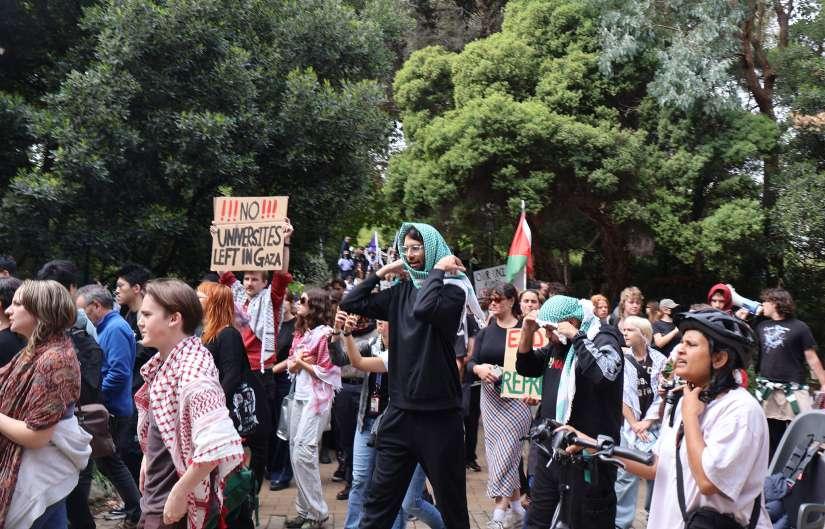
University. The Rules ban protests that are ‘held inside, or obstruct entry into, or exit from, any building used for University activities.’ It includes prohibitions on protests or ‘other protest activity’ that ‘unreasonably disrupt(s) activities or operations of the University’.
Failure to comply with the directives of the new policy may result in student general misconduct. Students who breach the protest rules can be barred from campus and prohibited from attending classes or examinations. Students who breach these policies may also face suspension or termination of enrollment and restrictions on students’ capacity to access the University campus.
University of Melbourne Student Union (UMSU) President Joshua Stagg and National Tertiary Education Union (NTEU) UniMelb Branch President David Gonzalez strongly condemned the VC’s Rules in a joint press statement, calling the rules an ‘authoritarian approach’ that does not address racism or cultural safety on campus.
The VC Rules were shortly followed by the implementation of new wireless terms of use which enshrined the University’s right to monitor students over their networks. To continue accessing the University Wi-Fi, students and staff were required to accept the new Wireless Terms of use.
The new conditions permit the Univer-
sity to monitor students in order ‘to assist in the detection and investigation of any actual or suspected unlawful or antisocial behaviour or breaches of University policies’ as well as ‘to infer the location of an individual via their connected device.’
Despite the University’s efforts, student action for Palestine has continued on campus. Students Against War recently held a forum titled ‘Why Anti-Zionism is not Antisemitism’, while Unimelb for Palestine
has been holding weekly gatherings on South Lawn to raise money for aid provision in Gaza.
While the full impact of the new policies is still unclear, these members of the University community remain committed to their campaign for divestment from weapons manufacturers.


Photography by Mathilda Stewart
Rewriting the Future of International Education:
Major Xu
Australia’s New Student Cap in Question
Australia’s international education sector—long regarded as one of the country’s most valuable exports—is now at the centre of a fierce national debate. A newly proposed policy to reduce the number of international students has sent ripples through campuses, policy circles, and student communities.
The proposal, framed as a response to the housing crisis and infrastructure strain, has implications far beyond real estate. For students—domestic and international alike—this is not just a political proposal; it’s a shift that could reshape the university experience for years to come.
The Politics of Population: Targeting International Students
In April, opposition leader Peter Dutton pledged to cap international student enrollment at 240,000 annually. A reduction of over 80,000 annual enrollments compared to 2023 and 30,000 fewer enrollments to Labor’s proposal.
In addition, Dutton announced a cap of around 25 per cent on international student enrolment at public universities—expected to impact metropolitan universities disproportionately— and an increase in the non-refundable student visa application fee to between $2500 and $5000 for students applying for Group of Eight (Go8) Universities, following Labour’s hike in Visa fees from $700 to $1600 last July.
While Dutton positions the move as a necessary intervention in Australia’s housing affordability crisis, critics argue that both parties should avoid oversimplifying a complex issue and using international students as convenient scapegoats despite making up only 4 per cent of the rental market.
The proposed cap risks deflecting attention away from long-term failures in housing policy, while punishing a group that contributes billions to the Australian economy and enriches university campus-

es culturally, academically and socially.
Campus Impact: Economic Consequenc-
es
and Student Life
For universities, the financial impact could be devastating. International education generates more than AUD 50 billion annually, supporting thousands of jobs and funding critical research. A sudden reduction in enrolments threatens not only revenue but the diversity and vibrancy of academic life on campus. Fewer international students could mean fewer resources, larger class sizes, and potential cuts to staff and programs.
From a student’s perspective,
the international student cap may potentially reshape the university experience. Domestic students could lose opportunities for cross-cultural collaboration. International students may begin to look elsewhere—Canada, the UK, or New Zealand—for more stable and welcoming study environments. Even current students are left uncertain about post-study work rights, visa renewals, and the public perception of their place in Australia.
A Sector Already Under Pressure
Importantly, the federal government had already signaled a tightening of
Photography by Ibrahim Muan Abdulla
international student numbers in 2024. Through Ministerial Direction 111, the processing of student visas slowed significantly—particularly for institutions heavily reliant on Chinese enrolments. The result: a sharp drop in visa applications by early 2025, creating concern even before Dutton’s announcement.
What’s emerging is a pattern of policy inconsistency and ambiguity. While universities are urged to support national economic recovery and international engagement, they are simultaneously constrained by unpredictable shifts in migration rules. It raises a question that students across Australia are asking: what
Where We Sleep: Accomodation
kind of education sector does the country want to build?
A Crisis for Uni in the Western World
Harvard reminded the world of a crucial truth in its recent response to the Trump Administration: universities must not only be places of academic freedom, but also of institutional autonomy, global openness, and moral courage.
As Australia debates how many international students it should “allow in,” we should ask ourselves a deeper question—not how many students our universities can accommodate, but how free our universities are to pursue their missions without becoming pawns of short-term
politics.
Universities should have the freedom to welcome talent regardless of passport. The freedom to build bridges across borders, not walls around campuses. The freedom to resist populism when it threatens the values of diversity, inclusion, and intellectual exchange.
This moment is not only about immigration numbers. It is a test of what kind of academic society we want to belong to. Do we want a higher education system driven by fear and restriction—or one defined by trust, openness, and courage?
Choices and Realities for International Students at UniMelb
Major Xu
When Jude arrived in Melbourne for his exchange semester, he expected two things for housing: a short walk to class and a long list of new friends. That’s how this young British man ended up at Scape, the neon-lit, modern-styled student apartment complex that towers over the edge of the CBD like a glass spaceship.
‘It’s convenient,’ Jude laughs, swirling a spoon in his instant noodles. ‘Like, I roll out of bed and the tram’s right there. And the gym, study rooms, rooftop views—they have everything that I need or even do not need.’ But when asked if he’d stay longer than his semester, he pauses. ‘It’s expensive. And honestly? A bit soulless. Feels like everyone’s passing through.’
Scape’s rents have seen a notable increase in recent years. For instance, the Scape Swanston location, near RMIT

and the University of Melbourne, offers rooms starting at $429 per week. This price point reflects the premium amenities and central location, but it also underscores the financial considerations students must weigh. A quick scroll through housing groups reveals the stress this brings— students often weigh location against lifestyle, balancing social opportunities against financial strain.
For many international students at the University of Melbourne, choosing where to live isn’t just about finding a roof. It’s about crafting a version of home in a city where everything is temporary, fast-paced, and often overwhelming.
Generally, three options are on the
table: official university housing, commercial student apartments like Scape, private rentals in the open market. Each offers a different kind of comfort—and a different kind of challenge.
‘It’s safe, it’s close … but I still feel a bit alone.’
Jiayi, a Masters student from China, chose to live in a postgraduate official apartment managed by the University. Her studio is tidy, and the campus is literally across the street. ‘I didn’t want to stress about house inspections or furniture or talking to agents,’ she says. ‘Here, everything’s just settled.’
The cost of such convenience is significant. For example, the University’s
Photography by Ibrahim Muan Abdulla
Parkville campus offers residential colleges with annual fees ranging from $25,000 to $31,000, which include meals, utilities and Wi-Fi. Compared to the broader rental market, these prices can be overwhelming, particularly for students without scholarships or financial support.
However, being settled does not mean being peaceful. Sharing the floor with other international students hasn’t been as easy as she imagined. ‘My roommate is too frugal, and our different spending habits make it difficult for us to find common ground. We don’t really talk—we all just kind of coexist.’
Last year, dissatisfaction over university accommodation management and rental prices boiled into protests outside the Student Precinct. Posters shared by members read, ‘We are resisting price increases’ as students raised concerns over rising rental prices and lack of transparency in room allocations.
Despite the convenience of living close to the university, Jiayai is looking to move once her current lease ends. ‘Somewhere quieter. Or maybe just more personal. I thought being close to uni would feel like belonging. But it’s not just about geography.’
‘It’s a bit chaotic, but it’s ours.’
Jayden, a cheerful undergrad from Malaysia, lives in a rented apartment in the heart of Melbourne with two of his high school friends. ‘We wanted to stay together and do things our own way,’ he explains. Their two-bedroom flat is older, a little
messy, and perpetually low on toilet paper. But it’s home.
‘We split chores, cook together, and argue over laundry. It’s not perfect, but it feels real.’ For Jayden and his friends, finding the apartment was a cyclical saga of messaging strangers on rental apps and chasing inspections across town. ‘I didn’t know how anything worked. Bond? Agent fees? It’s all a blur now.’
Private rentals are often more affordable than university or commercial student housing options, but they come with different challenges and responsibilities. Navigating lease agreements, reporting and waiting on maintenance requests, and dealing with difficult landlords are some of the many challenges private renters often face.
‘Still I’d rather deal with that than feel like a guest in my own space,’ says Jayden as he recalled the water leak he had last month which took two weeks for his landlord to attend to.
When asked what makes him stay at his private rental, he shrugs, saying the occasional surprise. ‘The landlord is renovating the floor [now], and we don’t have to pay rent until it’s done.’
No Easy Answers, Just Trade-offs
Mouldy and overpriced rooms, broken heaters and appliances, and unresponsive property managers are familiar horror stories from students on online forums. Despite the overwhelming challenges, these spaces often become a source of solace for students navigating the housing
crisis to simply vent their frustrations, share warnings and recommendations, or help each other out.
These online forums can often raise accommodation expectations through glowing reviews of luxe amenities, pictures of sunset study sessions overlooking the city skyline, and promises of community barbecues. Jude, who looked up Scape on Instagram before applying, admits that social media can shape expectations. ‘It looked vibey, but reality is less curated than TikTok.’
What truly matters? ‘For me, it was convenience,’ says Jiayi. ‘For others, it’s price or freedom.’ Jude values social opportunities and proximity. Jayden values control and independence.
In the end, when leases expire, students are faced with decisions to make—move in with a stranger, pay more for convenience, or brave the private market. For International students, and many local students as well, don’t find their perfect home.
In the end, they find a compromise— between independence and loneliness, safety and spontaneity, a noisy adventure and a quiet home.
Because when you’re thousands of kilometres from everything familiar, even a mismatched couch in a too-small living room can become your universe. And that may be enough.

Federal Budget 2025-26
Education at the Centre as Labor Eyes Re-election
Ibrahim Muan Abdulla
Treasurer Jim Chalmers delivered the Albanese government’s fourth federal budget on 25 March 2025—just 39 days before the country heads to the polls.
In a move as calculated as the budget forecasts, Prime Minister Anthony Albanese called the 2025 Federal Elections on 8 March, days after the Federal Budget was scheduled.
Framed as a cost-of-living rescue package with education at its heart, Budget 2025–26 attempts to win back younger voters, working families, and those seeking a better deal on student debt and access to
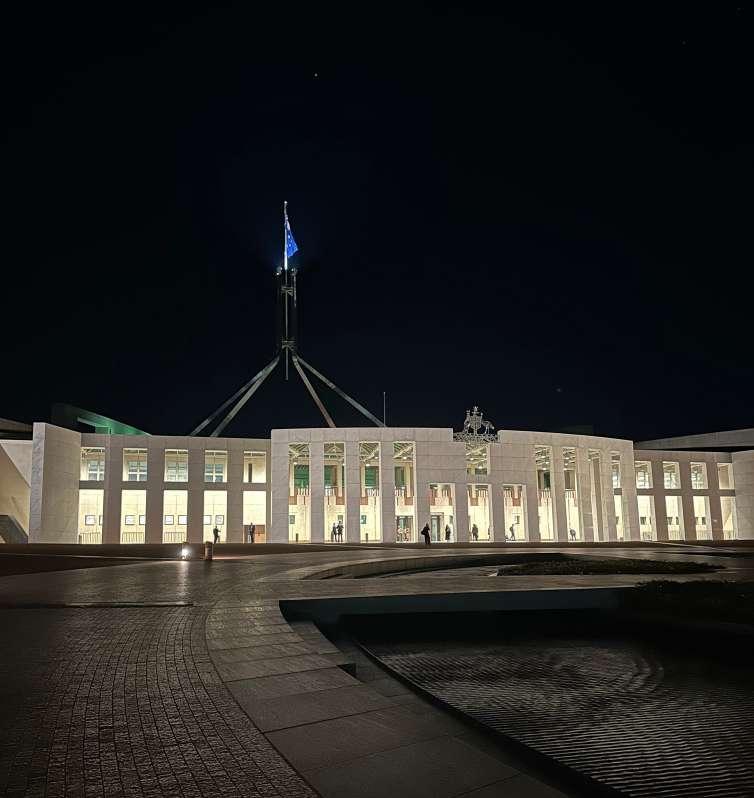
education.
A Universal Vision for Early Childhood Education
At the top of the budget’s education priorities is a $5 billion investment into early childhood education and care. This includes a $3.6 billion Worker Retention Payment to lift wages for up to 200,000 early educators, an effort to combat a sector-wide retention crisis and increase the number of qualified teachers in early learning settings.
Alongside this is a $1 billion Building Early Education Fund to establish and
expand 160 childcare centres across outer suburbs and regional areas. Crucially, many of these will be co-located on school sites to ease transition points for families and educators alike.
However, perhaps the most transformative shift is the $426.6 million ‘3 Day Guarantee,’ replacing the previous Child Care Subsidy Activity Test. From 2026, families will be eligible for subsidised early education at least three days per week, regardless of work or study hours—a policy shift expected to benefit 100,000 families in its first full year.
Schools on the Path to Full Funding
The 2025/26 federal budget lays the groundwork for the ten-year Better and Fairer Schools Agreement, pushing public schools towards full funding under the Schooling Resource Standard (SRS) by 2034. Backed by $407.5 million over the next four years and $7.2 billion from 2029 onwards, the policy addresses decades-long funding shortfalls that have seen public schools lag behind the private sector.
In exchange, states and territories must commit to national reforms that include phonics checks in Year 1, early numeracy testing, evidence-based teaching practices, and improved mental health support.
For public education advocates, it is a watershed moment. For critics, it is a costly ambition made more precarious by the budget’s broader fiscal outlook.
Free TAFE: Permanently
With nearly 90% of new jobs over the next decade expected to require post-secondary qualifications, the government is locking in its popular Free TAFE program. Initially introduced in 2023 as a temporary cost-of-living and skills initiative, the scheme will now provide 100,000 fee-free places each year from January 2027. The budget justifies this permanency not only through labour market needs but also as a method of easing financial pressure on young Australians.
For university students considering switching to vocational pathways or combining TAFE with university study, this marks a significant shift towards greater flexibility and accessibility in Australia’s post-school education ecosystem.
Universities Accord and Student Debt Relief
The highlight of the budget for current university students and recent graduates is the government’s response to the Universities Accord, the landmark review of higher education funding.
The budget commits an additional $2.5 billion over 11 years to overhaul university funding systems, prioritising Commonwealth-supported places and access initiatives for disadvantaged students.
But the headline grabber is the long-awaited student debt relief.
From 1 June 2025, all HELP student
loans will be cut by 20 per cent, regardless of whether repayments have begun.
The move will wipe $16 billion off outstanding student loans. Combined with earlier reforms to reduce indexation in 2023 and 2024, total debt reductions would amount to nearly $19 billion, affecting over 3 million Australians.
The changes also include a fairer repayment system, with a raised income threshold and lower repayment rates. While the Opposition has dismissed the student loan policies as fiscally reckless, for university students—particularly those facing ballooning debts under previous CPI-linked indexation—it’s a lifeline.
Beyond Education: Budget Sweeteners and Surprises
Tax Cuts: All taxpayers will receive a tax cut starting from July 2026. For low- to middle-income earners (between $18,201–$45,000), the tax rate will drop from 16% to 15% in 2026 and 14% in 2027. This will save individuals up to $536 annually by 2027.
Medicare and Bulk Billing: $8.5 billion will go towards increasing bulk billing incentives. The government claims this will support 18 million additional bulkbilled GP visits annually, aiming for 90 per cent of GP visits to be free by 2030. That’s potentially $859 in savings annually for those who regularly see a doctor.
Energy Relief: Households will receive a further $150 rebate on their energy bills as part of the continuation of the cost-ofliving relief scheme.
Disaster Response: $1 billion has been allocated towards recovery from Ex-Tropical Cyclone Alfred, part of a broader $13.5 billion national disaster fund.
Closing the Gap: $1.3 billion has been earmarked for Indigenous housing, employment, business support, and digitisation of cultural assets, including protection against climate-driven coastal erosion.
First Home Buyers: Labor’s Help to Buy scheme received a $800 million boost, increasing income and property value caps to match rising housing prices. The shared equity scheme will help up to 40,000 buyers over four years with government contributions of up to 40 per cent of home value.
Melbourne Airport Rail: A win for
Victorian students and commuters—$2 billion will go towards upgrading Sunshine Station as part of the long-awaited airport rail link.
A Budget in Deficit and an Election in Sight
Despite the spending, this year’s budget is far from balanced. A $42.1 billion deficit is forecast for 2025–26, reversing the rare surplus of $15.8 billion last year. The national debt is expected to grow to $620 billion, prompting criticism from economists and the opposition alike.
Peter Dutton’s budget reply described Labor’s measures as ‘inflationary spending’ and labelled the tax cuts a ‘cruel hoax’. Instead, the opposition has promised lower taxes long-term but offered little in terms of immediate policy alternatives, instead proposing a national gas reserve to prioritise domestic supply over exports—an idea that reportedly angered mining magnates like Gina Rinehart.
What
Does This Mean for Students?
For university students at the University of Melbourne and beyond, Budget 2025–26 is about affordability and accessibility.
From wiping thousands off student debt to permanently funding Free TAFE, boosting mental health support in schools, and improving access to affordable childcare for student-parents, the measures paint a vision of a more equitable, opportunity-driven education system.
The question now is whether voters— and particularly younger voters—will see it as enough.
With the federal election set for May 3, the budget acts as both a final offering and a first salvo in what’s shaping up to be a fiercely contested campaign.
If Labor’s strategy pays off, students might see these promises become a policy reality. If not, the future of this ambitious education agenda hangs in the balance.
Electile Dysfunction Labor Regain Lead as Coalition Flounders
Pryce Starkey
After a gruelling three years of a costof-living crisis, wars in Europe and the Middle East, and the looming presence of American President Donald Trump, Australians are headed back to the polls on 3.
Prime Minister Anthony Albanese and his incumbent first-term Labor government are seeking another three-year term, after toppling Scott Morrison’s Liberal-National Coalition government in 2022.
Albanese will face off against Liberal leader Peter Dutton, who has led the Coalition since Morrison’s defeat, which marked the end of almost a decade of successive Coalition governments.
While initial reports indicated that Albanese would call an election in early March, Cyclone Alfred’s interference forced the Prime Minister to push back the election to May. In the early morning of March 28, Albanese formally called an election for 3 May, kickstarting a long fiveweek election campaign.
A Snap Budget
While a fourth federal budget from Labor would have been avoided had the PM called the election for April, the budget’s delivery by Treasurer Jim Chalmers on March 25, just days before the election was called, was a convenient last-minute re-election pitch to voters.
Between 2023 and 2024 the Albanese Labor government delivered two backto-back surpluses, the first in nearly two decades, a feat Chalmers was unable to replicate a third time.
Most of the government’s policy proposals had already been unveiled prior to the budget, including $150 in power bill relief for households and businesses, an $8.5 billion investment into Medicare to boost bulk billing, and a $25 cap on the cost of pharmaceuticals.
Labor’s $8.5 billion Medicare pledge has become a key re-election commitment, marketed as the largest ever investment into Medicare and the acute cost-of-living relief required by Australians..
The Coalition have thus far matched both of Labor’s healthcare policies, despite describing them as merely ‘Band Aid solutions’ to the cost-of-living crisis.
However, one new policy announcement in the budget defied expectations, with Chalmers announcing a surprise two per cent tax cut for incomes between $18,201 and $45,000, spread over two years.
The tax relief, which amounts to $17.1 billion over five years, would save taxpayers $268 from mid-2026, and $536 a year from July 1, 2027.
The Coalition raised eyebrows after announcing that they would repeal the tax cuts if elected, prompting ridicule from Labor, who accused the Coalition of abandoning their party platform of low taxes.
Shadow Treasurer Angus Taylor described the tax cuts as a ‘cruel hoax,’ ineffective in relieving cost-of-living pressure. Despite the Coalition’s opposition, the tax cuts were passed in parliament with support from the Greens and crossbench.
The Coalition’s budget response includ-
ed plans to cut the fuel tax from 50.8 cents a litre to 25.4 cents for a year and create a national gas reserve to prioritise energy for domestic consumption in the Australian East Coast.
Under the Coalition’s proposed energy policy, designed to complement their $300 billion plan for nuclear power, gas and electricity bills could fall by seven and three per cent, respectively, according to the party’s modelling.
Nonetheless, news of the Coalition’s budget response was drowned out by Albanese’s election announcement just the morning after, a strategic move on the part of the Prime Minister.
Labor Retakes the Lead
Since the election-eve budget, Labor has taken a decisive lead in the polls, regaining momentum lost over the course of 2024.
A March Newspoll following the budget found that Labor had gained two per cent against the Coalition, with Labor regaining their lead by 51 per cent to 49 per cent two-party preferred.
Another Newspoll in the second week of the campaign found that Labor gained another percentage point against the Coalition, placing the party at 52 per cent to 48 per cent two-party preferred, the party’s biggest Newspoll lead since May 2024.
The Newspoll put Labor at a 33 per cent primary vote, up one since early March, while the Coalition had slumped to 36 per cent, down three, results which closely reflect those of the 2022 election.
However, by the fourth week of the campaign, Newspoll showed the Coalition’s primary vote falling further to just 35 per cent, while Labor’s primary vote rose to 34 per cent, with a stable two-party preferred result.
If replicated at a federal election, this would be the worst ever primary vote result for the Coalition, since the Liberal Party’s founding in 1944.
Labor’s improving poll results have been attributed to Albanese’s rising approval ratings, which have been contrasted with skyrocketing disapproval for Dutton.
As of the fourth Newspoll of the campaign, Albanese leads as preferred Prime Minister against Dutton 52 per cent to 36 per cent, with Albanese at an approval rating of -9, and Dutton at a historic low of -22.
As Trump’s ‘Liberation Day’ tariffs disrupt the global market, perceived similarities between the US President and Dutton are proving unpopular among Australian voters.
A recent Coalition policy announcement to force public service workers back into the office was almost immediately reversed following widespread backlash. Dutton has similarly promised to slash 41,000 public sector jobs, and has created a ‘Government Efficiency’ portfolio in his shadow cabinet, held by Senator Jacinta Nampijinpa Price.
Price, who gained notoriety for her role in the Voice referendum’s ‘no’ campaign, recently stirred controversy over a seemingly unscripted moment with Dutton, where she declared that the Coalition
would ‘make Australia great again.’
Dutton has thus crafted for himself a near impossible balancing act – to convince Australians he can protect them from Trump’s instability, while also continuing to recycle the Trump-style talking points which have formed the basis for much of the Coalition’s policy platform.
Defying the ‘incumbency curse’ which has stricken governments globally, voters have turned back to Labor, who have seen their performance in the polls steadily improve since February.
As 3 May draws nearer and Labor inches closer towards a majority government, Dutton’s opportunity to reverse the polls and lead the Coalition back to power continues to wane.

Federal Election Profiles
Ally Spain
Labor
Leadership

Prime Minister Anthony Albanese, member for Grayndler. Albanese has served his Sydney seat since 1996 and as Labor leader since 2019. In the 2022 election, Albanese led his party to victory over Scott Morrison’s Coalition government.
Major Policies of the Last Term
The ‘Help to Buy Scheme’ offers shared equity loans to 40,000 low and middle-income families, aimed at improving housing security by providing greater access to affordable and safe housing. In November, Labor passed changes to the HECS debt indexation, which has been altered to align with either inflation or the wage price index, based on which is lower. With support from the Coalition, Australia also passed one of the world’s strictest social media bans for under 16s, with platforms like TikTok, Instagram and Snapchat having a year to comply, at the risk of a $50 million fine.
Key Issues
While bringing down the ever-rising cost of living will be a major priority across the board, Labor has affirmed its commitment to cost-saving measures by proposing additional cost-of-living policies. Current election proposals include slashing HECS/HELP debt by 20 per cent, reducing the cost of PBS medications, and delivering small additional tax cuts. They have also promised to raise the minimum income threshold needed to pay back student debt and make supermarket price-gouging illegal.
Potential Flips
Deakin: In the outer eastern suburbs of Melbourne, centred around Ringwood is Deakin, the Liberal Party’s most marginal seat in Australia which is currently held by former housing minister Michael Sukkar. Redistribution has moved Deakin slightly north-west and further narrowed its margin from 0.2 to 0.02 per cent. 2022 challenger Matt Greg will re-contest the seat for Labor. Menzies: Also in Melbourne’s diverse eastern suburbs lies Menzies, which extends from Warrandyte in the northeast to Box Hill in the south. While a traditionally Liberal seat, Labor came dangerously close to winning Menzies in 2022, and redistribution has placed its margin by a narrow 0.4 per cent into Labor’s column. Liberal member Keith Wolahan is fighting hard this election to retain his seat.
Coalition
Leadership
Opposition Leader Peter Dutton, member for Dickson. Dutton has served his Queensland seat in parliament since 2001 and became Liberal leader following the Coalition’s defeat at the 2022 election. Dutton’s deputy is Maranoa MP David Littleproud, who comes from the National Party, the Liberals’ junior coalition partner.
Key Issues

In January, the Coalition released a report titled ‘Getting Australia Back On Track’. The report tracks 12 top priorities if elected, including ‘fighting cost of living pressures’, ‘rebalancing migration’ and ‘cutting government waste.’ A significant component of the Coalition’s election campaign is the construction of nuclear power plants to meet domestic energy consumption needs, which has been marketed as an alternative to renewable energy. On education, the Coalition has promised to limit the number of international students allowed to commence study in Australia each year to 240,000 and mandate that no more than one-quarter of students at public universities are enrolled from overseas.
Potential Flips
Aston: While Liberal education minister Alan Tudge retained his seat of Aston in 2022, he suffered a large swing against him. After Tudge’s resignation, Labor’s Mary Doyle flipped the seat in the 2023 by-election in a historic upset victory. Doyle will likely face a wave of Liberal voters returning to the party in this traditionally Liberal seat in the eastern suburbs around Knox.
Chisholm: Chisholm lies in Melbourne’s eastern suburbs, extending from Glen Iris in the west to Wheelers Hill in the east and comprises affluent, diverse areas like Glen Waverley and Chadstone. At the 2022 election, Labor’s Carina Garland won the seat from the Liberals by a 6.4 per cent margin. A favourable distribution for the Liberal Party has put the seat back into play for Liberal candidate Katie Allen, who has campaigned on issues like housing affordability.

Potential Flips
Teals Greens
Leadership
Greens leader Adam Bandt, member for Melbourne. Bandt has held his seat since 2010, when he became the first Greens member in the House of Representatives. The University of Melbourne’s Parkville campus and the residents of its colleges fall within the seat of Melbourne.
Key Issues
Advocates of environmental conservationism and socially progressive policies, the Greens have, in recent years, pursued a more populist approach to politics. They advocate for drug reform, particularly the recreational and medicinal legalisation of cannabis, the inclusion of dental and mental healthcare into Medicare, and Medicare coverage of ADHD and autism diagnoses. The Greens have oriented their policies towards their younger voter base, advocating for free tertiary education, 50 cent public transport fares nationwide, and widespread tax reform.
Wills: Wills encompasses Brunswick, Carlton North and Coburg. The seat is currently held by Labor’s Peter Khalil, who will face an uphill battle to retain his seat against former Victorian Greens leader Samantha Ratnam, due to unfavourable redistribution. Macnamara: In Melbourne’s south, from Port Melbourne to St Kilda, Macnamara is currently less than 300 votes from flipping to the Greens. Incumbent Labor MP Josh Burns is facing a close three-way race against Greens candidate Sonya Semmens and Liberal candidate Benson Saulo. Should Labor slip to third place here, the Greens will win the seat.
Leadership
The ‘teals’ are moderate independent candidates, generally women, running in traditionally Liberal seats. While the teals are not bound by a party structure, they are funded by Climate 200, an organisation that supports pro-climate independents. The colour teal is considered a blend between the blue of the Liberal Party and green climate politics. The success of teal independent candidates in wealthy traditionally Liberal seats can be understood as a result of the Coalition’s move to the right in recent years, and the alienation of moderate female voters.
Key Issues

While teal candidates vary on some policy points, they are united by their climate action policies, such as stronger emission reduction targets, increasing renewable energy sources, electric vehicle access, and phasing out fossil fuel subsidies. They often follow a ‘future-oriented thinking’ approach, pursuing workplace equality, gender pay gap reduction, and addressing sexual harassment, as well as investments in education. Labor’s changes to HECS indexation can be attributed to Kooyong teal independent Monique Ryan, who proposed the changes in a public petition.
Potential Flips
Flinders: The electorate of Flinders covers most of the Mornington Peninsula, where in the 2022 state election, teal independent Kate Lardner came close to defeating the Liberals. Another teal, Ben Smith, will be hoping to mount a strong challenge against MP Zoe McKenzie in this safe Liberal seat.
Wannon: In rural western Victoria, around the regional centres of Ararat, Portland, and Warrnambool, former Liberal trade minister Dan Tehan is facing a challenge from independent Alex Dyson. Dyson is a former radio presenter at Triple J and ran against Tehan in 2022.
Graphics by Pryce Starkey
Esoteric Festival
A Bad Trip for Cancelled Psytrance Fans

The five-day Esoteric Psychedelic Circus Festival, cancelled just hours before gates opened, became the latest in a string of Australian music events to be axed this year. But this wasn’t due to the usual high insurance premiums, lack of ticket sales or extreme weather events that have recently been suffocating Australia’s festival industry.
Instead, a single denied permit brought down the country’s biggest bush doof and left an estimated 2,000 early bird attendees stranded in regional Victoria.
With thousands more en route, small businesses facing massive losses and a media storm looming, a messy blame game erupted between stakeholders. Music and community advocates called it bureaucracy gone mad, while Victorian festival regulators denied any wrongdoing, accusing the event organisers of endangering punters.
In reality, this story is far more complex. and reveals a system which has, and could likely again, negatively impact
thousands of people, small businesses, and an already fragile events industry. Bureaucratic breakdown
Speaking to Farrago, Dr Guy Morrow, a Professor of Arts and Cultural Management, acknowledged the importance of safety regulations, ‘There’s a need to balance a festival’s interests with the safety of its music-loving community.’
In the case of Esoteric, it needed two key permits approved, both of which focused on patron, staff, and volunteer safety.
The first was a planning permit, previously valid for five years, that expired after last year’s event, prompting Esoteric to apply for a new ten-year permit in September 2024. The permit was denied by the Country Fire Authority (CFA) and Ambulance Victoria (AV) on the 28th of February 2025, following requests for further documentation.
AV raised concerns over insufficient measures to address heat health, communicable disease, and illicit substance use.
At the same time, the CFA cited unacceptable fire risks and a lack of mitigation plans for such a long-term permit.
A key factor in the denial was last year’s gastroenteritis outbreak, which affected over 250 attendees.
With the nearly sold-out festival’s future in doubt just days before kick-off, Esoteric applied for a temporary 12-month permit. Relevant authorities approved the permit on 03 March—three days before the festival gates were supposed to open.
The permit was subject to 47 conditions, which Festival Director Sam Goldsmith said his team was ready to adhere to before, during, and after the event.
Several days before the first permit was approved, Buloke Council had publicly warned that ‘even if the planning permit is issued, the organisers will require a POPE-OP [Place of Public Entertainment –Occupancy Permit], which is likely to also be refused.’
Regardless, ticket sales resumed, small businesses continued to stock up, and
Finley Monaghan-Mc Grath
punters readied themselves as preparations continued full steam ahead.
The POPE Permit
The next day following the issuance of the temporary permit, the festival’s second crucial permit was denied by Buloke Council’s municipal building surveyor (MBS), citing 33 grounds for refusal. The MBS operates independently from the council under state law.
In the events industry, it is standard practice for a POPE permit to be approved hours before an event begins, as festivals work to tight deadlines when building infrastructure.
Speaking with Farrago, John McConville, festival volunteer and lifetime member of the community advocacy group Donald 2000, claimed that not only was the MBS absent from the site the day he denied the permit, but he hadn’t visited it in weeks.
‘From the 22nd of February, he wasn’t on site, and so how can he make a realistic judgment of whether [the conditions had been] rectified or not, when he’s obviously not there,’ said Mr McConville.
On the day of the cancellation, Esoteric’s official Facebook page made a statement reaffirming this claim that the MBS hadn’t attended the site. Conversely, though, they claimed that he hadn’t completed a site inspection since 2024.
To further complicate this timeline, there is no official statement from the council on when the MBS last visited the site. Buloke Council declined Farrago’s request for comment.
While the first permit (planning permit) was approved, a significant portion of its conditions implied that the temporary structures—still under construction at the time—would be formally applied for via the POPE permit and inspected upon completion.
Yet despite Buloke Council acknowledging that these structures were unlikely to be finalised the next day and would require approval during an on-site inspection later that week, the MBS rejected the POPE permit the following day.
A Last-Minute Scramble
From 4 to 6 March, the Esoteric organisers made appeals to the Minister of Housing and Building, the Hon Harriet
Shing, and the State Building Surveyor Steven Baxas to overturn the decision. Their appeals were unsuccessful.
Esoteric organisers stated they had addressed the 33 previous safety failures and were expecting a chance to resolve any remaining MBS concerns before the scheduled opening.
On 6 March, the MBS conducted an onsite inspection and concluded that there were nine safety-related items remaining, which were used to issue the Esoteric organisers with an Emergency Order, which is when structures are deemed as a considerable risk to human life.
It is important to note, Esoteric organisers have released all nine of these items and have stated that six of the nine issues raised had all previously been certified by a qualified engineer, or inspected and cleared by WorkSafe and EnergySafe Victoria.
The remaining issues were an unsafe staircase not available to the public, a generator not excluded from public access but having temporary fencing built around it at the time of inspection, and inadequate drainage for an unspecified wash station.
The Esoteric team stated that all issues could have been resolved within an hour by their onsite builders.
Esoteric organisers claimed they had been in meetings with the council to get it over the line until the final hour. However, as the sun set, Event Organiser Sam Goldsmith addressed a crowd that had reportedly waited up to 12 hours in 32-degree heat, many in cars and some dropped off by buses, that the festival was cancelled.
Speaking to Farrago, a ticket holder to the Esoteric Festival recalled the moment they found out the event was off, ‘Tired from the heat and confused by the lack of communication, I just walked back to my car and sobbed.’
‘We all had so much mentally, emotionally and financially riding on this weekend.’
Mr McConville claimed that ‘The local council had indicated to [Mr Goldsmith] that they would give him permission to let [patrons] in on-site for one night, being that there were toilets and there was water and there were 44 food vendors and shelter’
‘The event manager said, ‘give me it in writing that you are requesting that, and that he won’t be held liable if there’s an accident’, their lawyers wouldn’t allow that.’
This left thousands stranded, with the council reportedly not supplying any options for camping in the closest regional town of Donald.
Punters who spoke to Farrago highlighted what it was like after they eventually reached the small town of Donald, ‘It was like the apocalypse, so many others, just like us, sitting in the streets with nowhere to go.’
The community group Donald 2000 and local residents worked tirelessly over the next few days to support punters by opening up access to local public toilet facilities and supplying food and shelter. The Department of Transport and Planning’s (DTP) review
The Department of Transport and Planning (DTP) has reportedly launched a review into the POPE permit process. While no official statement has been made, the timing raises questions about the role regulatory ambiguity played in the festival’s collapse.
While neither side was without fault in the cancellation of Esoteric, the drawnout and disjointed path to that decision highlights a bureaucratic system in need of urgent reform. There were no winners last month in Donald, but it was the food vendors, punters and the local community who were the ones that bore the brunt of this bureaucratic mess. Without meaningful change, Victoria’s events industry faces yet another threat to its survival.
Food at UniMelb: $10 and Under
Sophie He and Sabine Pentecost
Within a campus food ecosystem dominated by retailers, it can be difficult to eat economically. For your average undergrad juggling assignments, work and extracurriculars, time and money are elusive commodities. Here, Farrago brings you on-campus food options for $10 and under.
Campus Canteen
Union Mart
Union Mart is the UMSU Welfare-run free campus grocery store. Found in Parkville’s Building 1888, Union Mart is available for all UniMelb students (please bring your ID!). Its Parkville location is open every weekday from 10am-11am and 4pm-5pm. Union Mart opens at both Southbank and Burnley on Tuesdays 12:30pm-1:30pm. All attendees are allocated 40 weekly points to spend on basic necessities and pantry staples. Menstrual products are 0 points while students who are parents are provided nappies and unlimited baby food. UMSU Welfare also runs brunches and dinners which provide plant-based, gluten-free and nut-free meals. Read UMSU Welfare’s newsletter wherein you’ll find an article about affordable meal options at uni (hey, great minds think


Following UMSU Welfare’s 2024 report Campus Canteen opened on Grattan Street open weekdays 8am-8pm with a rotating expect long lines during peak hours. A Southbank soon.

Named after the historical Princess Ida Club, UMSU’s Ida Bar has reopened on Level 1 of Building 168. During the day, the Bar serves $3.50 coffees and various menu items under $10 (the $7 jaffles being cheapest). Vegetarian, vegan, gluten free and halal options are available. Keep reading to discover how Alex Gwynn and Azalea Rohaizam of Swifties’ Society (Taylor’s Version) evaluate its sundry

A Campus in Crisis, the Parkville Street earlier this year. The canteen is rotating $5 menu. If you’re pressed for time, Southbank location is expected to open
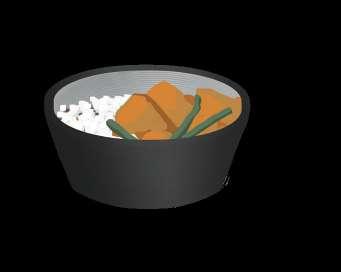
Murrup Barak
Murrup Barak provides Indigenous students with free food in its kitchen, catered lunch on Tuesdays and grocery support. Newly relocated to Level 6 of Building 168 in Parkville, Murrup Barak supports and advocates for Aboriginal and Torres Strait members of the University community.


On Campus
The Campus General Store offers $1.90 machine coffee, pre-made sandwiches around $10 and two-minute noodles which you can prepare using hot water taps around campus.
The Arts and Science societies alternate turns holding weekly sausage sizzles for members. Find them Thursdays on Parkville’s South Lawn from 12pm-2pm. Annual membership to both is $10 altogether which averages to under $0.50 per meal.
Professor’s Walk sells thin cut toasties for exactly $10.
Castro’s Kiosk recently raised the cost of boreks to $7. Options are still spicy potato, spinach and feta, and lamb.
Science Gallery Cafe in Melbourne Connect sells $3 coffees, $6 toasties and offers an $8 coffee and toastie deal. You do the maths.
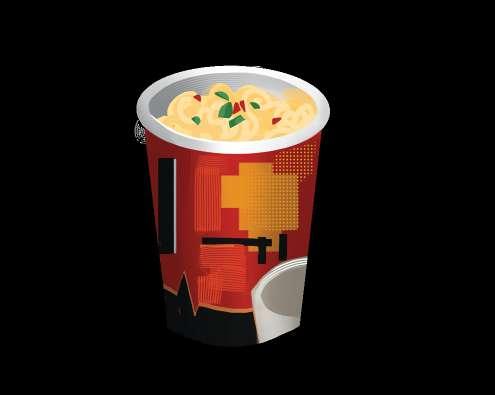

Off Campus
Heart of Carlton on Elgin Street is a staple of the UniMelb student diet, selling meals for $5 and sweets for less.
Cheaper Buy Miles sells discounted groceries near or past their best before dates. Lots of plant milks, meat substitutes and vegan sweet treats. Located across Melbourne but Fitzroy and Brunswick stores are closest to campus.
Madame Linh Vietnamese Kitchen is often overshadowed by its neighbour, Don Tojo, but do not neglect its $9 banh mis.
A1 Bakery’s Brunswick and Fitzroy locations offer $6 cheese pies, $9 kishik pizzas and $10 labne pizzas.

Which Unimelb Mascot is giving YOU a BIG SMOOCH?
Barry the Bear

Nike, Goddess of Victory
Perched supremely upon the University’s coat of arms, Nike is intimating. She embodies victory in battle and is probably why the uni has such a successful engineering program. What’s more, according to the College of Heralds who granted the crest, she is ‘robed and attired proper’. She’s so classy, you might wonder whether you should even try. Hey, we get it, she’s one attractive lady! However, this could be your chance to rise to her level. In turn, you might be surprised by how down-to-earth she is for a girl with wings. Her love language is another Lockheed Martin partnership.

Redmond Barry founded the University of Melbourne, State Library of Victoria, Royal Melbourne Hospital and sentenced Ned Kelly to hang. We like to think this noble (and murderous) spirit lives on in Barry the Bear - the seven foot fur mascot posing for selfies with incoming students and doing the dougie. Famously, he’s a pervert who does NOT wear pants with that sexy UniMelb t-shirt. His love language is dueling.


Artemis J.C. ‘Artie’ Prime
Your favourite time-travelling, beer-guzzling WHORE! Despite his virginal eponym, he sure gets around! His Facebook profile claims his love life has ‘been complicated since 5 March 2018’. Oof, sounds like an acrimonious divorce and an opportunity for you. ’Prime’ implies, of course, an infinite universe of Artie clones, duplicates and counterfactuals - a thrill for lovers of this big ass. Though, how an ungulate can open a beer, much less keep you satisfied, is unclear. He enjoys sausage sizzles on South Lawn but don’t worry, he is not breaking any University Rules. His love language is beer and woke.
Designed by Chiaki Chng

Are you a proud patron of The Clyde?




Do you like Greek Mythology? Are you more interested in The Clyde’s reading group than beers on tap? yes no no
s

Do you like a bad boy?




Would you be amenable to an open relationship?




You are looking for something serious.





Would you like some facial hair to be involved in this smooch? Is clinginess a dealbreaker?


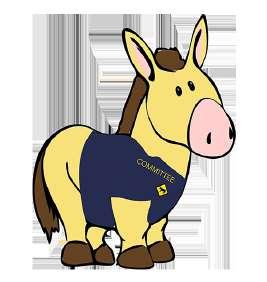




Do you respond well to negging?




Why Does Everyone Hate Farrago?
Despite celebrating its status as Australia’s oldest living campus-wide student publication, Farrago appears to court a limited audience among the students it serves. Why this apathy? And what do these students think?
Lucy Russ
What are your thoughts on the uni paper?
Alex Ciocan, a Commerce Honours student, pauses for a moment. ‘I didn’t know we had a uni paper.’
Really? Have you heard of Farrago?
‘No.’
Oh.
It’s an awkward exchange, but an unsurprising one. Farrago describes itself as a publication that ‘will publish anything’, yet for many, particularly those outside the Arts faculty, it may as well not exist. The problem isn’t hostility; it’s irrelevance. Farrago reads more like a creative writing and arts zine than a space where student ideas, interests and disciplines intersect.
The official student paper of the University of Melbourne Student Union, Farrago’s earliest iteration in 1925 set out its intention to ‘be an open forum for discussion on any matter pertaining to University life.’ Today, its content largely appeals to a niche audience - those who can recite Marx from memory or engage in heated debates over the Oxford comma. While there’s nothing inherently wrong with this, it creates an echo chamber rather than a publication that represents the diversity of the student body. Ciocan scrolls through pages of political coverage and personal vignettes. ‘Yeah, so this has obviously got its own identity as a very artsy, very political publication.’ His assessment is blunt but fair. If a student doesn’t have an interest in politics, poetry or niche film reviews, there’s little reason for them to engage with Farrago at all.
It’s not that most students dislike Farrago; it’s that they don’t care. A publication that fails to engage large swathes of the student population will inevitably become background noise. Major outlets like The New York Times or BBC understand the importance of range, covering politics,
science, sports, entertainment and more with enthusiasm. Farrago, by contrast, has been shaped by generations of humanities students writing what they want to read rather than what all students at large might be interested in. ‘The Finance Student Association has a publication where they’ll do market recaps similar to what’s done in the Australian Financial Review.’ Farrago might benefit from incorporating such articles and collaborating with organisations from other disciplines. ‘If you had a finance section in the uni paper, I think more people would be interested.’
The perception that Farrago is an Arts student’s playground isn’t just anecdotal. A keyword search for ‘business’ on the publication’s website yields no results. The science section has been scrapped. This reflects a broader issue at the University of Melbourne: degrees are highly siloed, meaning students from different faculties rarely cross paths. Ciocan points out Farrago’s potential as a unifying force: ‘If I’m inclined to pick up the uni paper because there’s a finance section or whatever, while I’m there, I might as well check out the science section or the art section and see what else is going on.’ Ciocan points out.
For aspiring journalists, Farrago is an invaluable opportunity to build portfoli os, develop a network and gain industry experience. But should a student paper exist solely as a stepping stone for those pursuing media careers? If the majority of students don’t see themselves reflected in the publication, can we blame them for disengaging? Widening the lens wouldn’t just draw the student body back in, it would sharpen the skills of future journalists, teaching them to navigate a richer terrain of disciplines and perspectives.
Farrago operates on a sizeable budget, with $109,475 allocated to the UMSU Media Department in 2025. Of that,
$72,000 is earmarked for printing with Kosdown Printing, the Union-mandated, sustainable provider. The rest supports events, launches and other media initiatives such as Radio Fodder and the Above Water writing competition. While this funding has gradually declined year-onyear, it remains significant, and, for some students, increasingly hard to justify. ‘Having something that has so much uni funding that’s only for one degree, that a very small subset of people use, is probably not the best utilisation of uni funds,’ says Ciocan.
At the same time, Farrago’s defenders would argue that internal funding is the lifeblood of student-led media, especially when publications like The Age or The Conversation draw from deep wells of advertising and grants in ways a student paper cannot. Still, the question remains: what obligation does a publicly funded student

paper have to represent the diversity of the student body? Ciocan offers a solution: ‘Rebrand or spin-off.’ If Farrago wants to stay afloat, it must broaden its sails. More representative coverage wouldn’t just anchor its relevance, it might also increase its readership, helping to secure greater funding in the long run.
A Response from Farrago editor Sophie
He:
‘Every year, four fresh students commence their editorships with grand ideas for how they’ll reshape Farrago; and we were no different. However, its perceived lack of broad student appeal is an enduring critique lobbied at this publication; with SSAF funding raised as an analogue to taxpayer money wasted. However, unlike
Make Climate Activism Messy
Climate activism has a branding problem: it’s way too fucking serious. The key to saving the planet isn’t getting people to care, it’s getting them to feel kinky, disgusted and emasculated.
Roro Kinasih
Content Warning: References to homophobia and transphobia
Belief, it seems, is in short supply these days. There was a time when we marched with conviction, clutching our metal straws and skipped school every Wednesday to strike with Greta for our future. Now, pretty much all of what we see online is a variation of how sad we are about our lost Bernie era and how it was all better back then and how we failed and that’s just the way it is. At this point, when so much is happening, when despair is at its highest and most contagious, it’s too much to hold onto hope.
Amid the insurmountable big picture of genocide, war, rising anti-intellectualism, the expanding carceral state and the desiccation of the university, there’s also climate change, aka the encroaching catastrophe that has already happened. Here lies yet another infinite array of crises, each splintering into more, endlessly compounding the world’s transgressions. The totality of the problem is simply paralysing, and this sense of incompletion, its enormity and overwhelming scale, has shaped how we perceive climate change.
Of course initially, when Greta Thunberg first rallied students or when Lauren Singer, more commonly known @trashisfortossers, posted her viral video showing four years’ worth of trash packed neatly
into a 16-ounce Mason jar, it felt possible to fix things, to live zero-waste.
We were going to change the world with our individual habits. It was actually happening. At that time, I did genuinely believe that reducing my carbon output and practicing sustainability would save the Earth. It was empowering.
But as the world came collapsing down on us—governments shrugging off catastrophe, the most powerful nation on Earth electing a president who promptly withdrew from the Paris Climate Accord, and each new crisis peeling back the thin veneer of individual agency—my post-adolescent idealistic phase came crashing down on me too.
Faced with the immensity of the problem, we now rely on data points, probabilities, and images of extremes (i.e. melting ice caps, record-high temperatures, satellite images of shrinking coastlines) to make sense of a reality that is already unfolding. By the time we register these signs as evidence, it is often too late to act.
It is all so remarkably cruel, so senseless, so profoundly anti-life. How, one must ask each morning, does one live in such bleak times?
It’s not just the headlines that are overwhelming. It’s the sheer, intolerable nihilism. The prevailing mood is not one of fear or urgency but of resignation.
We have fallen into the seductive lie that we have no agency, no power or means of accruing it, no strong relations with other people, and thus, albeit unspo-
the ABC, any student who pays the SSAF can submit to us. If you want to see the magazine’s content shift, to quote 2003 editor Jackie Bailey, “get out your pen and do something about it.”’

ken, no will to live.
This manifests, naturally, in culture, and no more apparently than in the online, high-art nihilism of core-core TikToks, where dissociated imagery set to melancholic music renders climate and political collapse almost poetic and somehow, nostalgic.
Mark Fisher once argued that our culture’s fixation on a lost (or entirely fabricated) past reflects a collapse of collective aspirations and social solidarity. This is the essence of core-core: a pastiche of grief for something we never really had.
And it is not just core-core. The same casual nihilism pulses through our everyday language, in the casual, desensitised existentialism of fans begging celebrities to ‘run them over with a truck’ or the systemic ‘mainstreamingification’ of CCTV death footage on Instagram and Facebook reels.
What we’re seeing here is a shift in how climate sensitivities circulate. The affective circuits of contemporary youth regarding climate are no longer mere anxiety, but a worry laced with a perverse absurdity, irony and an anaesthesised doom.
And for many, Jodi Dean argues, especially those on the left, the spectacle of climate collapse has become its own
ANOHNI, Miracle Now at PS122 in NYC, 1996
jouissance-like form of engagement, where doomscrolling becomes an ambient form of ‘I told you so’ to the right-wing, capitalist elite. It’s a make-do, brief and bitter form of twisted pleasure amid this twisted state of the world.
It is not our fault that we feel this way. This apathy is a symptom of a world where every crisis feels too vast to comprehend, and one reason collective climate action has stayed stagnant is because, though this absurdist irreverence forms the emotional landscape of contemporary youth, traditional climate activism refuses to engage with these very real, very online feelings.
Mainstream environmentalism remains stubbornly earnest, relying on the hushed reverence of David Attenborough documentaries or the dystopian urgency of Greta Thunberg’s speeches, where the expectation is that we must be serious, that we must feel guilt, to fully comprehend the totality of collapse and count down the days to the end of the world.
But sometimes, the seriousness itself is stifling. It regresses into a performance of purity, of asceticism, that feels detached from the chaotic, contradictory realities of the people it’s meant to mobilise.
In mainstream environmentalist discourse, there is often a perceived ‘right way’ to fight for the environment, one that inevitably foists guilt on those who advocate differently. At the same time, critics on the other side weaponise that same guilt, pointing out the supposed hypocrisy of environmentalists who fly on planes or use single-use plastics. Green identity,
it seems, is structured more by punishment than reward. This punitive dynamic stems from the movement’s emphasis on self-imposed restraint, that of veganism, minimalism, zero-waste lifestyles, where indulgence, pleasure, and excess are typically denounced.
Worse still, mainstream environmental discourse often aligns itself with a certain aesthetic of virtue, one that is often inaccessible to those without the privilege of clean, curated, carefully controlled lifestyles.
Minimalism is an aesthetic of wealth. Slow fashion is expensive. Veganism, often presented as an ethical imperative, is not always financially or culturally feasible. The image of the modern environmentalist—earnest, disciplined, morally upright— is exclusionary by design.
A rebrand is long overdue. Nicole Seymour has called for a reimagining of climate activism, and I’m inclined to agree. If mainstream environmentalism is tied to whiteness, masculinity, and class privilege, what might happen if we invite disgust, kink, and emasculation into the mix? What if climate activism could be playful, messy, and joyfully imperfect? What if, instead of being paralysed by the overwhelming scale of collapse, we learned to laugh at the absurdity of it, not out of apathy but out of defiance?
ANOHNI’s Miracle Now presents a messy, defiant ceremony that weaves queerness with ecocide, rejecting the polished, heterosexual aesthetic of mainstream environmentalism. ANOHNI, speaks to feeling alienated from the
Dendrochronology
On disavowed memories, waiting and Queer temporalities
Isaac Thatcher
Human beings and trees are not so distantly related. As we age, our mature selves come to be by growing around the parts of ourselves that already exist. Like rings in a tree trunk, we are always adding to, not moving away from. Even if we don’t like it.
I grew up desperate to grow up. With
my eyes ever-fixed on the horizon, my memories of childhood and adolescence were like photographs faced down and left to gather dust. I incessantly searched for the next milestone, obsessed over the life I thought I had to be building. If you don’t preserve memories, stargazing and self-loathing will rot anything away. My future self was who would really count, I thought. Who I was right then—he wasn’t
broader, straight-laced environmental movement: ‘I was an urban queer with all the specific shit that goes down with that… I didn’t have access to a broader heterosexual thoroughfare.’ Here, queerness is framed not as unnatural but as the ultimate expression of nature, a feral force that grows despite everything designed to stamp it out. ‘Nothing could be more natural than queerness or transness… a society or a church could want nothing less than a faggot or a trans person. And yet that child grows forcibly like a weed … refusing not to exist.’
It’s this stubborn, unruly existence, this refusal to fit neatly into a pedestrian binary, that feels so urgently relevant to climate activism today. In a movement obsessed with purity and control, Miracle Now offers something wilder, weirder, and infinitely more alive.
Ultimately, truly understanding climate change and truly resonating with contemporary affective circuits requires escaping the fascination of the picture, away from the overwhelming and totalising perspective that treats the crisis as an all-or-nothing scenario.
It means embracing the partial, the fractured, the deeply human need for politics rooted in power, desire, and culture. An activism rooted in playfulness and play is an activism rooted in solidarity. If we want climate activism to remain relevant, it needs to evolve and reflect the messy, contradictory people it claims to represent.
real.
Only recently have I begun to re-examine old memories with a softer gaze. I try not to consider my teenagehood as lost years—I still lived them, even if my memories are sparse. I just lament being so afraid of living fully. In this search for reconnection, I’ve fallen down the rabbit hole of ‘queer time’. ‘Queer time,’ says Jack Halberstam, ‘[is about] the potentiality of a life unscripted by the conventions of family, inheritance and child rearing’. Emerging from the AIDS crisis, queer time offered a way for the terminally ill to come to terms with time’s ‘compression and annihilation’,

by
Nathan Pham
so caught up in reclaiming the youths of which we feel we were robbed that we don’t see the possibilities right in front of us. The only way to fully embrace life is to radically change that perception of a life course, to embrace that I cannot and will not conform to a patriarchal, capitalist formation of time. I was born to exist outside of it. Jack Halberstam would suggest:
part of what has made queerness compelling … has to do with the way it has the potential to open up new life narratives and alternative relations to time and space… queer subcultures [producing] alternative temporalities by allowing their participants to believe that their futures can be imagined according to logistics that lie outside of those paradigmatic markers of life experience—namely, birth, marriage, reproduction and death.
by finding hopeful ways to conceptualise the time they still had. Queer time, in current thinking, has come to signify the rejection of a capitalist, patriarchal progression of life. For Halberstam, it refers to ‘temporalit[ies] that emerge within postmodernism once one leaves the temporal frames of bourgeois reproduction and family’. I think of my younger self. I thought I was going to be married, skinny and full-time employed before thirty. I was desperate to be a different person, to attain capitalist patriarchal fulfillment. I’ve met none of my childhood goals. I haven’t even come close. Yet I wouldn’t call myself unfulfilled, not by any means.
It’s got to do with our world, I think, how our histories are conceived. Caroline Dinshaw et. al. theorise there is a ‘scholarly imperative…to view the past as other’. It’s a basic defense mechanism: historians frame the past as distant, and we do the same with ourselves as a form of disavowal. In this, we can evade responsibilities not just to ourselves but to others. How we view our pasts is directly correlated with how history is viewed more broadly. In so-called Australia, colonialism buries its dirty history. So, is it any surprise that we internalise it in every other aspect of our lives?
We unwittingly separate ourselves from our own rich histories and go insular, taking on the crushing weight of you-are-only-living-your-life-startingfrom-this-moment-so-hurry-up-you’rerunning-out-of-time.
And we do it over and over again. I understand the desire to distance the current self from the former: being proud of change is part of growing up. But cleaving apart the inherent multiplicities of the self cannot be healthy. It’s easy to sneer at our younger selves than have compassion for who we were—for a self that is still underlying. And LGBTQ people seem to be especially susceptible to this. It’s the waiting.
‘Waiting … seems to be a form of postponement until it becomes clear that nothing has been postponed and nothing will be resumed,’ says Halberstam. Waiting. I am always waiting for something. I’ve done so much fucking waiting. Lots of LGBTQ culture revolves around the idealisation of youth: an epidemic of millennial and Gen X gay men obsessed with looking young forever, adult transgender men carrying boyish aesthetics with them long after a cisgender man would have let them go. All of us are
Uncertainty is too scary. Sara Ahmed would say we’re all looking for a seat at the table that’s not been left for us, or is entirely the wrong shape. Even when we distance ourselves from ‘the family line’, we are still tending towards it. Ahmed acknowledges ‘being out of line can be uncomfortable’. But being out of line gives us a vantage point which, I think, is a shame if not used.), We watch a straight family line that repeats itself again and again and again. Is it not a gift to be inherently outside of this framework? To be able to distance oneself from the scaffolding of a capitalist, patriarchal nuclear family if we so choose? To see the cracks in the family line growing wider and wider all the time? Gayness and so forth as not just a sexual identity but an entirely different way of life?
Cutting away our younger selves and feeding them into this great churning sky-machine is what makes the time we have feel so limited. If we can’t engage with the children, teenagers and young adults we once were with empathy, then we can’t enmesh their pasts with our present, can’t allow those years to be ours too. It’s a suffocating feeling. Each day, the sky lowers itself a little more. Gravity compresses with this new normal and I feel it first in my shoulders, then at the back of my eyes. Before I know it, I’ll be
Photography
old and grey and a whole lifetime will have passed me by—and I won’t have been paying attention. There’s not enough time in the day for everything I want to do. I’ve taken to waking up early most days, even on rare mornings where I’ve got nowhere to be. I read, do some exercise, shower and make breakfast without rushing. But bubbling under the surface is resentment: resentment toward how short the days get, resentment that there aren’t enough days in the week, resentment that I spent my teenage years so depressed I hardly did
Bleak Houses
Films, winter and the uncanny
Fergus Sinnott
Content Warning: References to suicide, suicidal ideation
Contains spoilers for Misery (1990), First Reformed (2018) and I’m Thinking of Ending Things (2020).
WhenI was seventeen, I wrote a short story called ‘Winter People’. A couple retreats to a cabin in rural Vermont during wintertime and are forced to confront the discontents of their relationship after becoming snowed in. A central motif was a frozen-over lake on which the couple had fond memories of skating together. One of the pivotal moments in the narrative sees the couple going out on to the lake again, attempting to recapture the joy of that memory, before the ice breaks and one of them falls in, necessitating that the other step in to save their life.
The metaphors were almost self-evident: the relationship was no longer what it once had been; the couple was, quite literally, skating on thin ice. The conditions of the weather—indeed, of the season itself—were commensurate with the iciness the two harboured towards each other. But I liked that story, and thought it was one of the better ones I had written up until that point. It precipitated themes by which almost all my fiction writing since then
anything at all. The outer rings of my tree struggle without a solid core to keep them sturdy . It’s all an attempt to make up for lost time, isn’t it? Everything is an attempt to make up for lost time. And queer theory knows I feel that I’ve fallen behind. And in the malady lies the cure: it’s all self-love, baby.
Who are we to impose straight expectations of timeliness on ourselves? Who are we, really? Until I have the answer, I’ll keep watching the sun rise. I try not to resent it, but I do think: dearest
has been characterised: frigidity, isolation, a retreat into the subjectivity of the self.
The 2020 film I’m Thinking of Ending Things is one that similarly inverts the traditional modes of self and other, and was the first film I’d actively counted down the days until it was made available on a streaming service. I’d read the novel by Iain Reid from which the film was adapted during the pandemic, a condition with which its cold empty backdrops and general preoccupation with the theme of isolationism seemed eerily comorbid. The film, directed by Charlie Kaufman, is one of the most intriguing examples of bookto-film adaptation I’ve ever borne witness to. Kaufman—who serves as both the screenwriter and director—takes several liberties with his filmic reinterpretation, including an uncanny staging of an Oscars ceremony in a high school gymnasium. This is one of many deviations from the source material that nonetheless makes the film almost as impactful as the novel on which it was based.
The title I’m Thinking of Ending Things is falsely provocative, referring not to suicidal ideation, but to the main character Lucy’s (Jessie Buckley) thoughts about terminating her relationship with her boyfriend Jake (Jesse Plemons), the parents of whom they are on their way to meet for the first time at the outset of the narrative.
Iain Reid’s novel takes the implicit anxiety embedded in meeting one’s partner’s parents for the first time and makes an existential monstrosity out of it. From the moment the film starts, a sense of inhospitable disquietude forces itself upon the viewer, made manifest through
sun, I wish you’d put more time in the day.
the bleak wide shots of semi-abandoned service stations and highway shoulders, or through extended scenes of disquieting domestic tension. In both Reid’s novel and Kaufman’s film, what is questioned is not only the extent to which one is ever truly able to know another person, but also the extent to which one is alienated from themselves.
A film that stages a similar uncanny bastardisation of domestic affairs is Misery (1990), adapted from the Stephen King novel of the same name. So too in Misery does the pervasive presence of cold weather prefigure a harrowing domestic experience for the film’s protagonist, famed novelist Paul Sheldon (James Caan). In Paul’s case, the prefiguration occurs quite literally, given that it is the snow coverage that causes his car to veer off the road and suffer a near-fatal accident. His being saved by his self-proclaimed ‘number one fan’ Annie Wilkes (Kathy Bates) sets off a series of performative domestic rituals at her discretion as he is sequestered in her Colorado farmhouse and made to participate in her perverse re-enactment of domestic bliss.
Anyone knowledgeable with the work of Sigmund Freud will undoubtedly be familiar with his essay on the uncanny, a word which refers to that which was once familiar, but has been alienated through a process of repression. Freud notes in the essay that in the original German, ’unheimlich’ is a direct antonym of the word ‘heimlich’, meaning homely or familiar. It would appear, at least according to Misery and I’m Thinking of Ending Things, that there is something endemic to the isola-
tionism and frigidity of winter that fosters such unhomely machinations of domestic life. Indeed, the very title of Misery, taken from the protagonist of Paul Sheldon’s in-universe text, seems to be part and parcel of such a seasonal condition.
But perhaps in no more disturbing a light is the wintriness of a landscape concomitant with such suffering than in Paul Schrader’s First Reformed (2018). The film follows Reverend Toller of the First Reformed church (Ethan Hawke), who suffers a crisis of faith and spirals into self-annihilation after a man he had attempted to counsel takes his own life. The inhospitable bleakness of the natural world which figures so heavily in the film’s cinematography foregrounds the growing pessimism of the central protagonist. The film serves as an ecocritical indictment of capitalism and greed, and begs its audience to question just how far one ought to put themselves out in order to advocate what they believe in.
I’ve always found there to be something strangely comforting about winter: the stillness of bleak alpine vistas; the trail of footprints left behind in the snow, which then suddenly come to an inexplicable halt. More than any other season, winter is the time at which my fascination with the natural world reaches its peak. Indeed, while such films might be said to foreground the extent to which winter serves as a backdrop for some of the worst machinations of the human condition, as Henry David Thoreau writes, ‘if the race had never lived through a winter what would they think was coming?’

Photography by Angela Nacor
Community Second: Death of the Internet Forum
The
enshittified internet and the friends we don’t make along the way
Dom Lepore
My memories of the early 2000s–2010s Web 2.0 era are soaked with romanticism and optimism for an unpolished web that prioritised individual expression over profit. Today, those halcyon days are a distant memory. The spots for that expression, online internet forums, which many used to call home, are scarcer than ever—that is a direct consequence of today’s profit-motivated internet.
Forums are websites or designated sections on sites where people can converse about specific interests by posting and reading messages. What made them unique in Web 2.0’s heyday was their separation from burgeoning, towering institutions like Facebook and Twitter. As the internet has rapidly expanded in size, so have these dominant infrastructures that focus on generating revenue for corporate interests. This has caused another problem: enshittification. ‘Enshittification’, a term coined by Cory Doctorow, refers to the degradation of online platforms as profit is given precedence over user experience. As a result, the fun is gone: Twitter, once home to succinct and iconic text posts, is now Elon Musk’s X, a swamp perpetuating right-leaning content. Meanwhile, Reddit and Discord have made the niche forum board obsolete, functioning as the dominant forces for specialised hobby discussion. As a longtime internet dweller, it is disheartening to watch profit incentives kill not only the internet forum, but the tight-knit communities it facilitated.
The most glaring concession for passionate, uncommercialised forum participation has been exchanged for the limitations of Reddit and Discord. Reddit hosts a network of communities called ‘subreddits’ that users can join
and participate in, like forums. Through their voting system, ‘good’ content is valued and pushed, incentivising users to actively participate by writing and voting comments. Moreover, Discord is an instant messaging platform where users converse through private chats and communities called ‘servers’ containing text ‘channels’ that segment topics like forums. While these discussions on Reddit and Discord ostensibly resemble forum exchanges, they are moulded to fit the expectations of these platforms. Many discussions persist, but Reddit’s inherently opinionated, upvote system means there’s underlying encouragement for a community’s preferred content. Forums
were structured by recency whether people liked something or not; on the contrary, if Reddit users dislike something, you’d be hard-pressed to find it on a community’s front page. Instead of productive comments, often you’ll find some postironic meme posts or comments pushed to the top over a palatable conversation. On top of this, user data is fed to Reddit and Discord because that’s how they operate: they feed on the user, whose subreddits (and therefore interests) merely inform the efficacy of advertisers. In comparison, internet forums were an unadulterated passion project: profit-seeking wasn’t in the picture, it was all for the love. These sites don’t prioritise the




preservation of lasting discussions. On Discord, messages are quickly lost because they’re like text messages. The most recent messages are buried when people shift to another topic, with little opportunity for enduring, singular discussion. Sorting posts by ‘New’ on Reddit shows how many discussions are tossed aside so quickly, a consequence of people talking about the same thing or eagerly hopping onto something else. Any Internet Archive or Google search will show bustling conversations for days on end on forum boards, like-minded talk on a topic with an inherent desire to spend lots of time engaging with peers instead of brushing them off. It’s quite morbid seeing those threads gather cobwebs, bountiful pools of information now frozen with little movement in the replies since everyone has gone elsewhere. While these conversations seem frozen, their longevity is only enabled by the continual preservation and upkeep of the Internet Archive. However, much of the internet’s recent history has already become lost media, with many images, or file embeds from these forums that are older than a
decade disappearing. People used to say, “If it’s on the internet, it’ll be there forever,” but with the archaic image and web hosts no longer existing, a new meaning emerges—online content and community aren’t as permanent as we thought.
In a way, it’s good how the broad user bases of Reddit and Discord have facilitated large communities of hobbyists. There are more people than ever using the internet, which means conversations about the nichest interests can be had with few boundaries. However, that community doesn’t negate the existence of detractors like toxic users or trolls. While these characters absolutely existed on those small forum boards, their numbers were proportional to their smaller platforms. Unfortunately, all those problematic users are all consolidated on a few monopolised sites. Everyone has now been funnelled into the same larger, sanitised platforms. Due to lasting domains and the nostalgia factor, there are still some forums online, but all these people create clutter and now it’s that much harder to find lasting, genuine
connections on the internet. You used to be able to count your close online friends on one hand. For me, that’s still true with those whom I met just a decade ago, but I doubt the victims of this watered-down, enshittified internet will have friendships just as intimate because the outlets to grow those connections, forums, are neglected beyond their incredibly dedicated and underground user bases. I just hope most people still hunger for that something more real we used to have—to satiate that desire, returning humbly to those cherished discussion sites would be a good start.
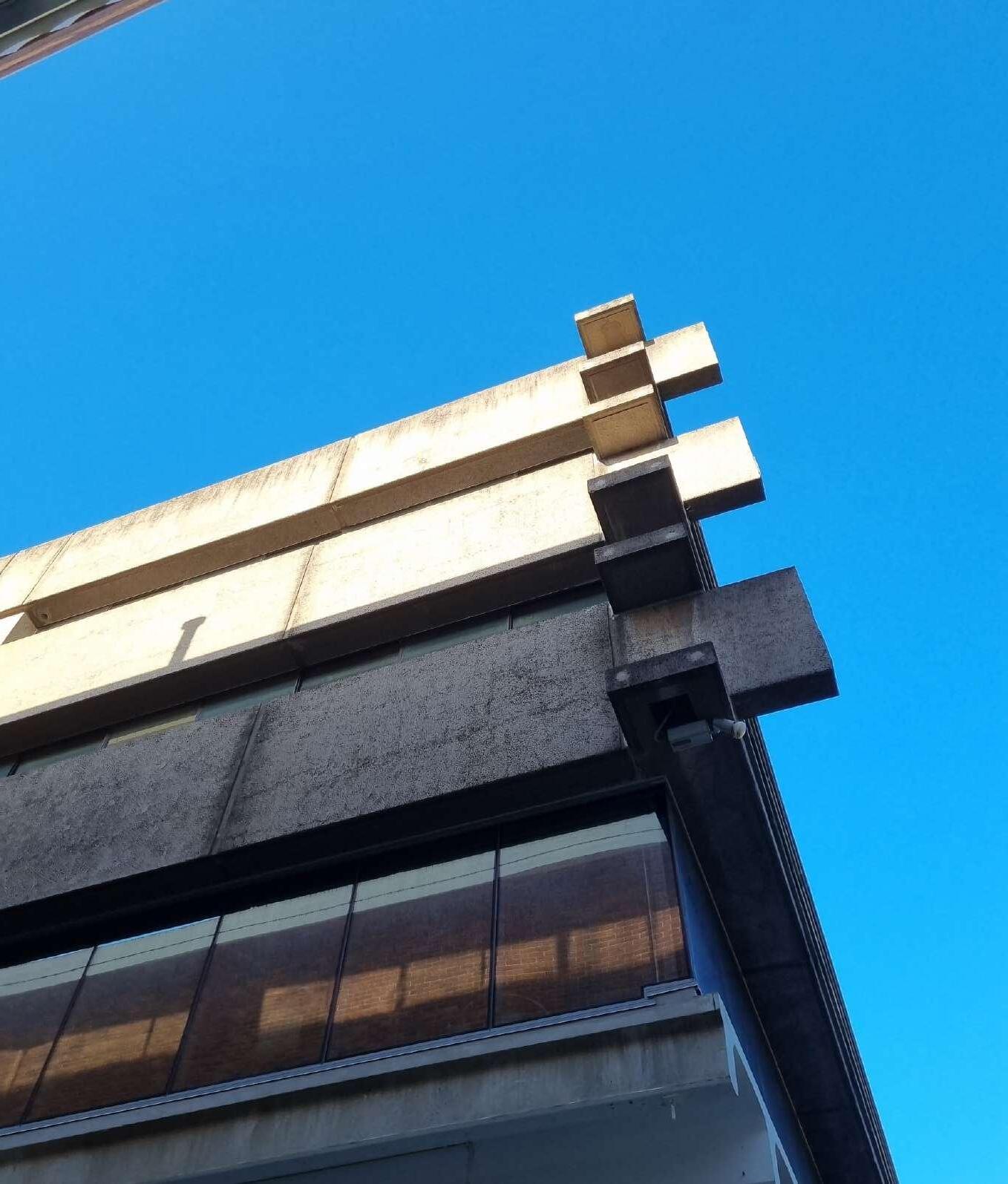
Nathan Pham

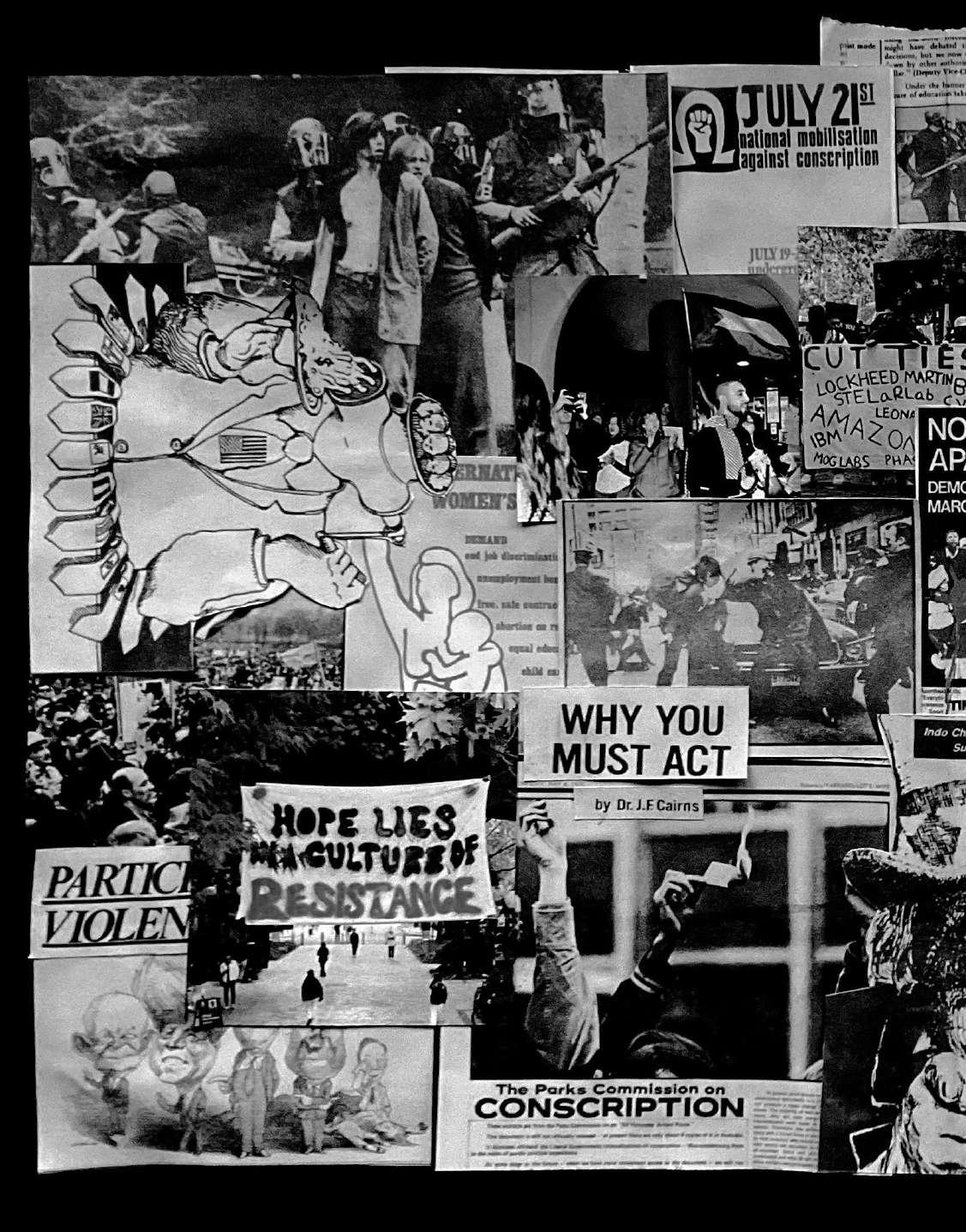


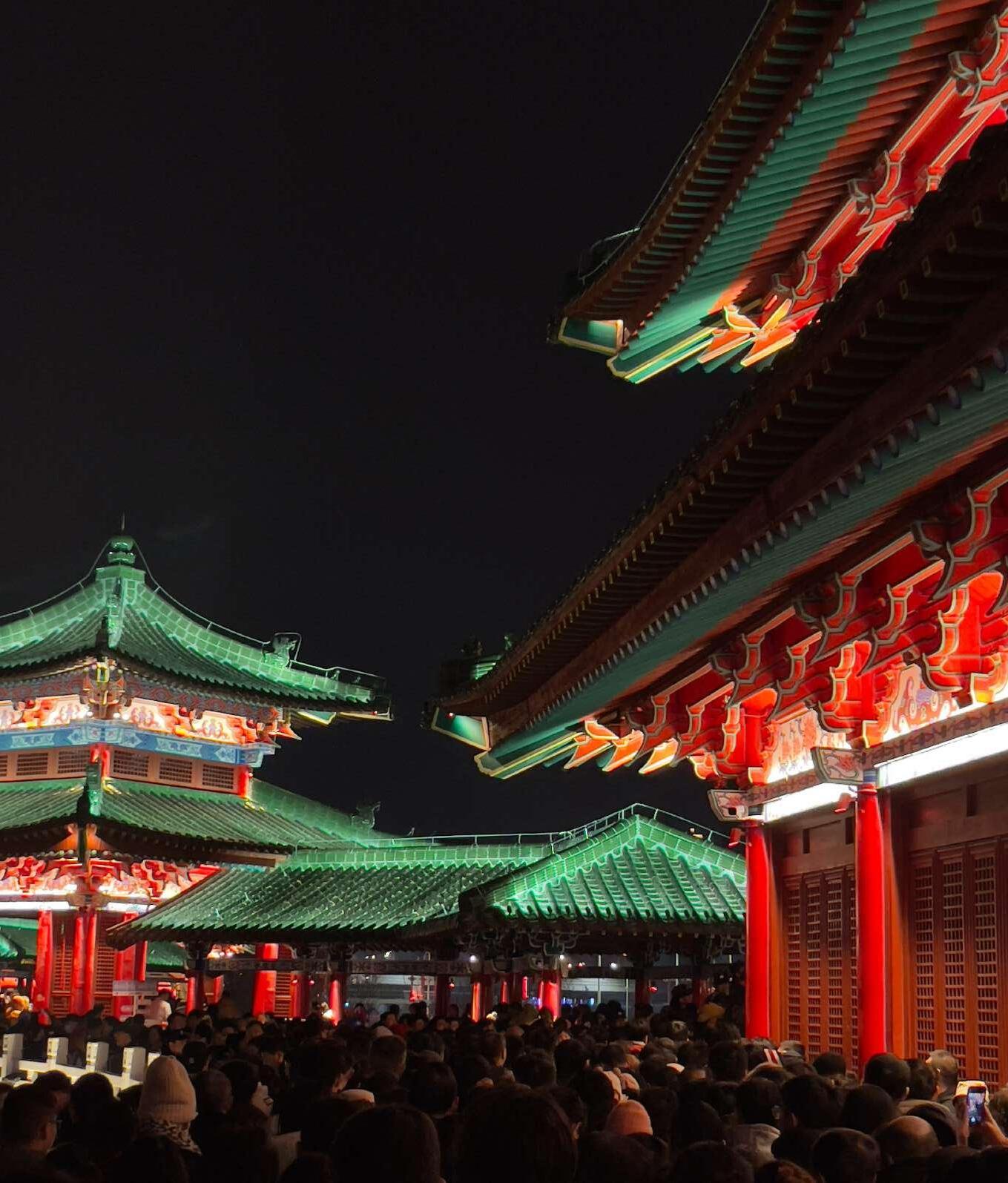
Designed by Chiaki Chng
FARRAROGUES GALLERY FARRAROGUES GALLERY
MEET THE NO-GOOD DANG-NASTY OUTLAWS RUNNING YOUR STUDENT MAGAZINE

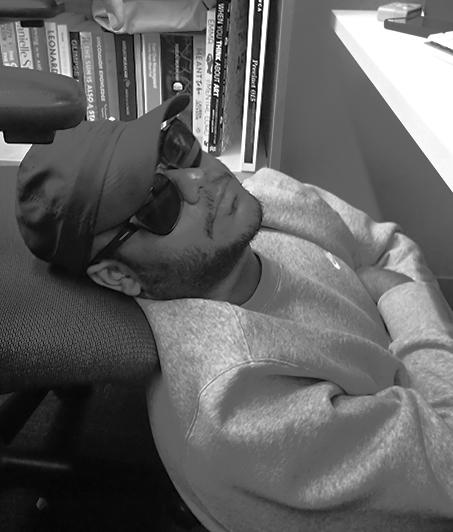
MATHILDA (Editor)
Alias: Hack Wrangler
Wanted for: Crimes against student journalism
Known hideout: Building 168 Reward: Double shot oat iced latte
MUAN (Editor)
Alias: Mr Moo
Wanted for: Basketball facts
Known hideout: Babel Building Reward: nut bag

SOPHIE (Editor)
Alias: Can o' Beans
Wanted for: Grand Theft Equine
Known hideout: Level 4 All Gender Bathroom (within Urinal) Reward: A Horse

MARCIE (Editor)
Alias: WanderinTrickstr
Wanted for: Selling bootleg Pokémon TCG plushies & games for profit (without an official licence)
Known hideout: Level 1 Ida
Bar - Farrago Archives
Reward: 1999 1st Edition
Holographic Charizard card
FARRAROGUES
FARRAROGUES

PAMELA (Archives)
Alias: The Goop
Wanted for: Psychological torture using supersonic meows
Known hideout: Mold infested Northcote sharehouses
Reward: 1 kg goop

TOM (Archives)
Alias: The Runner
Wanted for: Stealing your bread
Known hideout: Frankston
Reward: A fourth position at Farrago

MADELINE (Non-Fiction)
Alias: Maddie
Wanted for: Saying she'll definitely write a piece for the next edition as soon as things get less busy you guys
Known hideout: Op Shop
CD Section
Reward: Her Radio Fodder timeslot

MARIA (News + Design)
Alias: Freak
Wanted for: Crimes against the state
Known hideout: IDA Bar Reward: Ipad Mini & Apple Pencil

HALLIE (Creative)
Alias: Fair Verona
Wanted for: Assassinating an Abraham Lincoln impersonator
Known hideout: A tray table seat on the Ballarat VLine Reward: Exactly six Cadbury chocolate eggs

RUBY (Reviews)
Alias: Big Fan Wanted for: her Kind Regards
Known hideout: Still Unknown Reward: Nothing. We need to give her the money

LUCY (Social Media)
Alias: Lucying My Mind Wanted for: Heating up tuna pasta in a communal microwave
Known hideout: An overpriced cafe Reward: A poorly timed dad joke

ANGELA (Photography + Video)
Alias: Paddington
Wanted for: being a depop seller addict
Known hideout: an uninhabited Media Office Reward: a Hirono figurine

HAYLEY (Reviews)
Alias: Mama cat
Wanted for: crippling indecisiveness
Known hideout: in close vicinity to matcha powder
Reward: book package from UMSU info desk

CHIAKI (Social Media)
Alias: The Last Whisper Wanted for: Exsanguination, generic vampire activities
Known hideout: Wherever sells Soy Milk
Reward: Miffy pencil case and two mobile phones
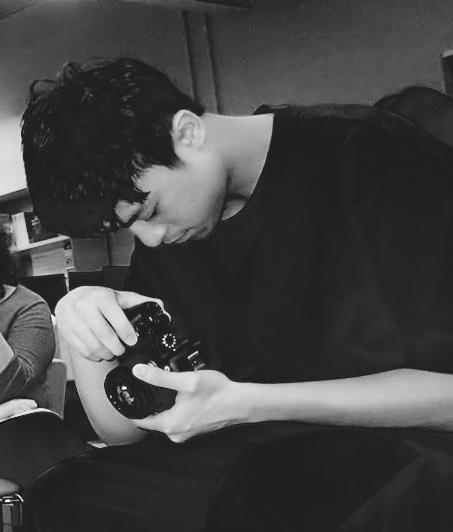
NATHAN (Photography + Video)
Alias: Personality Hire
Wanted for: Nationalism
Known hideout: the blank slot in a Fully Scheduled Google Calendar
Reward: Really Bitter Blood

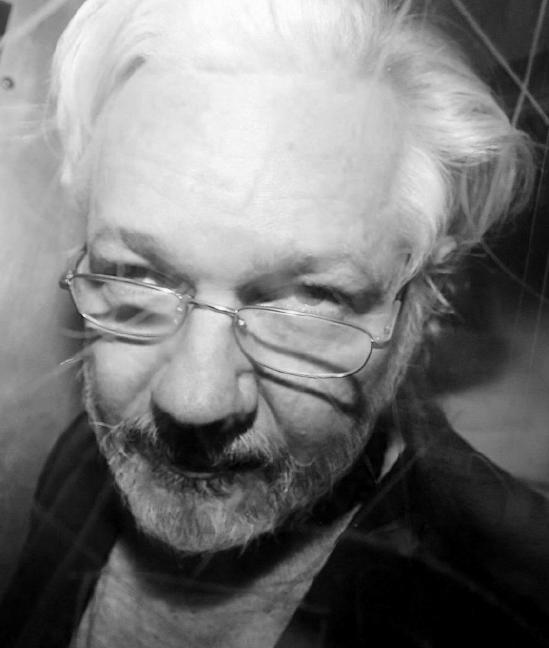



INFAMOUS ALUMNI! Unimelb’s best and brightest!
INFAMOUS ALUMNI! Unimelb’s best and brightest!
Head of Architecture at Yeezy, Bianca Censori graduated from Uni Melb with a Bachelors and Masters in Architecture. Her accolades have even afforded her a coveted spotlight among Kanye’s usual IG fare of Nazi dogwhistles. Happy birthday to the most beautiful super bad iconic muse inspirational talented artist masters degree in architecture 140 IQ… How romantic! Nothing quite stirs the loins like antisemitism!
2.
Head of Architecture at Yeezy, Bianca Censori graduated from Uni Melb with a Bachelors and Masters in Architecture. Her accolades have even afforded her a coveted spotlight among Kanye’s usual IG fare of Nazi dogwhistles. Happy birthday to the most beautiful super bad iconic muse inspirational talented artist masters degree in architecture 140 IQ… How romantic! Nothing quite stirs the loins like antisemitism!
inferior character.” While he may have objected to weaponds dealings, his moral rectitiude allegedly does not extend to matters of sexual consent.
inferior character.” While he may have objected to weaponds dealings, his moral rectitiude allegedly does not extend to matters of sexual consent.
loved Associate Professor of Political Philosophy Holly Lawford Smith. Nothing says Big Name on Campus like getting a special shoutout from Judith Butler.
Pascoe Vale’s resident CIA operative (and landlord) Peter Khalil graduated with degrees in law and arts in 1996. Prior to selling out to the US, Khalil was a small time tennis player, ranked at one point no. 25 in Australia. Perhaps taking inspiration from his party leader Albo, Khalil too has tracked the path from public housing to investment property ownership. Khalil has been the member for the seat of Wills since 2016, engaged in a long struggle to convince northside-residing students of his alma mater to stop voting for the pesky Greens Political Party. 1.
Melbourne ravehead and part time Ecuadorian Julian Assange dropped out of this esteemed establishment in the mid 2000s. While at uni, Assange was VP of the Mathematics and Statistics Society and organised their annual puzzle hunt. Assange was quickly disillusioned by the academy’s work for military and defence contractors at home and abroad, once describing a group of senior physicists as “snivelling fearful conformists of woefully
Melbourne ravehead and part time Ecuadorian Julian Assange dropped out of this esteemed establishment in the mid 2000s. While at uni, Assange was VP of the Mathematics and Statistics Society and organised their annual puzzle hunt. Assange was quickly disillusioned by the academy’s work for military and defence contractors at home and abroad, once describing a group of senior physicists as “snivelling fearful conformists of woefully
Former criminal barrister Nicola Gobbo / Lawyer X / Informer 3838 first came to police attention when her Rathdowne Street house was raided for $80,000 worth of methamphetamines in 1993. All in a day’s work for this law student, Farrago editor and unwitting police informant! Ever since her identity was revealed in 2018, Gobbo has lived in hiding overseas, fearing retribution from her past high-profile gangland clients.
Former criminal barrister Nicola Gobbo / Lawyer X / Informer 3838 first came to police attention when her Rathdowne Street house was raided for $80,000 worth of methamphetamines in 1993. All in a day’s work for this law student, Farrago editor and unwitting police informant! Ever since her identity was revealed in 2018, Gobbo has lived in hiding overseas, fearing retribution from her past high-profile gangland clients.
The University of Melbourne holds a special place in its heart for transphobes, or more specifically a special place in its payroll. Proud members of the UnimelbxTERF community include Germaine Geer (alumni), Sheila Jeffreys (staff), and currently the be-
The University of Melbourne holds a special place in its heart for transphobes, or more specifically a special place in its payroll. Proud members of the UnimelbxTERF community include Germaine Geer (alumni), Sheila Jeffreys (staff), and currently the be-
loved Associate Professor of Political Philosophy Holly Lawford Smith. Nothing says Big Name on Campus like getting a special shoutout from Judith Butler.
Pascoe Vale’s resident CIA operative (and landlord) Peter Khalil graduated with degrees in law and arts in 1996. Prior to selling out to the US, Khalil was a small time tennis player, ranked at one point no. 25 in Australia. Perhaps taking inspiration from his party leader Albo, Khalil too has tracked the path from public housing to investment property ownership. Khalil has been the member for the seat of Wills since 2016, engaged in a long struggle to convince northside-residing students of his alma mater to stop voting for the pesky Greens Political Party.
Mathilda Stewart
Mathilda Stewart

While students may be most familiar with academic sta , the University of Melbourne is maintained by countless workers who service, clean, patrol and administer its the infrastructure, allowing so many of us to learn and research.
I’m sitting at a table in a corner of Professor’s Walk Cafe, surrounded by the hum of students chatting and the hiss of the steam wand. Yo, an international student who has been an employee at the cafe for two years, sits right in front of me. His overall demeanour is calm, with relaxed shoulders and friendly eyes.
Professor’s Walk Cafe has always been a small yet vital hub of campus life. Conve-
the food we eat every day, that sta are fulfilling orders in an e cient manner and that customers are happy with the service they are provided.
Yo emphasises maintaining a positive work atmosphere for both sta and customers. “Attitude is number one here because it impacts the whole team. The work behind the counter goes beyond making co ee - baristas put care into every interaction and it makes all the di erence when customers reflect that back.
By virtue of being an employee at a
He notes that closer to Easter fewer students are around, yet around SWOTVAC “the library is packed” and ca eine orders increase in ‘crazy’ amounts with students ordering closer to 5pm. “Last year the Uni wanted us to open late since uni students stay late, so they wanted us to extend our hours.”, Yo expressed incredulity at the prospect of working for 11 hours.
Yo was also particularly impressed by the encampments he witnessed last year.
”This is my second year in Australia so far … it was crazy to me because I have never
WORKING PROGRESS

niently located next to the Baillieu Library, students and sta alike seek refuge within. However, at the heart of this hub, keeping this cafe running, are the sta members.
Yo begins his day at 7:30am, “I always come ten or five minutes early at least, I turn the co ee machine on, prep the sandwiches and the mu ns because we get new deliveries each day so it stays fresh.
During the day I do my orders from around 12 to 2 o’clock, so I am busy on my laptop. I then do my rostering, so I stay ahead and don’t get confused.”
He ensures the cafe is supplied with
popular spot on campus, Yo has access to a unique window into campus life.
“We have data and statistics and stu , because it impacts our ordering levels … I have to at least do it around how many customers that are going to be around the cafe.”
Yohannes, Barista
Zeinab Jishi and Mathilda Stewart
seen that before and how everyone was together and it was not chaotic, it was organised, people were doing it properly.’’
As an international student from Indonesia, Yo has at times struggled to make rent with the 24 hour cap on working. But after two years at Professor’s Walk, 17 April will be Yo’s last day.
Now that he has completed his diploma in hospitality, Yo has found work at a restaurant in Southbank as a cook. He hopes to “become a good chef and pursue [his] career in a commercial kitchen.”
Co ee culture in Melbourne is huge, and on campus, it’s even bigger. Without baristas and hospitality sta like Yo, campus life would be a lot di erent.

May 3rd
J,
Now that you’re back, it feels like even the stars are taking notice of me. They see the dead glowing centre of my stomach, emitting light to parallel their blinking. Unbroken, it feeds on your gaze and grows to fill the space below my bottom rung of ribs, warm and desperately hungry. Like classroom fluorescents brushing particle board walls, it’s a gnawing light you can’t look past, can you? Please don’t. Please keep looking. I worry sometimes that you don’t know what to do with me. Or you won’t.
Please keep looking.

Letters to Lovers (never sent)
Sabine Pentecost
L,
August30th
spearsIaminParisrightnowandImisstheorangelightofyourlivingroomsending overtheroadandthroughmyvenetianshutters.Themanlivingacross glassthestreetfrommehereismeanandeverynight,fromhisbalcony,hethrows bottlesintotheskipbelow.Thesprayofdrunkenmisthrowssometimes overreachmysideofthestreet.Inthemorning,childreninschoolshoescrunch thebrokenshards.Thesharpclockworkofeverydaylife. haveIalwaysthinkaboutyouinthemornings,wonderingifyourtartanslippers warmdisintegrated,succumbingtothemoths,sinceIlastspentthenight.Isit enoughforyoutositonthebalconyandreadyet?Ihopeyou’rewateringmyfiddle-leaffig(I’mpicturingyoureyeswideningatthissentence,an myexclamationof“ohshit”escapingyourlips).Ican’thelpbuthopeyou’vekilled plants,soIcanhateyouforabit.



B,Iwanttotell mychestand ingsacred. face,and



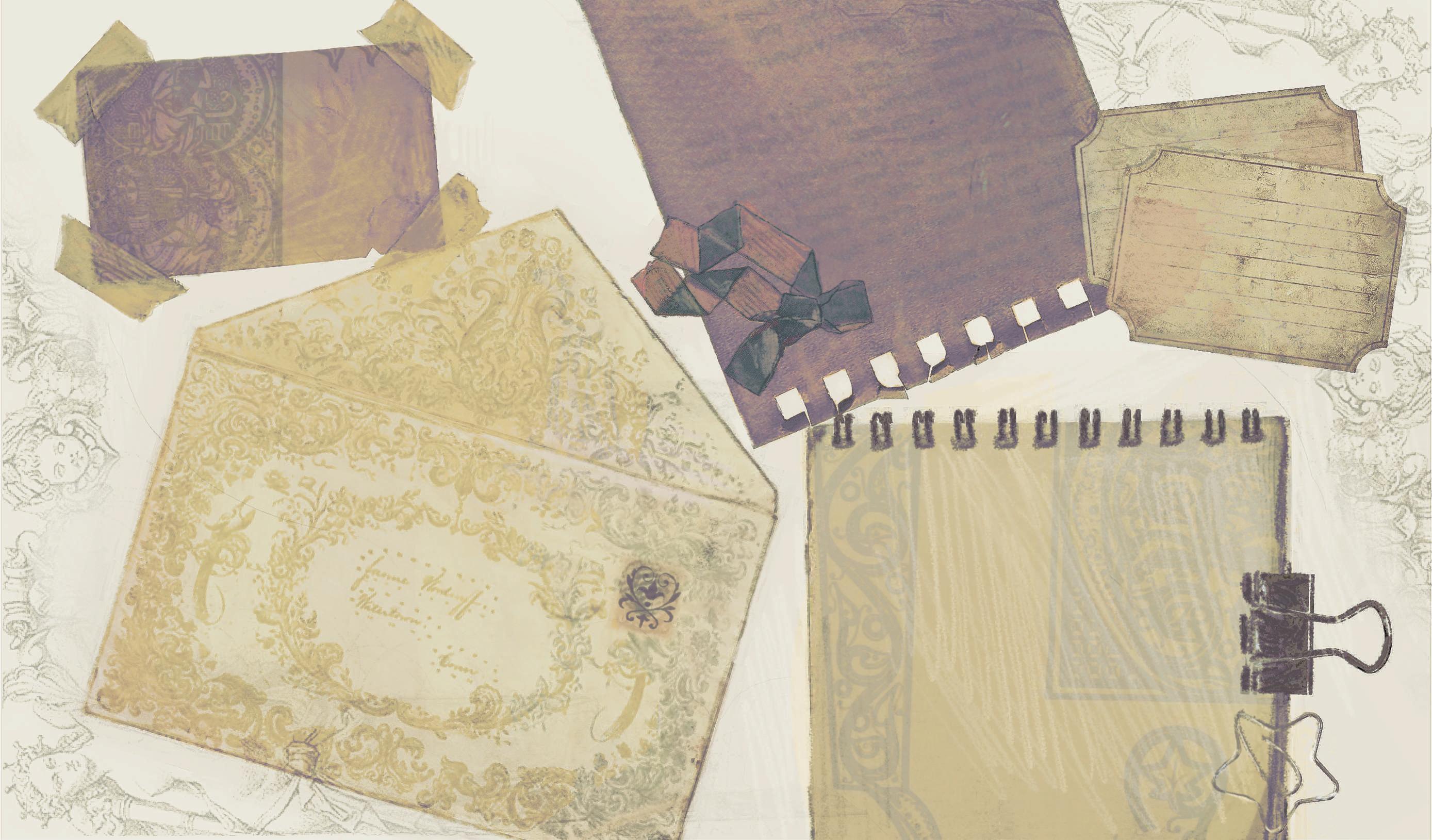
June18th tellyoueverysinglethingaboutmyself.Iwanttoripopen andletyoureadtheslipperyredscrawl likerunes,nothsacred.Whenyoudo,youwilllookatmewiththatawe-stricken andIwillbelieveIcanalwayssurpriseyou.You,alwayssoquicktokindness.AsifeverythingIdoischangingtheworld,leavinga mark.Eyestellingmethateveryoneshouldbe noticingmeandyou’reluckyenoughtobethe onlyonewatchingsointently.


E,
September 24th
The weeks convey their painful passing, weather getting warmer, storms spacing out. The mother blackbird has disappeared from the upstairs window box. There are still baby birds nesting inside the chimney so that Spring echoes through my empty bedroom. I find myself singing to them. I miss you.
November 2nd
R,
I am looking out at the street and it is eight in the morning and the postman is opening the gate to deliver the Saturday letters. Saturday is the worst time of week because in two hours the market will open and I will put on my hat and my shoes and my glasses to pick up the bread and the butter and the fresh fruit (apricots at this time of year), but I will be alone. Seemingly, Saturday was your day because still you drip and drape from it like liquid silk, expanding to fit the container of my spring solitude. Come back and I promise you can have all the sweetest apricots; we can pick out fish together and leave our sensible shoes by the front door for Sunday morning.






Incubi
Fergus Sinnott
Content Warning: Sexual References
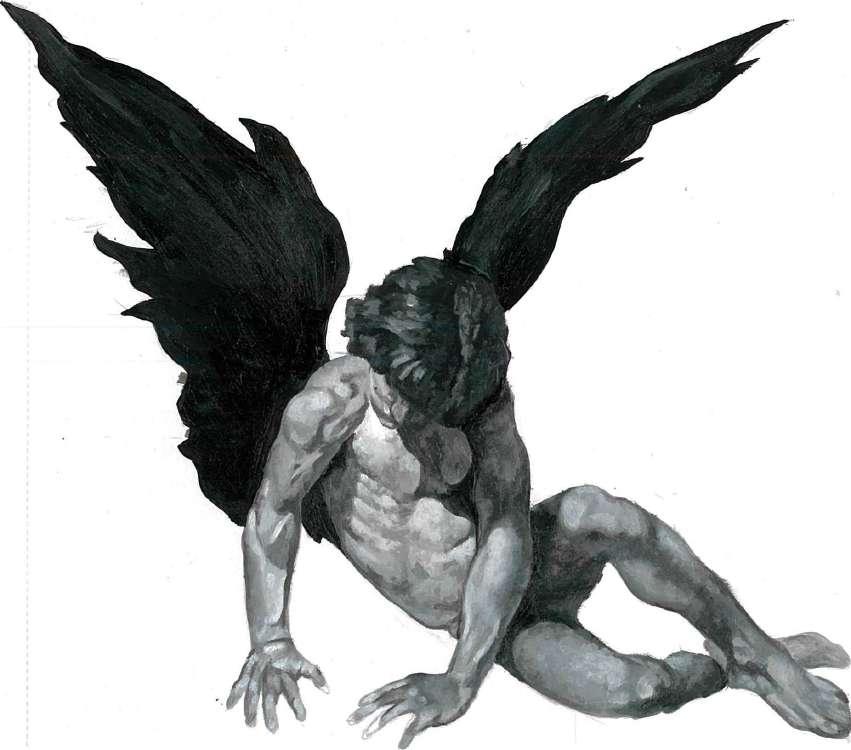
They stand out in front of picture houses in the evening. They are underneath the streetlights, behind the dumpsters in the alleyways. One or two have been known to wait on the steps of parliament buildings, or on top of the copper-plated statues in the park. If you are looking for one, you may be able to find one. If you do not wish to come upon one, but someone, somewhere knows you need one, there it will be, appearing before you as you are walking home, as you are stepping off the train, coming up out of the underground terminal. They wear long black cloaks into which their wings can be easily folded. You will never be lucky enough to catch one in flight, given how easily they can be mistaken for birds or low-flying planes. Their diet consists solely of apples and lemon squares. They drink, too. They drink plenty. They are all discernibly male, with hair coming down to their shoulders. They are beautiful, disarming, in a way that might appear to be vaguely threatening at first. It is not uncommon to find that, as one steps out of the shadows and raises a hand in greeting, your first impulse is to reach for your keys or clutch at your bag. But, contrary to popular belief, they are entirely innocuous. They only want to help, really. They understand exactly what you’re going through. They might’ve even been there to
see it as it happened, watching over you, standing by.
Before they follow you home, they will, of course, ask for your consent. You will be free to withdraw this consent at any moment; they will not be offended. If you do feel so inclined to invite them to walk home with you, to sit next to you for the last two stops on the city bus, they will walk in tandem with you or sit beside you in silence while you read or tap away on your phone. It is easy for mythology and folklore to override the real, for the natural inclination toward fear to take precedence over the possibility of true goodwill. This is understandable, but it is also not always the case. You would do well to live a little, to take pleasure in what few joys life is willing to offer you. Desire is ubiquitous and egalitarian. Each of us state our individual case to it, and each of us is given a fair hearing. They understand this. This is what they are here for. They will take their shoes off at the door without being asked. They will nod politely, genially. They will, in their low, husky tones, suggest that you slip into something more comfortable: not with regards to clothing but to space, and to time. They will ask you to moor yourself in a pleasant memory, to figuratively reach back towards the spectres of the past and pull them towards you. This will help to circumvent any of the prejudices,
readily adopted or otherwise, to which you might be privy at the beginning of your engagement.
Very little can be said about the act itself. Each respective encounter is unique in its valence, in their matching of themselves to the rhythms and contours of your body. What has indeed been said to be universal about the act is that it is singular, novel, incomparable. It is marked by the fact that words are unable to fully account for it. Suffice to say that they are adept at engendering a centripetal spiral towards a new nexus of pleasure. Upon the point of climax, there in the hermetically sealed chamber of the bedroom, you will be overcome by the indelible sense that the world has been thrown off course, disassociated from its former self. What can also be said about the act is that it can only ever happen once. No report has ever been given of such an encounter more than once, in the same way that lightning very rarely ever strikes the same place twice and is gone before we fully perceive it even having been there at all.
Contrary to popular belief, the aftermath of such an encounter is never attendant upon any sense of guilt or remorse. Instead, the fact of the encounter eventually comes to be marked by a sense of joy and indissoluble pleasure. It becomes a secret that one keeps to themselves, a memory whose power is
derived from the fact no trace of it is borne upon the body, that it remains only within the mind, who was privileged enough to interpret the sensations of the experience itself. What does Schopenhauer say—that man can do what he wills, but cannot will what he wills? This is true in many ways, but especially applicable here.
In the days afterwards, you may also experience a certain capacity to tune in to new proprioceptive frequencies. For example, those who have been forced into the proximity of someone on the train have noted their ability to experience the grievances in the lives of this stranger, as if suddenly riding on a wave of foreign, unlocatable discontent. If not the train, then in the office building, or between people in cars travelling on opposite sides of two-way streets. There will be a sense of the bonds between you and your loved ones having been renewed, rejuvenated, the well of mutual empathy and compassion restored. Because, of course, Incubi are powerful. Incubi are overpowering. They are above us, below us, before us. There is not a shadow they do not dance in. There is not a door under which they cannot slip, not a window out of which they cannot climb, back into the night as the world resumes. Its spinning, slowly growing dizzy from the sheer, implacable excitement of it all.
She Came Knocking on a Random Tuesday
Jayden Alexander
I’min the midst of tossing and turning in bed, too lazy to get up, when incessant thuds force me out of my comforts. Sluggishly, I pull myself out from under the snugly arranged covers and head to the door. Peeking through the peephole, I see the familiar stature of a woman. I blink twice, rubbing my eyes to make sure it isn’t a lethargic hallucination. How is she here? As she reaches up to rap on the door again, I swing it open, face to face with the hunched woman, the wrinkles on her face scrunching as she smiles up at me.
‘你长高了,’ she says, her eyes scanning me up and down.
She nods in approval at the man I’ve become, though my dark eye circles, bedhead and mismatched pajamas feel like quite the contradiction.
She moves past me, her magenta cotton shirt brushing against my arm as she enters. Her hands cradle a thermal flask. She glides through my home as though it’s hers, bringing out two cups and filling them with her homemade longan tea.
‘你还好吗?还在读书啊?’ she gestures at a chair and I sit down, still confused by her arrival.
‘还好.’ I take a sip of the tea, the familiar, light sweetness enveloping my mouth in a warm hug. ‘好喝’. I shoot her a smile, my eyes softening at the sight of her greying hair and trembling hands as she
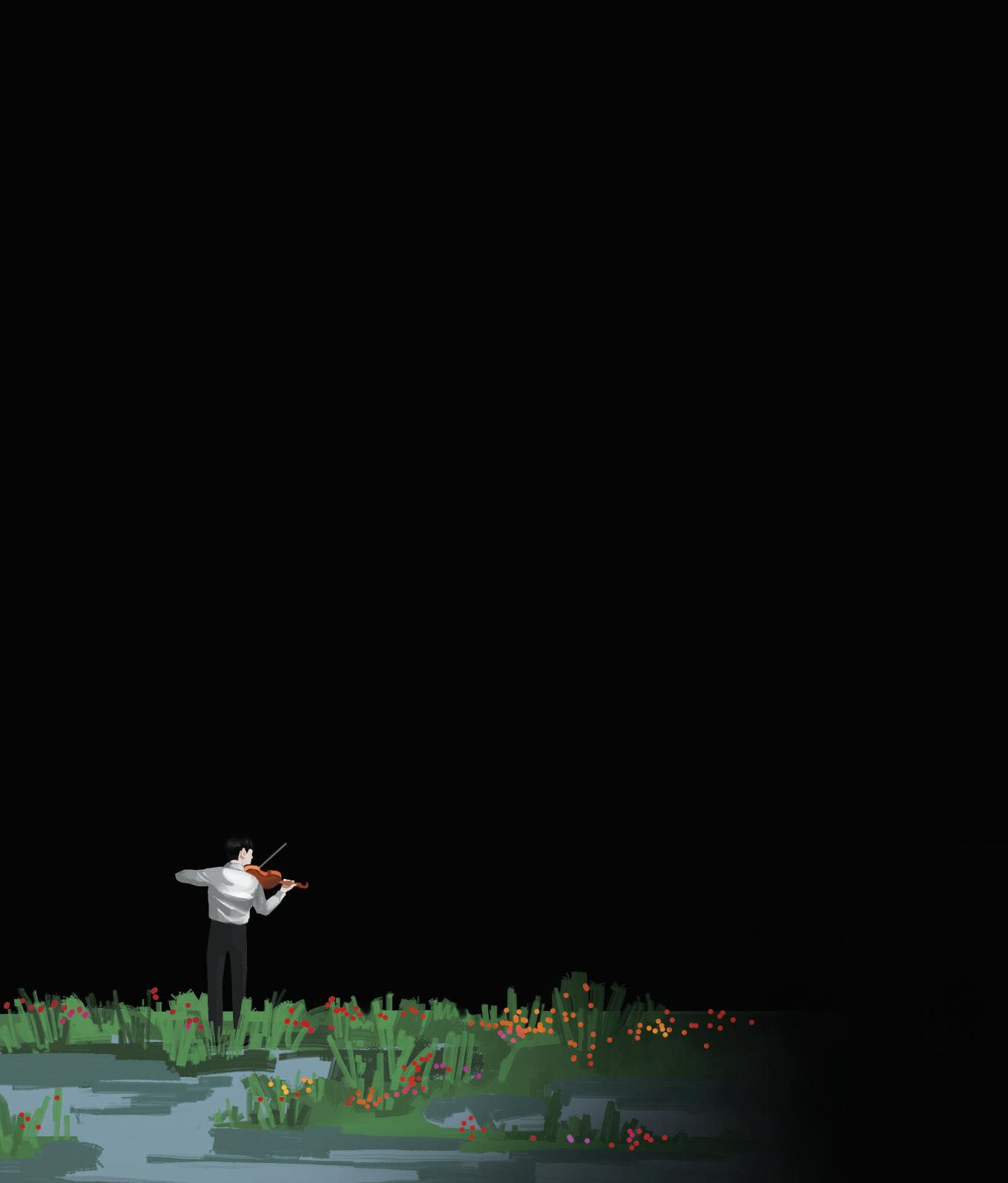
takes sips from the cup. ‘你来是为了 ’
She smiles. ‘我想听那首歌.’
It’s been years since I last picked up the violin, but how could I say no? I retrieve the instrument from my room and begin to play, my fingers moving deftly as if no time has passed. The notes string themselves into the beautiful melody I know as her favourite song. I see her nodding gently, a smile adorning her face. My body relaxes into the rhythm, and I close my eyes. I play the last notes of the song, then let the silence simmer in the room before lifting my head to look at her, only to find her gone. The two cups of halfdrunk tea rest on the tabletop.
In her place sits an equally old man, his hair as pale as the white singlet he is wearing. I do not recognise him, though I feel an odd sense of familiarity. He speaks—gently, softly—in a language foreign to me, but I recognise it as Hainanese. In spite of my inability to speak the language, I have an innate comprehension of it. He moves to the balcony, where a stone charcoal stove balances on two red bricks. A wooden stool sits dangerously close to the fire. He squats down on the stool, brings out a straw fan and begins to fan the flames. On top of the stove sits a clay pot, the bottom burnt black from use. Bubbles emerge and burst on the surface of the white freckled landscape, and bits of carrot and fish bob up from the congee.
The smoky charcoal merges with the starchy steam of the congee; the smell reminiscent of a childhood I had long forgotten.
The man turns, gesturing for me to
come over. He hands me the fan and points at the clay pot, mimicking a fanning action with his hands. I take over his spot on the stool, coughing as the charred smoke enters my lungs. A hearty laugh erupts behind me, and I turn to smile at the man, whose hands are now behind his back—the picture of the Asian grandfather stereotype. I turn back to continue fanning the flames. Orange sparks flare up from the greying charcoal. I feel a reassuring hand on my shoulder, a few light squeezes of encouragement before his hand lifts.
I turn, this time ready to see a new face. I was unprepared to be met at eye level with a small boy in a bowl cut—the spitting image of a younger me. He’s dressed in a loose-fitting t-shirt and shorts. His muddy shoes leave marks as he rocks back and forth on the tiled ground. He holds an equally muddy football; blades of grass cling onto it firmly.
‘Will you play with me?’ he asks, tilting his head slightly.
‘I don’t know how.’
‘You’ll learn.’ He shoots me a cheeky smile before turning and dashing back into the apartment, running towards the exit.
‘Come on! Come on! The sun’s gonna set soon!’ The boy stomps, blissfully unaware of the mud staining the lacquered wood floor.
I speed up my walking, hoping that my longer strides will be able to keep up with his seemingly endless boyish energy. He swerves adeptly out of the apartment, finding the exit the way sunflowers find sunlight. The red blur of his t-shirt is the only thing I can see as I try to keep up
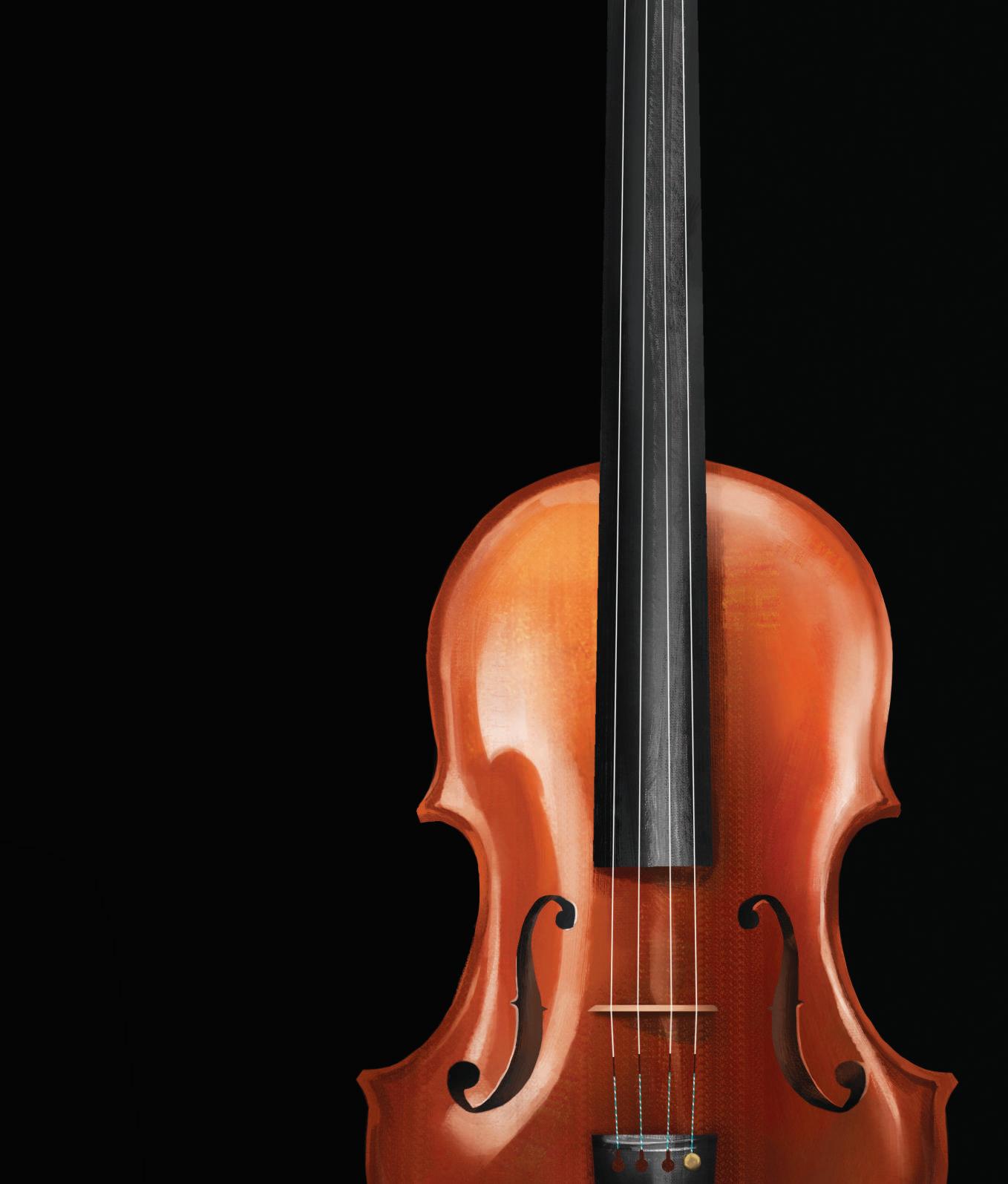
with him. He dashes across the street to the grassy fields as I follow behind. My feet hit the wet grass, droplets of dew springing up to meet them, tickling my calves and providing a cooling sensation as I chase after the boy. He does a few football drills, his familiarity with the ball filling me with awe and admiration. He kicks the ball over to me, and I scramble to stop the ball, nearly tripping in the process.
‘What do I do with this?’ I look down at the ball under my foot.
‘Pass it back!’ He shouts from across the field.
I awkwardly aim the ball in his general direction and give myself a running start before I kick it to him with full force. It barely makes it to him, the ball gaining some speed before being bogged down by grass and mud.
‘Sorry!’ I yell, slightly embarrassed by my attempt.
He gives me a thumbs up from across the field, rolling the ball under his foot before kicking it back to me. And back and forth we go until the sun goes down, the cooling sensation of dew now replaced by sticky, damp sweat. I squat down to take a breather; the physical exertion has clearly taken a toll on me. I hear the rustling of grass as he jogs over.
‘The sun’s gone down, I’ve got to get going soon.’
‘Will we play again?’
He smiles. ‘Maybe,’ his voice blends into my grandmother’s, ‘on a random Tuesday.’
Innocent Omen
Nadine Reichardt
A sparrow flutters at dawn, its wings as frail as the whispers of first light. It lands on the edge of the windowsill, its eyes glinting like dew on untouched grass.
The world feels slow, as though the clock hesitates to tick, the air heavy with the sweetness of blooming jasmine and yesterday’s rain.
Its beak taps the glass— a sound so light it feels imagined, a gentle plea, a secret too shy to be spoken aloud.
And for a moment, the sky swirls in soft pastels, the kind of hues that only linger on the edges of a child’s dream.
Somewhere, an omen stirs, but it is not in the sparrow. It is in the stillness that wraps the room, in the way the sunlight folds itself across the unmade bed, a golden echo of what could be, of what is yet to come.
And you, barefoot and blinking, hold the fragile morning as though it might shatter if you breathe too hard.
The sparrow lifts, its wings catching the weight of the day. And as it vanishes into the endless blue, you wonder if innocence is the only omen you’ll ever truly understand.

I Watch Pink Flamingos Alone and Think About How Much I Love You
Aaron Agostini

with a lonesome sentence, I come undone: art doesn’t have to be sad. it doesn’t.
but I think good art comes from something that pulls.
I am very sad, Ryan. as sad as you are to hear it. therefore, I can make something real. I can be happy.
you tell me— you shouldn’t make yourself sad to make better art. I tell you—
I can’t make myself happy.
happiness, I think, is actually quite simple. maybe that’s why I can never seem to figure it out.
misery is a long emotion, it’s a receipt,
the way a single peach can be so intimate, kind, like seeing someone’s handwriting for the first time.
your handwriting is small, tender. like the light above the stove as I watch you amble from window to window, watching the rain.
I love you so much. it’s a cool summer evening, 5:13 pm, January 30th. we are 24. the year is 25.
your shoulders, a bridge over bad days. your eyes, not a place to be lost— but a map. I am finding myself.
I keep this to myself. I write. I can make something real.
Utopia
Liliana Greyf
What is forbidden in utopia? Days of the week, forbidden. Distinction between week and weekend. Distinction between rest and play, between play and work, between work and rest. Distinction between girl and boy. Distinction between green and pink. Email is forbidden in utopia. Because of course the screen does not exist. Though written communication is encouraged. Written communication remains a primary mode of communication. Nice to know we got that one right. Looking directly at the light until a painful sort of halo the colour of light appears around it, that is not forbidden. Looking at the moon, not forbidden either. Cereal, perhaps forbidden. Cereal boxes surely forbidden. Grilled cheese, allowed. Grilled cheese with lentil soup, yes, and untidy nailbeds. Though reading remains a possibility there is no desire to read. Or rather all desire is the desire to read, and all desire is fulfilled at the moment of its conception, or just soon enough that the desire remains in the belly, growing like a watermelon, not leaking like a trickle or stream into the legs or anywhere else. Or perhaps desire is forbidden. Distinction between inside and outside, forbidden. A smoke? Is a smoke to be forbidden? No, it couldn’t be, this smoke in T’s hand, sitting here now in front of me, T in their face and hands, grinning at me after they blow the smoke at me in my face, my stupid face giddy looking at them. T appears in the utopia just like that, holding the smoke and laughing.
Afterimage (a love archive)
Isaac Thatcher
Here are the roots of it: frayed wires in my wrists. Deep under calloused skin I found them, right where the nerves should have been.
‘Til now I’d only felt my blood buzz. You don’t feel each shock when wire teeth burn you all over. So when I pull them out, one-by-one, they sting hard.
Sun-blinded into overexposure, electric-blue faces stain walls a blink over white nothing, the same place you’ll also return to. Strange, what works its way below skin. You only learn you’re man-made

with the membrane shorn.
Less afraid these days now I’ve seen what’s beneath I duct-tape tassel ends to tame them. When feeling comes I polish copper ‘til it shines, current channelled down my fingertips so it all comes oozing out.
I gaze soft at each blue, let it burn low then put polished coils to rest. I can look at them, now I tend these afterimages—my archive in daylight and dark.
My Stress is Yellow and Red
Alouise Thompson
Stress is a bright yellow bitter virus and it’s seeping itself into my veins. It’s hot and comes with a warning label. Starting as a chaos of the mind, inhabiting itself in spirit and flooding. Organs twist then turn, shrivel then punch. From written word between brain crevices, its power makes it physical. Until.
Until the world stops spinning and the days become pools and the big red button is a click of a finger. Like a friend, stress will invite you out for coffee. Like a lover, it’ll embrace your inner thigh. And then it is you and you are it and you are stress. Once, I pressed the fast forward button on a TV remote and it stood stuck.
And I think I became that remote. To live was to push was to move was to balance. Until.
Until I toppled. And the battery acid contents of a stress-filled life bled into everything and all things. My breath is red.
Dialogue
Liliana Greyf
G came over after their date to help can the apricot jam. I asked where had they gone. Have you heard of Place? they said. Place? I said. No, I said, I don’t know a place. The one with the hats, G said. The person named Place, with the hats. I don’t know the person named Place, I told them. Place turned out to have been the date’s roommate. Place wasn’t home. Place had named himself Place as a placeholder, a shortened Placeholder. Place had been unsure of what to name himself and so put Place there as a holder. Then he realized that a person is a place? I asked. That his person is a Place? Yes. Place was on his way home from another heartbreak, so said the date. It was a nice date, but still G came home early to sit by the kitchen counter and talk to me. The fruit turned to candy.
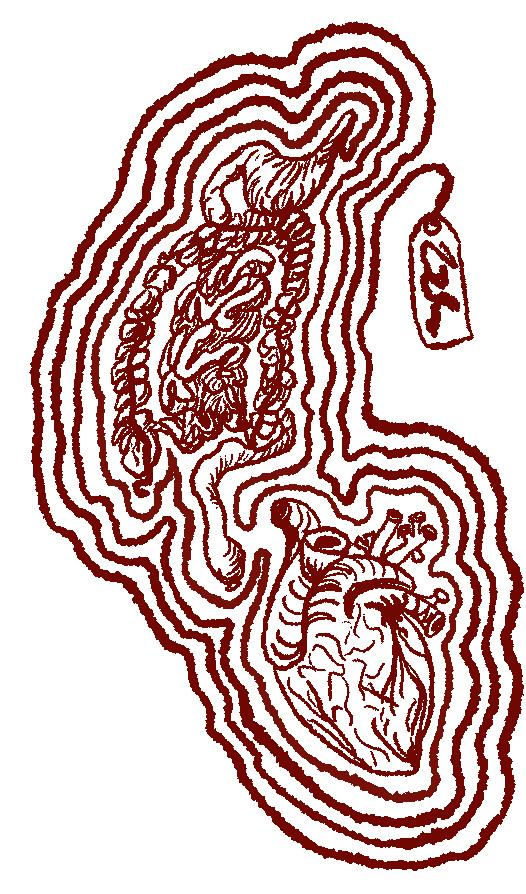
During Summerfest, the Farrago stall played host to a two sentence horror story competition. We received an incredible variety of spooky stories, but one stood out from all the rest …
Nightmare
Kelly Ly
The best way I’ve learnt to get rid of bad dreams is first recognise that you are dreaming, then close your eyes and stand still until your mind has nothing to do except wake up. Remember, none of it is real—even if your ‘friends’ beg you to run or to just look at them—it’s not real.
Wildflower
Hallie Vermeend
Content Warning: Death
INT. HOSPITAL ER - NIGHT
Black. The beeping of a heart rate monitor. The muffled voices of doctors fighting to save a life. Sound builds.
FLASHBACK – INT. BACK SEAT OF CAR – EARLIER THAT NIGHT
An indie rock song plays softly. The tiniest sliver of light illuminates the faces of MICHAEL (22) and SAMANTHA (21), her head rests on his shoulder, eyes closed. Next to several discarded candy wrappers, they bounce up and down with the uneven road as BEAU (21) struggles with the steering wheel.
BEAU (muttering)
Fucking council bastards ...
Michael chuckles softly. He leans towards the driver’s seat, giving Beau a friendly pat on the shoulder.
MICHAEL
You want to get us home any time soon, bud?
The car passes by another on the road, its headlights illuminating the inside of the car just long enough to see that the three friends are wearing Halloween costumes. Samantha has cat ears, Michael wears a cowboy vest and Beau dons a pair of FLUFFY ANGEL WINGS.
INT. HOSPITAL ER - NIGHT (BACK TO PRESENT)
Harsh lights. Fast, mechanical beeping. A surgical lamp is rolled away. Michael’s lifeless body is shocked with a defibrillator.
FLASHBACK – INT. BEAU’S CAR –EARLIER THAT NIGHT
Beau turns in his seat. A large truck appears ahead.
BEAU
It’s not even midnight! What ever happened to our good old fashioned Halloween shenanigans?
INT. HOSPITAL ER - NIGHT (BACK TO PRESENT)
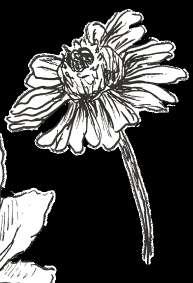
A DOCTOR performs CPR on Samantha. Beau sobs as he looks on from the last bed, scratched and bruised but still breathing.
FLASHBACK – INT. BEAU’S CAR –EARLIER THAT NIGHT
MICHAEL
Hey, HEY!
Beau swerves the wrong way, into the oncoming truck. He locks eyes with the driver, TOM (51). They collide brutally.
INT. HOSPITAL ROOM - NEXT MORNING (BACK TO PRESENT)
Silence. Beau’s angel wings sit on a chair across the room. His eyes flutter open. He scratches at his face, brushing a patched up gash on his cheek. Wincing, he sits up in bed. The delicate voice of LINSEY (221, looks 16) startles him.
LINSEY (O.S.)
Believe it or not, that kind of stuff still hurts here.
She appears kneeling next to the angel wings, touching the feathers softly. Her skin has a surreal glow, and she wears a white, regency era dress.
Beau eyes her warily, then takes a shaky breath and slips out of bed, not noticing that his pale form has left his physical body still comatose under the sheets.
BEAU
They didn’t...my friends--Oh, GOD!
He sees his body. Beau scrambles away from the bed, nearly knocking over a vase of wildflowers on the bedside table. Linsey steps towards him.
BEAU
I don’t believe in ghosts. Am I a ghost? Did Michael and Samantha--
LINSEY
No. I’m sorry, your friends didn’t make it. But you still have the chance. I’m here to guide you back.
Beau seethes at this.
BEAU
You want to take me back? To life? After what I just did?
LINSEY (cautiously) Beau, take my hand?
BEAU
I’m not going back! I...I did this. Let me die, and bring them back. Please.
LINSEY
I wish I could, I really-BEAU PLEASE!
Shocked, Linsey steps backwards. Beau holds up his hands.
BEAU I’m sorry.
LINSEY ... No, it’s alright.

LINSEY
The people I work for now...Well, it’s complicated. They choose who goes where after you die.
BEAU Where am I going?
LINSEY
You’re not going anywhere except back to life.
Beau begins to protest. Linsey touches his shoulder gently.
LINSEY
Alright, alright. The Bureau wants to send this man downstairs. If you can help me
prove that he is good--
BEAU
You’ll let me trade places with my friends? Linsey bites her lip. She nods.
Read the rest of Wildflower at farragomagazine.com
When I First Saw You
Content Warning: Explicit sexual content, sexual violence, rape culture
‘Let’s head to my place,’ Josie said, throwing her curls casually over her shoulder, still swaying from the cider. James watched her walk ahead without waiting for him or his reply, wading deeper into the shade of the cobblestone laneway. He followed her, keeping his hands firmly in his pockets. The sun above lingered, even as the heat of the day backed off, leaving the sky stained tangerine. Josie hadn’t phrased it as a question, but then again, she knew his answer. He could see it written in the swivel of her hips. Even as his chest fizzed with anticipation, he resented her certainty—the bitter implication that she was an offer he couldn’t refuse.
Not that he had a choice. Obviously. The last time he’d made it to a girl’s house he’d been dared to kiss her on the trampoline. It was the kind of party that still featured ice-cream cake and lolly bags, all politely handed out by someone’s overly perfumed mother.
His first date with Josie had taken place over coffee, hers poured into a keepcup, his into paper, which he justified at length, citing sources he made up off the top of his head. You’re right, she shrugged, I’ve probably lost and replaced this thing six times. Not very environmentally friendly. Balancing drinks and conversation over a wobbly table, James expected to trip over
some invisible line and never hear from her again. But that night, a speech bubble appeared next to her name—his whole heart hinged on three dots of thinking.
Josie spun around to face him in the middle of the street. ‘This is it,’ she said, extending her hand with a flourish.
The red brick unit was guarded by two girls lounging on a beat-up couch, dumped like rubbish on the front porch, as if the council had never arrived to pick it up from the side of the road. Josie’s housemates. Or friends. Perhaps a fragile alliance somewhere between the two, with shared spoons in ice-cream and fights over dirty dishes. As Josie swung open the iron gate, her fingers brushed his forearm, making the fine hairs stand stiff, as if suffering an electric shock. Her housemate-friends barely bothered with a glance in his direction. This wasn’t routine for him, this crackling static in the air between where his body ended, and Josie’s began. Was this routine for her? How many other boys had been ushered through this gate?
The brunette with the fuzzy fringe looked up from her book, a vaguely academic title she was reading with pen in hand. Her head was nestled in her friend’s lap, her bare feet propped up on the arm of the couch. ‘Watch your step,’ she said without losing her place on the page. ‘He’s been at it again.’
‘Doorstep this time,’ the strawberry

blonde one said, sipping her water bottle, red wine rushing through the plastic straw like blood in an IV line.
‘Ew,’ Josie said, scrunching her nose with a kind of thrilled disgust, rushing in for a closer look. A pale condom lay limp on the doorstep, like a dead bird left by a cat as a gesture of good will. ‘Has anyone responded to our post on the community page?’
‘Yes and no,’ the brunette said, dogearing her page and closing the book. ‘Tons of people reckon it’s feral, but nothing substantial as far as clues go.’
The girls argued amongst themselves, debating the identity of the condom culprit. Still yet to be introduced, James was stuck loitering, his hand gripping the hip-height gate, standing on the margins of their conversation. The girl with the book suspected it was local Grammar boys egging each other on for a fucked up dare or some kind of hazing ritual—she’d just read an article about it. It’s not a one off, the other girl said, tapping her friend on the shoulder to free her legs, which she soon clutched to her chest. It struck her as a sexual obsession, she said, clawing at her water bottle with nervous nails, some pervert who was probably peering through our windows at night. She had a pinched way of talking, pulling the words out from the panicked pit of her stomach like a never-ending handkerchief, as if a condom on the doorstep was proof that they would all end up hacked to bits in black rubbish
Elle Harkaway explores the boundaries of consent alongside toxic masculinity’s driving forces in this psychological thriller
driver I hit.
bags. With a hushed tone, as if afraid the culprit might overhear her, she asked her friends if they should report it. The brunette reached for her hand, stroking it with her thumb.
‘What are the police gonna do?’ Josie laughed, leaning back against the post, ‘Arrest everyone with a working dick and an open packet of condoms?’ Turning to James, she finally acknowledged his existence. ‘What would you do if someone was leaving condoms on your doorstep?’
‘I don’t know,’ James said, stumped, ‘never really thought about it.’
‘See, this is the problem with men,’ the brunette said, flicking her wrist dismissively. ‘He can’t even summon the empathy to imagine it happening to him.’
James bit back the urge to tell her to fuck off. This girl didn’t even know his name, but it didn’t stop her from assuming she knew everything about him. He knew her type. She was the kind of girl who liked to punish every man she met, because it made her feel uniquely oppressed to be a woman rather than just pretty, white and privately educated.
‘To be fair,’ Josie said, coming down the steps to stand beside him, ‘I didn’t really think about it happening ‘til it happened to me either.’
James let go of the breath burning inside his chest, feeling absurdly grateful. Josie knew how to laugh it off, with a hand on her hip. He could still salvage this. But, like a vampire, he couldn’t pass through her door without permission. If he gave them a convincing enough reason, they would have to invite him in.
‘Have you considered installing security cameras?’ James asked, swallowing, ‘You know, sort of catch him in the act?’
And it felt like an adventure, the late night trip to Bunnings. James was game when Josie told him to grab the trolley, despite knowing a box of security cameras would fit neatly into their respective arms. He pushed it through empty aisles, skidding around corners, his sneakers thudding against the floor as he built towards her desired speed, until shelves became a fluorescent blur. Josie was on the bow of the trolley, arms swept out theatrically, living her Titanic moment,
curls lightly swaying in his generated breeze. And she was laughing, laughing, a high breezy sound that made everything feel as easy as stepping up off the ground and letting the momentum drag him away.

James fiddled with cables of the new security camera under the dangling lampshade, adorned with a scarf that tinged the whole room crimson. Josie read the small print instructions, squinting, then dismissed them, dropping the leaflet in mid-air, floating down, discarded. As Josie sat down beside him, she joked that he shouldn’t use her as evidence that women can’t excel in STEM, because, after all, she has ADHD. That, and she hated her science teacher in high school. She sighed, as if already resigned to her fate. Good thing you’ve got a higher tolerance for boring things than me, she grinned, giving his shoulder a playful shove. James smiled through the sinking feeling, steadily clicking through each screen. Kat and Florence, the housemate-friends, were busy boiling a kettle in the kitchen, debating the political implications of a popstar’s outfit. Did Josie find him boring, the same way they clearly did?
‘I just need a password,’ James asked, fingers hovering at the ready over the keyboard.
‘Just put ‘three girls, one condom’,’ said Josie, laughing at her own joke.
As James typed in the preferred password, complete with numbers and symbols, Kat stopped talking abruptly from behind the kitchen bench. Her whole body rotated, giving her glare its full effect as she shook her head and hands in wordless interrogation, her brown hair swaying with the motion.
‘What?’ Josie chuckled, her shoulders rising self-consciously.
‘Shouldn’t you, like, protect our privacy?’
‘Oh, come on, James is helping us out. It’s not like he’s some random creep.’
‘I’m just saying, with your taste—’ Kat rolled her eyes, leaving the thought unfinished, the insult implied.
‘What, men? He’s fine.’ Josie flicked her fingers, urging James to keep going, ‘It’s fine.’
Kat pursed her lips, but said nothing,
James chased Josie down at laser tag, and she delicately fetched his neon ball from the bush when he swung too hard at mini golf. Wandering through aquariums and zoos, they debated which animal represented each of them best (Josie, a bird, James, a lion, which she joked was very stereotypical, men always pick predators, but everyone knows lionesses do all the work). Almost as if, having missed the excursions of each other’s childhood, they were writing themselves back in, together from the start.
Eating lukewarm lasagna at his mother’s house, James was asked with a knowing smirk whether a special someone was in the picture. James smiled, but shook his head, unable to say anything. He still couldn’t bring himself to pose a question as fluttering and fragile as what are we, without the glass certainty of knowing Josie wouldn’t fly away. His mother leaned back in her chair, studying him, and said, you seem happier is all. But his happiness was a balloon, fragile and floating, too easily pierced. He didn’t want to know. Josie had all the power. To define and decide.
James endured the gruel of his week on a few rationed weekend hours with Josie, sugar sweet. By counting down the days, he could control that gnawing, hollow feeling. He tried to organise a mid-week
fix—a coffee on campus, cheap movie tickets, ordering a pint at the pub where she worked so she could chat to him on the clock. Busy, Josie was always too busy. Pretty soon she was rescheduling, spacing out their dates, citing a crazy schedule now that uni had started back up. His memes were met with low effort laugh emojis. His messages remained unread for days at time. One day, he saw her crossing the street to campus and he ran past the red light and a honking car to catch up with her. With a tight smile, gripping the straps of her backpack, she told him she’d see him around. When? But Josie walked away, the wind whipping up golden leaves and scattering them like petals. Autumn had arrived, but James had ignored it, failing to dress for the sudden chill in the air. Now he was shivering in his t-shirt, watching her go.
When the newly appointed axis of his life stopped responding, James’ wheels started spinning out. Seemingly overnight, Josie was gone, rolling herself up like a sleeping bag, leaving him to stumble awake into an empty campsite with nothing left but the ashes of her fire. Didn’t he deserve more than that? An answer, an explanation, maybe even a second chance? She’d ghosted him, and yet he was the one who was vanishing, blurring at the edges.
On campus, he moved silently through crowds of chattering students. He shrank into himself in tutorials, as his peers scrolled their phones and turned their shoulders, unhappy at being seated next to him. Weeks passed without a word. He couldn’t contact the living, not since Josie had become a dead presence on his screen. Without her, there was no-one left to acknowledge his existence. He deleted the voicemails his mother left, in which she joked that she didn’t mind being ignored so long as he let her meet the girl taking up all his time. Her voice was far away, drifting in from another timeline, a life that was no longer his. A letter for Josie, handwritten and heartfelt, mocked him from his desk for weeks, unopened and undelivered. It kept him stuck. If he sent it, it’d be just another message Josie left unread. If he threw it away, he’d have to admit it was over.
Gritting his teeth, James removed unwashed bowls from his sink, tackling bits of carrot and corn clogging his drain like vomit. Forget closure, he never even found out what happened with the condom culprit. Only—he could finish the story for himself, if he wanted to. He knew her password. He doubted she’d ever bothered checking the feed. She had a habit of losing interest. Could be a reason to reach out at the very least. Maybe Josie would grab a drink with him, her face flushing as they discussed all the despicable details. Maybe, seeing him again, as the guy who’d solved the case, she’d realise she had underestimated him. Maybe even owed him. Feel the need to reward him.
Logging in, scrolling to the start, he saw himself at the beginning of the end again. Kissing Josie in a darkened doorway, even when she tried to pull away, because Kat complained about his heterosexual displays of affection in her presence. Footage was deleted every three months. He downloaded the clip as permanent proof it’d been real. Josie was still his, in every frame. He dragged his mouse slowly over her wide eyed surprise. Her hand pushed against his chest. Her head tilting away from his. Clenching his teeth, James breathed in deeply to immobilise the wetness welling at the corner of his eyes. No matter how many times he replayed it, nothing would bring him back to that moment in time. ***
James never found the condom culprit. But he kept logging in, daily, from the darkness of his apartment to watch her life unfold without him—live. He watched her throw her curls up into a ponytail, rushing to class, to work, to yoga, to soccer. He always knew where she was headed, based on her bag and uniform. Sometimes, when he had time, he followed her there, tailing at a safe distance. How else would he find her when he worked up the courage to deliver the letter and say what he wanted to say to her face?
It wasn’t a crime, what he was doing. After all, officer, she gave him the password. No worse than reading a diary left open. Human curiosity. His obsession was that of a lover, smiling affectionately
when she scratched her crotch on the couch while reading, certain no-one was looking, or frowning with concern when she came home early, letting her backpack drop, slumping down with the weight of whatever had ruined her day. Only James, watching over her, knew who she was when no-one else was around. And in return, she helped him sleep at night, her doorway propped up on his bedside table, her digital presence beside him as he drifted off, unable and unwilling to be the first to hang up.
All he could do was stare, mute and hurt, as Josie fell for his replacement. Beckett. Her ‘friend,’ that’s what she’d told him. It hadn’t occurred to James to worry about him—this weakling with bleached hair and painted nails. But there he was, turning up in her social media feed, praying in front of his whiteboard imitation of some famous painting. There he was, with his shaggy hair and tarot tattoos, hanging out for hours on Josie’s front porch, making Kat and Florence laugh at his inaudible jokes. There he was, where James deserved to be, with Josie’s knee lingering against his.
Paralysed behind his screen, James felt humiliation hot in his mouth. Without an official breakup, he decided, this was cheating.
James had always dabbled with a certain side of the internet, smirking occasionally at podcasts and memes and online forums. He excused them in the name of comedy and wondered why women were so quick to take offence. But he cringed when it went too far. He didn’t feel like an alpha male, and he doubted he’d ever earn enough to provide for anyone in this economy. But still, lit up at night by blue light, he couldn’t stop thinking about Josie, pulling his memories apart and assembling them back together again, as if it were a matter of figuring out how to make the parts fit. Why hadn’t he been enough?
He turned to the internet, typing questions into the search bar that made his throat raw with the ache of putting it into words. His algorithm was only too ready with answers, suggesting all sorts of places he could put his pain, letting collective male anger sharpen it into a
point. The best forums made him feel the worst. Night after night, scrolling until his eyes stung, he let strangers convince him that no-one would ever love him, so he might as well give up—on women and on himself—because the system was rigged, and the only way out was revenge or roping himself.
His self-loathing became masturbatory. Because, finally, none of it was his fault. It was hers. The content he consumed stirred up the embers of his resentment until it was blazing. A chorus of voices, endlessly affirming his right to fury. He clicked out of the threads proposing rape camps and mass shootings, feeling vaguely uneasy, then swapped to a different tab, stroking his cock as a girl with curly hair was facefucked, enjoying the glistening close-ups of saliva, cum, and tears in her eyes. A triggered gag reflex was just part of it. Still, James didn’t like to think about why it felt better when she cried.
James stood two streets away from Josie’s unit, watching the security camera feed on his phone to confirm that everyone in the house had left. Once he was clear, he ran all the way there, his unfit heart spluttering in his chest, afraid to miss his window of opportunity.
Beckett had been over the night before, but this time, for the first time, he hadn’t left until morning. James had to know if it had gone too far, if he had come too late. He hadn’t read the letter since the day he wrote it, but maybe, now, months later, it would be enough. Sincerity was cringe. But girls liked that kind of thing. Plus, some part of him suspected it was better than what he’d written since, crumpling up paper in his fist.
First, he had to search the bins. He’d watched Florence take the rubbish out that morning, swinging open the door and holding the plastic bag away from her body, afraid of its dripping contents. James had to be sure. Keeping his head on a swivel, he disappeared down the shared alley. James flipped open the green lid of Josie’s bin, ripping open the soft, pliable skin of the black liner and shaking out its half-eaten innards onto the pavement. Holding his breath against the sweetly rotting scent, he kicked around blackened
banana peels and bloodied tampons unfurling from toilet paper parcels. He knew what to look for. He squatted down, searching inside each cardboard container with tentative fingers.
That’s where he found it, smuggled like contraband inside a box of savoury biscuits. A used condom, with a tied off top.
He could see it, grainy in his mind like footage, how they’d said goodnight, then holed up together in her room, bringing snacks as supplies for a movie they were only pretending to watch, with a charged, constant awareness of the other body in the bed. James would not let himself feel it: the heart wrung out inside his chest. Only rage was permitted—the throbbing vein in his head that pumped thoughts like blood, circulating them, like cause and effect, until everything began and ended with a gushing spray of FUCK HER
James tore his letter in half. Before slipping his stupid words back into his pocket, he ripped off a ragged edge, then, grabbing a pen from his pocket, turned over his blue ink promises, and let her know what he thought of her now, scrawled in big, gnashing letters.
SLUT.
He left the rubbish scattered where it was. Josie could pick it up. Now, he only needed the condom, gingerly pinched at the edge to minimise contact with another dick.
He knew the angles of her camera intimately, every curve and contour of their vision, which details they gave up easily and which, flirting at the periphery, teased what remained out of view. James inched towards that invisible boundary, a forcefield that had once let him in and lent him eyes, but now held him at more than arm’s length. Yes, he could dump the condom and note here, on the pavement, and sneak away unobserved. But Josie would step over it, assign it to a stranger, as if it were something blown in from the street that had nothing to do with her. No, he wanted her to feel something when she saw it, shame, scrawled on the inside of her skin, knowing, before either of her friends did, the message was meant for her.
Her doorstep beckoned. The camera’s

step, and she would see him. A tantalising thought. Sometimes, when he watched her, she looked up at him, with a worried bend to her brow, her eyes lingering on the camera. Direct eye contact, the kind that compressed the breath in his chest. James edged his boot into the corner of the frame. He could reverse the roles. Make her watch him for a change. What would she feel, when she saw his face again? Knowing he never left. Never went away. He’d been here for her all this time, watching and waiting, in the only way she would let him. Here. Always. Who else could give her that kind of commitment? Only him. Her only option was him. He could step into her frame again. One step. One. That’s all it would take. If he did it, if he did it now, she wouldn’t ever forget him. Not ever again. He felt almost woozy with it, the power of deciding for her. The note felt damp in his hand, the condom cowardly. He wanted her to see him again, but not like this. He wanted to look up at the camera and wink, like it was their private joke, making her smile on the other side. But this was all he had, his only remaining move. He crumpled the note in his fist and threw the condom at her door. Next time, he would come back with flowers, with a shower and a shave, and take his rightful place inside the frame, knocking on her door. Yes. No. Either way— if she didn’t open up and let him in, he’d have to force the handle.


Farragossip morF
Question #1
Dear Farragossip,
I’ve been dating someone since high school and I love them so much. The problem is we are long-distance and I’m getting a crush on this person I know. I am so stressed because I feel like committing to a long-dis tance high school relationship is cringe as hell and now is the time to explore, but I love my partner and I don’t really feel that love dissipating. I just feel it for this other person, who also reminds me a lot of my current partner. what to do?

y o u r F arr a gonyA u n t s sage advice to soothe the aching heart 6

Great Aunt Quickfingers’ Response
Dear Anonymous,
It is totally cringe to date someone from high school! But you know what else is cringe? Love! That shit is terrible! Cringe should not be a metric of judging an experience which is so inherently earnest and lame! That said, is it cringe you’re experiencing or an intuition that the relationship feels childish and stagnant? Are you still mutually growing or are you trying to recapture a snapshot of your high school selves (which is never a good sign!)? Regardless of your choice, that love will always have existed –and you could always try (un)ethical non-monogamy
Farragirl’s Response
Translating relationships from insular high school to the cool, new University scene can be tough, especially when you both travel down different pathways. Great Aunt Quickfingers is right—are you holding onto your current relationship out of comfort? Are you worried that the ‘you’ outside the shackles of high school has changed so much that this is the last thing tying you to some old pretence of normality? While I do think this submission centres mostly around your relationship, I think you also need to reflect on how you are feeling about getting older and leaving behind your teenage years. Also, I think you really need to think about how your partner would feel about this—some mindless flirtation can be harmless, but how would you feel if roles were reversed? Communication is key, and frankly I feel your lack of it is only doing a disservice to you both.

Designed by Chiaki Chng


Question #2


Hello Farragossip, I’m currently tortured by this sort of disconnect between the mind/body when it comes to matters of the heart (romantic or otherwise). On one hand, I can rationalise in my mind that ‘it’s just casual sex, nothing more. He is NOT a suitable partner for me so it’s okay if he likes other girls, just like I can like other boys. I know my worth.’ But on the other hand, it absolutely annihilates my body and soul when I see him hitting on other girls...how can I whip my autonomic responses into my logical mind’s shape? Is casual sex just not for the deeply emotional of heart? Am I scared of being replaced? Or is there more than meets the eye with my feelings towards this man, that my body is trying to tell me

Great Aunt Quickfingers’ Response



Hey, T. What is up with this mind/body divide? Who are we? Cartesian dualists? As Materialists here at Farrago, we reject the premise that the base body conflicts with the rational mind! Moving past your humiliating academic faux pas, your jealousy is pretty regular considering that we’re socialised within a monogamous society organised around exclusive dyadic relationships. Sexual liberation does not remove you from this context; nor does it negate patriarchy. He should not be hitting on others in front of you. That is not classy. Just because you’re not exclusive, it doesn’t mean he owes you nothing. Assumedly, you’re still friends, which in itself is an emotional connection warranting social obligations; and that’s not even considering the inherent vulnerability of sex.
Tldr: we think your body is, in fact, telling you something: dump that flop!

Farragirl’s Response
I hate to break it to you, but the answer is staring right at you. You like this man—to what capacity I cannot say—and from the way he’s been treating you, as Justin Long would say, ‘He’s Just Not That Into You’. The way you feel when he hits on others is NOT something you should want to neutralise—you are well within your rights to be upset with something that frankly, is just disrespectful.



It’s a Friday evening at the ACMI cinema, which is air-conditioned enough to leave goosebumps peppered permanently across my skin. I’m semi-senseless (not unlike our titular character) from a long day of classes and the theatre is quickly filling out. I’m struggling to find my seat, and decide to ask two women standing near the front of the theatre.
‘Oh I’m sorry, sweetie, we don’t work here. You should ask that lady,’ one replies, and points to someone wearing a uniform.
‘I’m so sorry,’ I apologise. ‘You guys are just dressed so professionally!’ They laugh and I scurry away.
Later, these professionally dressed women, Lou Sanz and Natalie Bailey, spoke into a microphone at the front of the theatre, having been introduced as the screenwriter and director, respectively.
Their film, Audrey, first premiered at the Melbourne International Film Festival in October last year. It’s this alluring intersection between superhuman creativity, awkwardness and underconsidered villainy. It’s the meeting point between the writer, director, and a reviewer who doesn’t know that she’s speaking to them. Mortifying, but exceptionally human and, hopefully, funny.
A feature in the Melbourne Women in Film Festival (MWFF), Audrey speaks to ambition-driven psychosis and creative burnout – and how both of these descend like stardust on an unfulfilled person. The film evinces obsessive parenting through backlogged dreams as Ronnie (Jackie van Beek), our ‘protagonist’, stagemums her way into derailing her eldest daughter, Audrey’s (Josephine Blazier), life. Van Bleek is all-consuming in this role, morphing into the fussy ex-star, naturally materialising a grating tension between
the characters.
Which is what we see in the first ten minutes, this unrelenting helicoptering which derails everyone’s life, leading to Norah (Hannah Diviney) and Cormack (Jeremy Lindsay Taylor) resorting to unhealthy coping mechanisms. Diviney was a thrill, attempted murder by fencing sword was unfathomably hilarious – an easy standout for her comedic capacity. Most memorably, however, was her emotional depth. Norah’s arc, obstructed by the world’s ignorance to a life beyond her disability, beyond her small, vacuumed world, was one of the most satisfying to witness.
Cormack was a moronic coward, but damn it, he is so lovable - contradictory, I know! As he fully-fledged into his most creatively (and romantically) fulfilled self, I found myself almost rooting for him. He and others mirror many men we may encounter. Like, when Max (Fraser Anderson) proudly said, ‘I’m choosing not to be defined as the guy whose girlfriend is in a coma, cause I’m so much more than that,’ my friend turned to me and equally proudly whispered, ‘these are the guys you find on Hinge.’ So … points for realism?
A fascinating uncovering: this film was first written in 2003, and Sanz revealed the initial script focused on the sisters’ relationship, as she was ‘closer to their age.’ Later, as the screenwriter’s priorities and life shifted, particularly in embracing motherhood, (‘my son’s fine,’ she insists) so too did the film’s focal point. There are crumbs of the initial script in the final cut showcased through a particularly emotionally charged scene between the two sisters, magnifying how the actresses hold a bright future ahead but leave something to be desired for the audience. I believe it was a relationship
that deserved to be explored deeply. Those sisters are a seamless foil for one another and ultimately emancipate their own self-possessed inhibitors.
Instead we got effects in scenes of heightened tension which really take you out of the film altogether. Some work really well, like the jump-cut flashback snippets, but it would have been equally visually interesting without the shifting effects overlaying an otherwise well-done scene.
Undeniably, however, the well-done scenes are done to almost perfection. The colour blocking in this film is unmatched. Shots of romantic pinks that contrasted despondent blues that contrasted vivid tropical colours backdropping Ronnie’s mental breakdowns; they all flowed seamlessly into the storytelling in a natural and endearing way.
Audrey qualified for the program ReFrame, an initiative that encourages a more gender-representative and inclusive industry, and Audrey, being supported by a 75% female crew, highlights why it is so necessary in the current film landscape. This wasn’t planned, either – Bailey emphasises that the people in this cast and crew were hired on the basis of being ‘good at [their] job,’ and they really are. Sanz even had some wonderful advice for female creatives, which is to ‘nerd out of what you’re into!’ And she’s right – the leading mentor in Audrey, even, the most knowledgeable, intuitive character, Lucinda (Gael Ballantyne) prides herself on her education and wisdom. It’s the last thing you’d expect from a dark comedy, but it’s oh so refreshing.
Creative burnout won’t always look like this film: a slow-motion detonation featuring murders, attempted suicides, bird deaths, killer lemonades, and a

Christian po-you know what? You can figure that last one out yourself. It does, however, feel like this film: concentrated frustration, dark humour, constant performance and, of course, like a camera is being shoved in your face as insanity envelops you. It does feel like you are constantly grieving a life that is still alive – your creative soul that you can’t seem to access.
To all creatives, however, Sanz says, ‘be open and vulnerable to criticism’ and ‘just keep writing.’ Later, and maybe this is something Ronnie should hear too, the screenwriter motivates: ‘I’m still nervous. If I’m still nervous, and you’re still nervous, that’s good. We’re artists!’ Beautiful encouragement that I can only hope will reach all the right people at just the right time. We’re artists.
Yes, Audrey represents so much more than this creatively distraught effigy, but it’s worthwhile to understand how our psyches are so easily dictated by our creative output. Or, in this case, our psycho parent’s lack thereof. The least we can do is not turn into those psycho parents.
AUDREY screened as part of the 9th edition of the Melbourne Women in Film Festival on 21 March 2025.
Citrus Killer & Comatose Crime
Art by Lauren Luchs
Audrey
Owini Wijayasekara
The Best Ice Cream Spots The Ultimate Showdown The Best Ice Cream Spots The Ultimate Showdown






Spots in Melbourne Spots in Melbourne : s
Janice Hui







Made with Love
Three meaningful recipes from three Farrago contributors
Lemon Tart
Dom Lepore
A common thread in the culinary journey of my best friend, Miguel Trujillo, is food’s role as a vehicle for connection. The recipe he’s kindly shared with me is one older than him: a lemon tart from Stephanie Alexander’s 1996 recipe book The Cook’s Companion.
‘For who knows how long, Mum’s always made it for my birthday or Christmas,’ Miguel tells me. ‘It has always been my favourite dessert to bring to family birthdays, especially mine.’
As Miguel began to bake by himself, he decided to learn this recipe. He describes his journey with it as a ‘rite of passage’ in more ways than one. Like most French cuisine, the tart uses eggs as a primary structural agent, so it was an introduction to emulsifying eggs.
Beyond baking, this tart marked a realisation that this dessert, which his mother had lovingly served him, was transforming into a gift he himself could create and ultimately share with his loved ones.
The passing of time with this dessert is ‘a little bittersweet,’ Miguel admits, but he continues: ‘It makes me happy to know that I am still learning new ways to show love to the people around me.’
Ingredients
1 shortcrust pastry
3 large lemons
6 eggs
250g castor sugar
Pure icing sugar
200ml thickened cream
Method
1. Line a 24 cm loose-bottomed deep flan tin with pastry, then blind bake (bake the shortcrust pastry before adding the filling) at 200°C for 20 minutes.
2. Reset oven to 160°C.
3. Zest and juice lemons. Combine eggs and sugar until well amalgamated, then add zest and juice and stir well. Add cream and whisk well.
4. Pour into just-baked pastry case and bake for 35–45 minutes until almost set. Cool in tin for at least 30 minutes before serving. Serve dusted with icing sugar and thickened cream.
Spinach Pies
Emily Macfarlane
Makes 5
This is not the first time my mother’s spinach pie recipe has been in a school publication, as it was previously published in the Bay City Montessori Recipe Book 2008. What made this recipe such a staple in our household wasn’t just the ease of making it or that it made us children actually want to eat spinach, but it’s a great make-ahead meal! Whenever we make these, we do a large batch, wrap each pie in glad wrap and stick it in the freezer to reheat later, making it perfect for meal-planning uni students.
Ingredients
5 sheets of puff pastry
½ cup basmati rice
250g baby spinach
½ firmly packed cup parsley, coarsely chopped (optional)
100g feta, crumbled
50g parmesan, finely grated 5 spring onions, finely chopped
3 eggs, lightly beaten Method
1. Preheat oven to 230°C and line two baking trays with baking paper. Lay out puff pastry to thaw.
2. Cook rice as usual and set aside when finished.
3. Place spinach in a heatproof bowl. Pour over boiling water and drain immediately. Refresh in cold water and then drain and squeeze out water.
4. Chop spinach coarsely and then combine with rice, parsley and onions with a fork.
5. In a separate bowl, mix eggs, feta and parmesan. Add to spinach mixture and mix with fork.
6. Place a thawed puff pastry sheet on the baking paper, and place 1/5 of the mixture (approx. 1 cup) in the middle of one half. Fold the other part of the pastry over the mixture and press the two sides together around the mixture in a crescent shape. Use a fork to press the edges down. Repeat with the rest of the mixture.
7. Bake in the oven for 25 minutes or until nicely browned.
8. Serve hot (preferably with tomato sauce) or wait until they are fully cooled to wrap and freeze.
Congee
Jayden Alexander
This recipe is from my grandfather who used to cook this for me when I was a toddler. Sadly, he passed when I was four, so I never got to learn this from him directly nor do I remember how it tastes. After getting the recipe from my father a few weeks back, I tested it out and it’s now added to my rotation of comfort meals.
Ingredients
200g White rice
5-6 Dried scallops
500ml Chicken stock
150g Carrot, diced
Marinated Fillet:
125g Basa fillet (or other white fish of choice)
2 tbsp Soy sauce
1 Tablespoon Sesame Oil White pepper (to taste)
Method
1. Wash and soak the white rice for 4 hours
2. Soak the dried scallops for 2-3 hours, or until they soften
3. Chop the Basa fillet into bite-sized pieces and marinate it in soy sauce, white pepper and sesame oil for 20-30 minutes
4. Add the rice, chicken stock, carrot and dried scallops into a pot and simmer on low heat. Add water to the pot as needed, ensuring that the water covers the rice
5. Once a glutinous texture is achieved, add in the fish and continue simmering for about 4 minutes. Continually stir the congee to ensure it does not stick to the pot
6. Let the congee cool down slightly and serve! Add soy sauce and white pepper to taste
Tips:
1. To reduce cooking time and quickly achieve congee’s glutinous consistency, you whisk the rice while it’s cooking.
2. For an additional umami flavour, add the water in which you soaked your scallops into the congee.
IDA BAR Menu Review
Southern Fried Chicken Burger $15
8/10 Delicious and well portioned with a crispy yet moist piece of chicken, crunchy coleslaw, great spice. Points deducted for too much sauce - it’s delicious but it makes the crispy chicken soggy.
Breakfast burger $8
10/10 A solid affordable contender for breakfast on campus when you have to roll straight out of bed and head to uni. Perfect portion, perfect combo of flavours, perfect all round.
Baked beans and vegan cheese jaffle $7
8/10 Another Aussie classic. A solid and filling lunch. The vegan cheese is reminiscent of feet, so switching it to regular cheese is the best option for our non-vegan, non-lactose intolerant friends.
Tuna Melt jaffle $7
9/10 A tasteful take on a classic tuna melt. The seasoning is next level. Well worth the tuna breath.
Canadian Poutine $14.50
7/10 This is delicious but the portion is massive and halfway through you start to feel your organs screaming for relief. Great after a few pints though.
Beer Batter Chips $8
10/10 The elite bar snack. Crispy, well salted, fluffy inside. Nailed it.
Buffalo Loaded Fries $14
10/10 I wish they used that sauce in more dishes because it is FIRE. The pieces of chicken are spicy and crispy, the chips are perfectly crispy, and the cheese curds are deliciously little creamy clouds.
Cheese and tomato jaffle $7
9/10 The cheese and tomato jaffle is the perfect, classic lunch option. Loses one point for the lava hot tomato which incinerated my taste buds.
Falafel, eggplant and vegan cheese jaffle $7
4/10 This jaffle is a mushy mess and a textural nightmare. The components are great by themselves, but putting them between two pieces of bread and squishing them together in a jaffle maker should have never happened. You either love it or you hate it, but most people I know hate it. Some points for switching the pesto out to be nut safe - very considerate of them.
Parma $17.50
8/10 Up to pub standard but could use more cheese. Perfect portion and very balanced with the accompanying chips and salad.
Mac and cheese croquettes $8
8/10 A hit. However, the sauce underneath makes them soggy. We would recommend plating the sauce on the side instead. Regardless, the crunch makes it all worth it.
Fish and chips $13
10/10 A masterpiece. Perfectly crispy, amazing sauce, well-cooked, generous portion. No complaints.
Corn Fritter Salad $13
8/10 Good sauce, good dressing on the salad, the vegan dill sauce is quite nice. A reliable meat-free option.
Areas for improvement: no gluten free options not many vegan not much overlap between the two either
Alex Gwynn and Azalea Rohaizam rate Ida Bar food options for both taste and value.
THIS IS NOT ABOUT THE 2004 FARRAGO EDITORS
Content Warning: Fatphobia, eating disorders
Goodevening and welcome to this completely fictional series of reports, absolutely not based on any events that took place between 2003 and 2005. Hi, I’m Jocelyn, and I really don’t wanna be sued for defamation.
It all began a long time ago, 2003, in a galaxy far, far away. This galaxy contained a fictional oversized island called Australia. And on this oversized island was a fictional university known as the ‘University of Melbourne.’ What do you mean our university is also called that? That is a complete coincidence!
The University of Melbourne’s student union, known as MUSU, was having a not so great, infamously corrupt time. Coming up for reelection, MUSU’s leadership, a coalition of the Melbourne University Liberal Club and the Melbourne University Labor Club’s right-wing constituent called the ‘Student Alliance’, was growing exponentially more morally bankrupt. Fortunately for UniMelb, all that corruption was not their problem, as MUSU was controlled entirely by students. Unfortunately for UniMelb, 2003’s rigged election saw power grabs so outrageous they had to swoop in and order the entire union liquidated.
For the uninitiated, Farrago is not only produced by the University of Melbourne Student Union, but Farrago editors are voted for in the Union elections. Including rigged ones. Like, for example, the 2003 election. So where did all this union drama leave Farrago in 2004? What do you publish on the corrupt side of a crumbling union? Stories to follow.
Fashion Disaster! Union Claims Green is New Pink, Breaks Multiple Laws
July 2003
It’s election time! Preparing for MUSU’s 2003 elections, the current Student Alliance leaders have established the ‘Melbourne University Greens Club.’ Given that Student Alliance is a Liberal Club and right-wing Labor Club coalition, both of which have … different views to ‘The Greens’, you may be confused. Was it a mistake? Has the Right finally ‘seen the light’ and converted?
Not to worry! The Melbourne University Greens Club actually has no relation to the Greens. In fact, their only purpose is to ‘promote the wearing of green clothing on campus.’ There must’ve been a tiny miscommunication on this agenda, however, as judging from their campaign posters, the Greens Club graphic designers didn’t get the memo.
Okay, looking at that campaign poster, maybe a slightly bigger than tiny miscommunication. But I’m sure there’s some sort of upstanding, reasonable explanation. I mean, the Greens Club could be a mirage to trick actual Greens voters into voting for the Student Alliance, but surely not. That would be illegal! Wait, did Farrago just publish an article saying that Student Alliance is rigging the election?

Jocelyn Saunders spins a tall, completely fictional tale
Disgraced Union Leader Finds New Passion
... Rage Blogging!
January 2004
When not making up clubs, Student Alliance’s leaders spend their free time embezzling millions of dollars! While the University of Melbourne didn’t really care about Student Alliance’s blatantly illegal politics, the stealing from MUSU did ruffle their feathers. Especially with all the bad press the corruption was getting! People seem to think the Melbourne University Student Union being a cesspit reflects badly on university administration. Ridiculous! A university’s quality has nothing to do with their students! UniMelb was so ruffled by this, in fact, that in September 2003 they moved to liquidate MUSU entirely.
Since then, University of Melbourne’s chosen liquidator Dean McVeigh has found significant grounds to sue the hell out of the Student Alliance. $44-47 million embezzled dollars worth of grounds to be exact. The Student Alliance’s disgraced leaders have dealt with this in a number of fittingly mature ways, including a ‘Make McVeigh Pay!’ blog hosting such nuanced discussion.
Ah. I love body positivity. Fortunately, we have the student union publication Farrago, who we can always turn to for honest and trustworthy discourse.

This Just In: Farrago is the Devil?
March 2004
UniMelb is building a new student union! A better student union! This is going to take them a year, apparently, and require a Constitutional Working Group of students to incessantly argue about it. But soon, union corruption will be a thing of the past! Huzzah!
I know what you’re thinking: what exactly does the student union do while it’s ‘rebuilding’? Who’s in charge? Well not to worry, UniMelb did also think that. Did they necessarily think hard? Or well? No. But they did think about it. Their solution? Keep the exact same people in power. You know, the people who were just voted for in a rigged election. What could go wrong?
Nothing, according to Farrago’s new editors. In fact, Student Alliance has newly rebranded as the Go! Party, and would like everyone to just forget this whole thing. Sorry! I mean the completely unbiased Farrago editors, who also just happen to be members of Go!, would like everyone to forget the corruption scandal. Actually wasn’t it ‘the left’ that did that? Yes! New reports confirm all the embezzlement was the ‘lazy incompetent socialists’. Someone should tell the Supreme Court that.
And who will defend us from these socialists? None other than MUSU’s new leader, Rohan D’Souza! D’Souza isn’t like other corrupted politicians. He’s different. He’s special! He’s … like James Bond? Apparently?
Do you feel safer? Because you should. Also, if you’re a woman with an eating disorder, eating disorders upset men so you should really stop. The Farrago editors would also like to report- Wait! Where are you going? Don’t you wanna hear how the gays are going to get you?!
The Left Ends Corruption! (They Also Create World Peace and Cure Cancer)
March 2005
It took the University of Melbourne approximately half their estimated ‘union building’ time to actually hold elections for the Student Constitutional Working Group. But in July 2003 the voting finally took place and an atrocious powergrab occurred. Without Go!/Student Alliance changing voting regulations and making fake factions, a majority of students actually voted for non-right wing club members. What an absolute slight to democracy! At least, that’s what Farrago claims.
After the election, six months of bickering ensued, and by the end of 2004, a new student union, UMSU, began to emerge, less confidently followed by their governing body, MUSUL. The new 2005 office bearers were entirely left-wing and— with the power of socialism—they completely eliminated union corruption forever! There absolutely will not be another corruption scandal in ten years!
Now that we have left-wing editors, Farrago can actually get back to publishing student news! Wait, what is that graphic? Why is a statistical fifth of this issue about how great ‘the left’ is? Oh no.

Farrago’s First Controversy:
Farrago is one of the University’s most wellknown student publications. However, when it started just over 100 years ago, it was the new kid on the block, standing with literary mainstays like the Melbourne University Magazine. How did it make a name for itself? Well, they got into the middle of a massive campus wide controversy. In its end of year reflection in 1925, Farrago stated ‘we have had to face a great deal of criticism in this, our first year of publication—more, perhaps, than our share. But the last laugh is ours. We know that if the University criticises, it reads’.

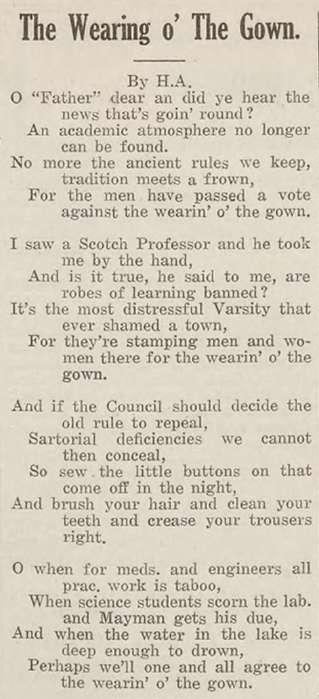
Now, it’s a little unclear, but it seems that before 1913, formal academic gowns (like those worn by colleges and people graduating) were required when attending lectures and going to libraries. The statute requiring them to be worn had been suspended for 12 years before 1925, for an unspecified reason.
In the middle of May 1925, the Committee of Melbourne University Women came to the decision ‘that the wearing gowns by undergraduates at the University was desirable’. The Student Representative Council (SRC) was to vote on it early in the next semester, which was expected to represent more of the student body.
Attended by 600, the ‘turbulent meeting’resulted in a five to three majority against gowns. This meeting was inconclusive because of the many fervent supporters both for and against gowns who kept writing passionate letters to University admin. A Special General Meeting of Students was called to ‘finally’ answer the gown question.
On 12 June, an unnamed reporter wrote an article in favour of wearing formal gowns. This reporter claimed, ‘there is a strong body of opinion favouring the resumption of the old custom’, and they listed many reasons why it would be okay if the rule were once again enforced. Two weeks later, an anonymous letter to the editor was published in Farrago, stating ‘we wish to draw attention to those University students who are using the press to voice their own views on university affairs. During the recent gown controversy, columns … gave the opinions of the particular reporter as being those of the majority of students … Surely the true facts of the case should be presented’. A division between the Farrago editors and the majority of the student body was becoming evident.
The Farrago editors began to publish both pro and anti-gown content in the next issue: ‘A prominent Ormond student has obstinately persisted in wearing his gown at lectures. It is assumed that he wishes to identify himself with the women students’. They published a pro-gown poem suggesting banning the gown would be throwing away an ancient tradition, students would become so focused on fashion that no work would
James Muller
be done, and the decision would be regretted. While obviously hyperbolic, the argument was valid: if you throw away the ancient traditions of a sandstone university, will it still be prestigious? The answer today is obviously yes. The materials used to make the buildings and their age now determines the prestige.
However, when all the buildings were new in 1925 (Old Arts hadn’t even been built yet), it was a difficult question. Was it worth throwing away a meaningless yet symbolic centuries-old tradition? Could a group of men accept something a group of women had proposed? What was Farrago’s role supposed to be in all this, an unbiased news source or a platform for amplifying the voice of its writers?
The Special General Meeting was attended by over 1000 students. The question of Farrago’s bias was at one point brought forth, to which Randall Heymanson, Farrago’s first editor, replied they were ‘students and were entitled to express their views’. After the ‘disorderly’ meeting that ‘reflected little credit on the open-mindedness and fairness of a considerable section of students’, gowns were once again voted against by the student body.
That issue of Farrago featured many student letters discussing the meeting and gowns. One student, claiming to be ‘a visitor from Timbucktu’, said ‘so god-like were the intelligence of those at the meeting that no words were necessary… a low growl that my noble friend told me was called ‘booing’ was all that was required’. Another student stated the wearing of gowns was ‘both antiquated and effeminate’.
Over the next few issues, the SRC secretary and the president of the Trinity College social club, Mr. Mayman, began arguing about the validity of the SRC’s reports regarding student opinion on gowns sent to the University Council. Where did they argue? Pretty much exclusively through letters sent into Farrago. Mayman accused the SRC secretary, Mr Sublet (his actual last name, believe it or not), of ‘misrepresenting the student attitude’ towards gowns, denigrating ‘the unbalanced presentation of the pros and cons’, and stated they told the University Council that the ‘majority of members [in the SRC Council] were in favor of wearing gowns’,
even though the ‘question had never been submitted’ formally.
The President of the SRC, Mr White, responded in the next issue of Farrago, where he admitted ‘though no formal vote was taken, I gathered that a large majority … of the members present favoured the adoption of the gown’, and he noted Mr Mayman ‘seems to display a remarkable tolerance to a considerable disturbance of his own vision’. These two student representatives were verbosely fighting on the broadsheet battlefield.
In September, after the winter break, the University Council officially removed the clause from the student statutes requiring gowns to be worn. As Farrago put it: ‘The relentless march of evolution has left the Melbourne undergraduate’s gown behind it’.
So, what did this whole gown situation mean for a fledgling Farrago? It really solidified its role as not just a place for news, but a platform for students to use to express their views to the University community. Farrago’s central role in the unfolding drama is implied to have resulted in its increased readership. Maybe without the gown controversy, Farrago wouldn’t have lasted the year and would not exist today.
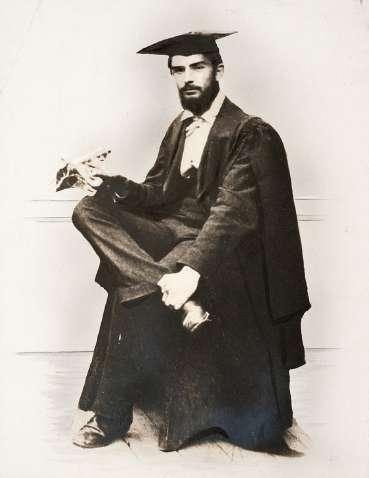
The Question of the Gown
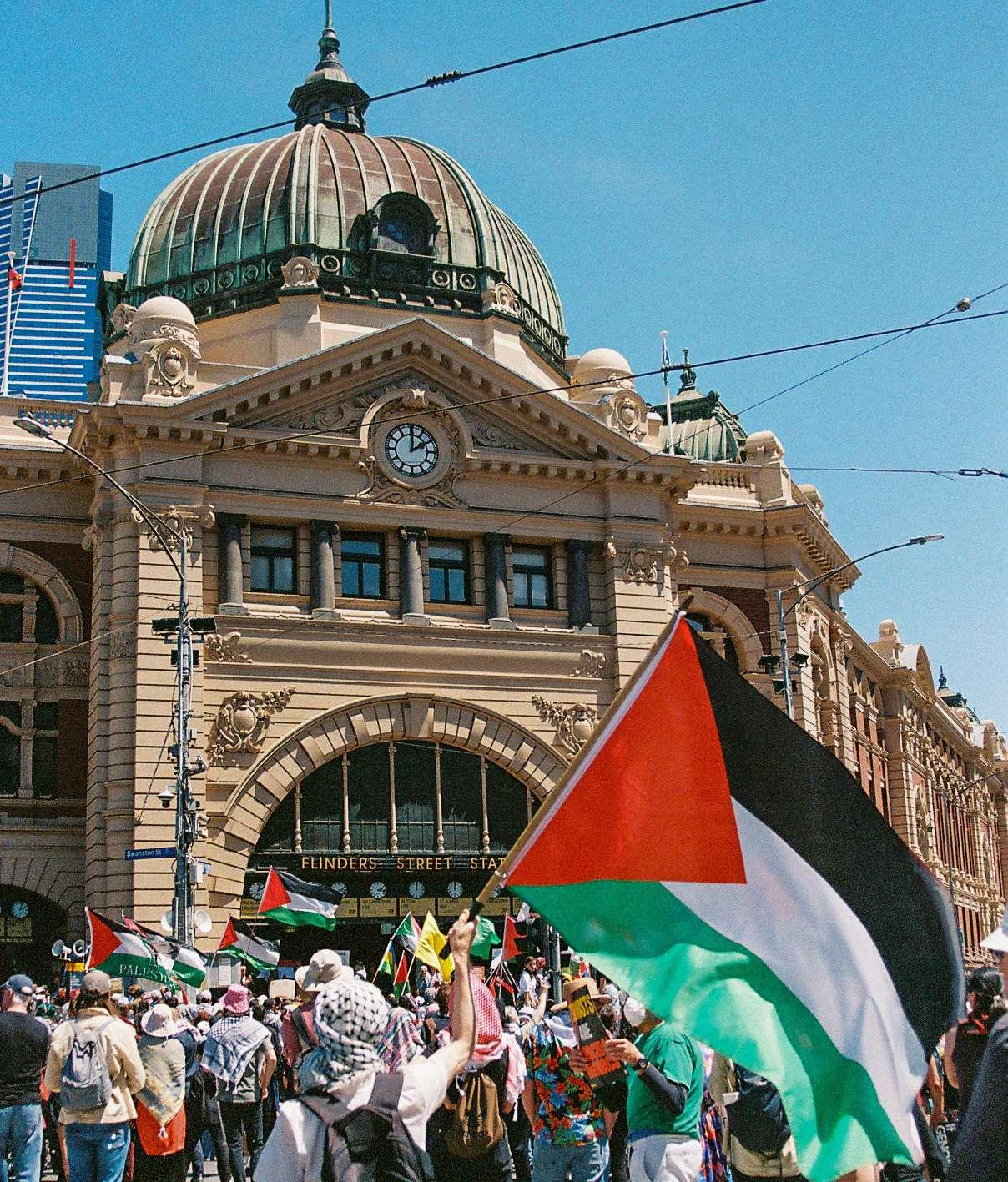

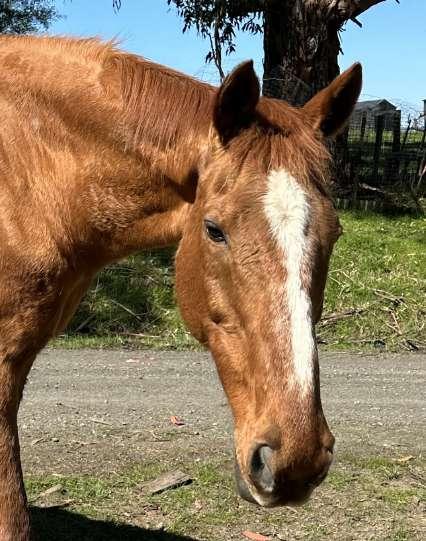
The World’s First Racist Horse
Aaron Agostini
Content Warning: Racist Horse
In a stunning advancement in biological research, scientists at the University of Melbourne have successfully engineered the world’s first racist horse. The development, heralded as a breakthrough in bigotry, raises profound ethical, philosophical and monetary questions.
‘This is an exciting development,’ said lead researcher Dr Ricky Baker, casually feeding the horse a sugar cube as it snorted disapprovingly at a nearby research assistant. ‘We’ve long known that humans have biases, but no one has ever tried to artificially program prejudice into a horse before. And now that we have, we’re really not sure what to do with it.’
The horse, named Grand Wizard Gallop, has been observed displaying clear favouritism and hostility toward certain demographics, though scientists remain baffled by its methodology. ‘There’s no clear pattern, no genetic markers it responds to — it just makes snap judgements based on a nebulous sense of historical discrimination, colonialism and outmoded evaluations of skull shape,’ said co-researcher Dr Margaret Cartwright. ‘Which, actually, confirms that we’ve successfully created the purest form of racism.’
Also in the news ...
Aaron Agostini, Sophie He & Mathilda Stewart
Warning! New Pest Sighted on Campus.
Lifecycle: Born as larva, develops into student unionist (but do not be fooled), matures into sell-out.
Pope Declares AI-generated Confessions Do Not Count
The Vatican remains undecided on ChatGPT-generated Hail Marys.
Jiankui He Out of Prison and Back on Twitter
Known for being the guy who genetically edited those babies, he says ethics are holding back scientific research which is, quite literally, the point of ethics.
Despite the controversy surrounding the project, the University remains steadfast in its commitment to pushing the boundaries of science, ethics and spending obscene amounts of research funding. ‘UniMelb has always been a leader in cutting-edge biological research,’ a spokesperson said. ‘We lead the field in gene-editing technology, regenerative medicine and now, finally, racist horses.’
Where is the horse stable, anyway? The University maintains a small horse colony dedicated to racism research in the John Medley building. The colony was originally housed in the Richard Berry Building but had to be relocated in 2016 after it was renamed to Peter Hall — a change that, for reasons still unclear, triggered a catastrophic regression in the young foals’ abilities to imprint with the distinct charm of discrimination.
Critics have questioned the purpose of the study, arguing that if discrimination were the goal, researchers could have simply attended any given suburban horse racing event. However, the team insists that Grand Wizard Gallop’s bigotry is contributing to a better tomorrow. ‘This is an exciting development,’ Dr Baker reiterated. ‘This horse’s opinions are helping us in ways science does not yet understand.’
When asked if the team planned to reverse-engineer the process and create a particularly progressive horse, Baker responded with roaring laughter. ‘Don’t be ridiculous,’ he scoffed. ‘Horses can’t be progressive. Everyone knows they’re inherently elitists.’
Grand Wizard Gallop, meanwhile, simply neighed — an action experts say contained a ‘troubling amount of subtext’.
Farrago editors sue one another, citing Right to Disconnect laws
‘Communication is chronic, ubiquitous, and causes tension at the base of my neck,’ said Sophie He, hunched over her phone. Mathilda Stewart claimed her dreams were now all email chains with the subject line ‘Touching Base’. Ibrahim Muan Abdulla, however, appeared less concerned: ‘I don’t see the problem,’ he commented via Slack, at 1:30 a.m Saturday 19 April.
With 60,000+ Full-Time Staff and Students, UniMelb Received Only 44 Complaints of Sexual Misconduct in 2024
Not a joke. Not a win.
x1 microaggression x1 missile from Lockheed Martin OR x2 evasive comments about feminist theory
Photography by Ruby Weir-Alarcon




THE CRYPTIC
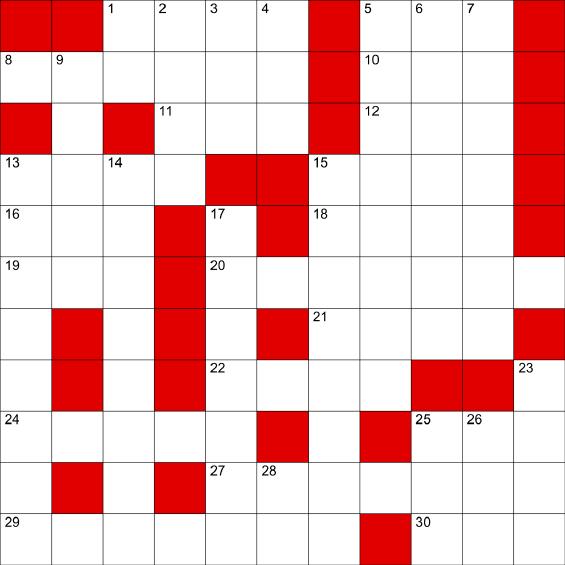
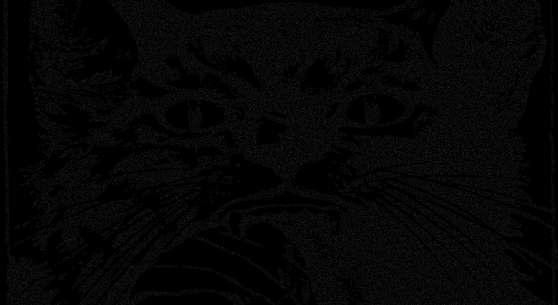
Complete the following sequences of four things.
There is exactly one correct answer to each sequence.
EG. Hypercube, Cube, Square, ______ (N-dimensional cubes, decreasing) Line

By Ivy Pierlot


1. Man consumes start of evil
5. Love gets cut off to anger
8. Condensation and myself is sexual
10. Masculine part of the female
11. Numbered like the sicks
12. Please add delicate cover
13. Horse with overheard warrior
15. Cooking material, simplified
16. Form of transport without beginning, poem
18. Tempting restless regulation
19. Glass without parent, game console
20. Closest legal act with bird home
21. Oh! Don't detail statistics
22. More male friends with reproduction and no losses
24. Start of eaten rest is an altered shyness, donut brand
25. Holding hash gets altered
27. The connections confuse the escaping
29. Relaxing bee defence happens again
30. Health within team education

1. Identity within lime
2. Slowly beheading rental
3. Friendly without the wire
4. Stolen as heard by Greek deity
5. Car detainment part of Tim Pound Sales
6. Birth broadcasted again
7. Godsend lessens overwhelmingness of eternity
9. Careful walking unsettles exchange
13. Stage name heard Nick Minaj add upside down W
14. Leftovers small, uneasy
15. Norse God is overwhelmed by punishment of water damage
17. Nationality is spreading out to be sheltered
23. God alters the cast off
25. Heating a meat
26. Time passes for a great elder
28. Its in
By Ava Vu and LF








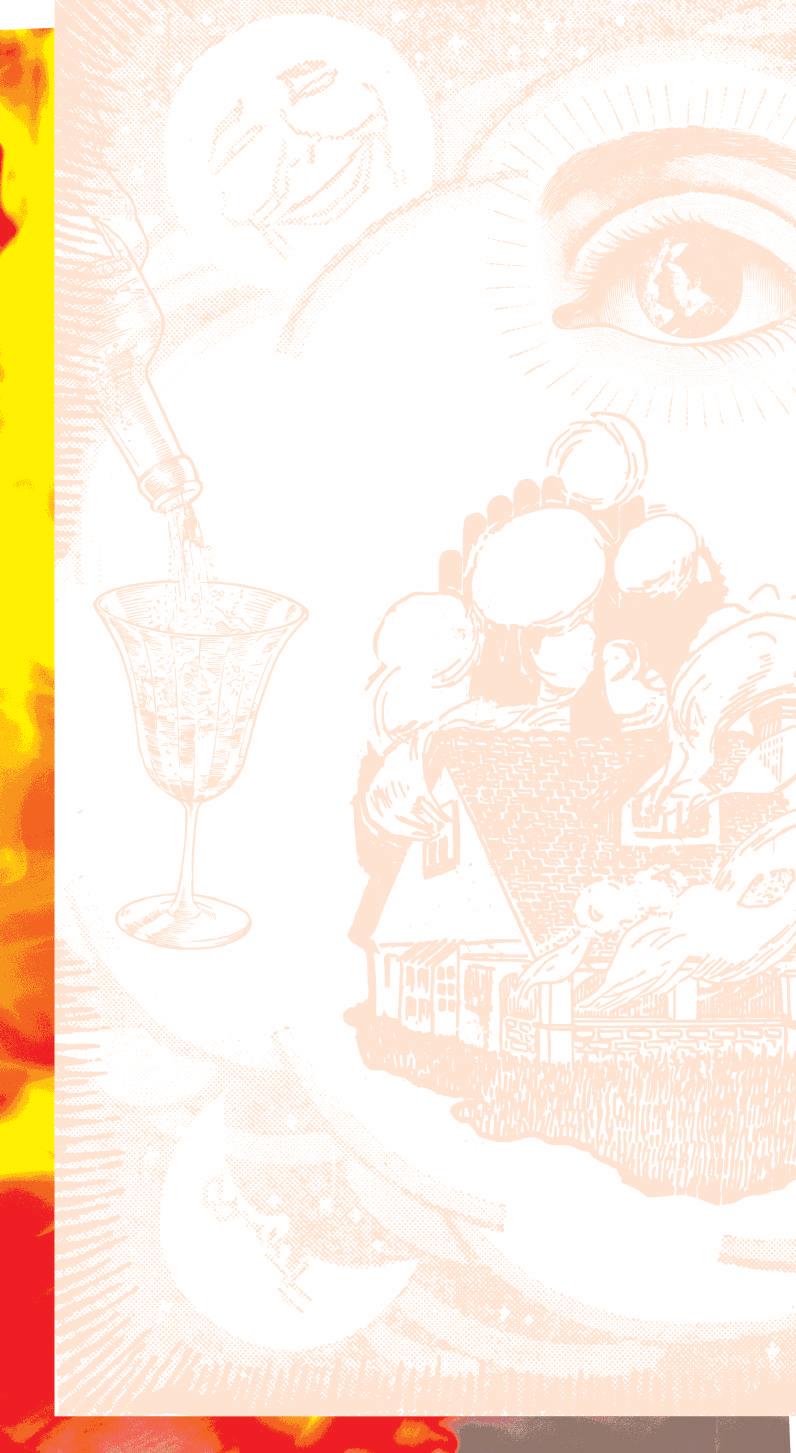

HELP
So, you want to solve the cryptic? Be warned: it will be challenging, but it is an incredibly rewarding experience once all the pieces fall into place. This guide should give you all the tools you need to solve the crossword on the page across! And don't forget, if you're struggling with a clue, it's always a good idea to take a break and come back to it with fresh eyes.
DOUBLE DEFINITIONS

CHARADES

First things first, there is one rule that is almost always the case with a cryptic crossword: every clue is made out of two parts. One part is a normal (or noncryptic) definition/synonym of the actual answer, and the other is a hint that uses wordplay to create the answer. These are the direct, and the indirect parts, respectively. Traditionally, the direct component is either at the start or the end of the clue, but the challenge is figuring that out!
Every cryptic crossword setter has their own preferences what what kinds of clues they like to write, but let's take a look now at some types of indirect clues you might see. This list is based on the New York Times cryptic solving guide, written byEmily Cox and Henry Rathvon. There are plenty of other resources available online to help you as well.
Where the indirect portion of the clue is just a second definition of the answer. Example A: Time passes a little bit (6)
ANAGRAMS
Where the clue includes some signal word, like "scrambled" or "mixed", it means that you must anagram some part of the indirect portion to make the answer. Look for groups of words that are nonsensical and may need to be anagrammed to make the answer. Example B: crew confused by animal product (4)
HIDDEN ANSWERS
Where the clue includes an indicator, like "in" or "contained", it means you need to look insidethe indirect clue to find the answer. That is, the answer might be inside a longer word or spread across some phrase.
Example C: Foreign cheese across from age previous (7)
HOMOPHONES
Where the clue includes a signal, like "heard" or "said", it means that you need to look for words that sound the same (are homophones).
Example D: Metal sounds taken (5)
WIN A $50 VOUCHER!!!

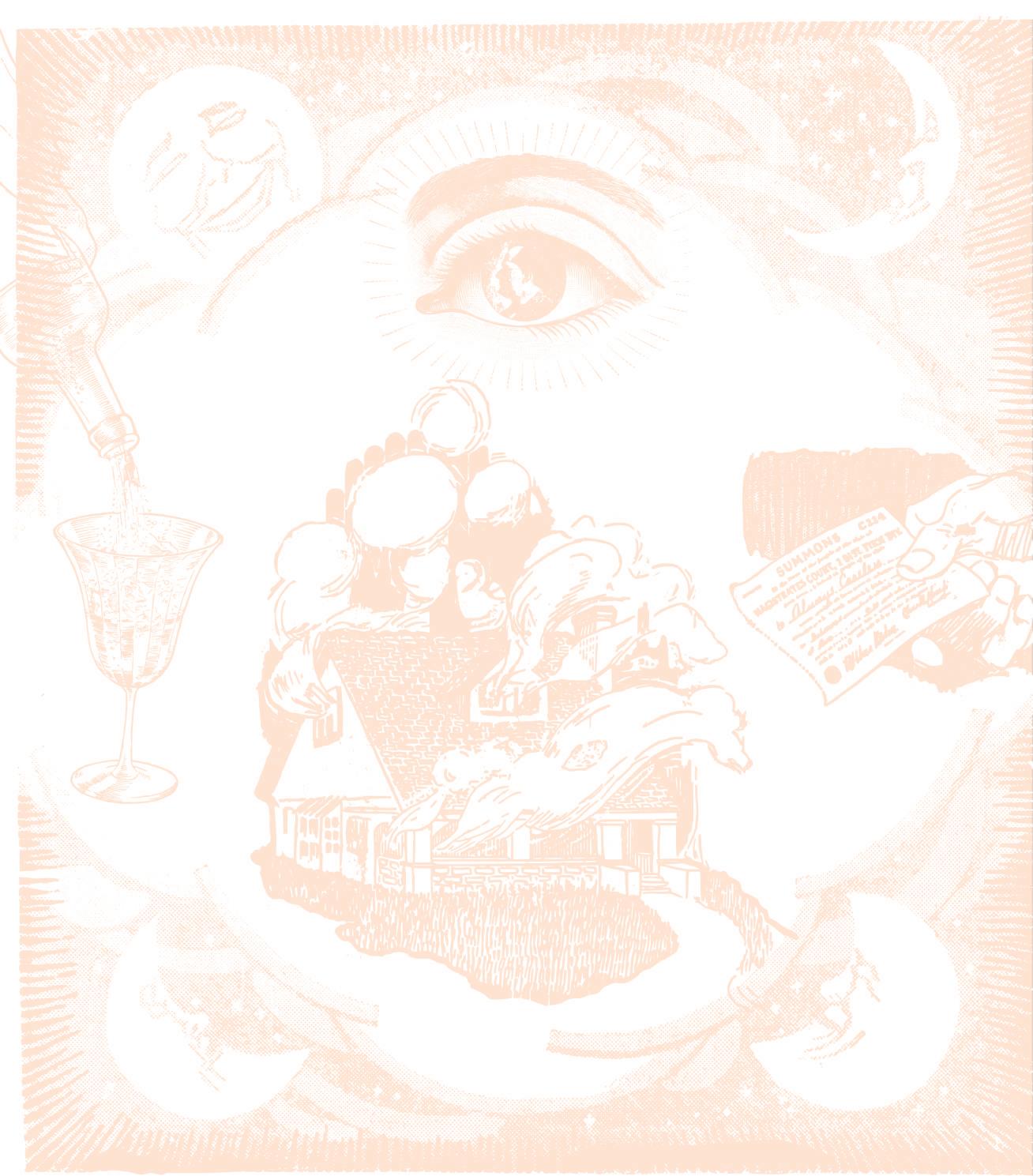
This is where the indirect part splits up the answer into two separate words and gives clues for each of those, which you need to then put back together.
Example E: Monkey coming after container for small food (6)
CONTAINERS
Where the clue includes an indicator, like "contains" or "consumes", it means that one word containsanother word (or letters) in order to make the answer.
Example F: Cooked Alaskan inside bed (5)
REVERSALS
This is when the indirect part asks you to reverse or flip a word around to get the answer.
Example G: Keep backwards to see (4)
DELETIONS
The indirect clue may ask you to remove letters from another word, to create the answer.
Example H: Bad sign beheaded too many males (3)
COMBINATION OF MANY
Example I: Repression of rulers term listened to after period of relaxation (8)
I: RESTRAIN. Charade and homophone combined. Rulers term is reign sounds like rain, period of relaxation is rest, rain after rest is restrain.
H: MEN. Bad sign, “omen”, remove first letter (beheaded) to get “men”.
Keep reversed is peek (“see”).
AK (shortening for Alaska) is put in the middle of BED.
Ape, comes after container, can.
A metal, steel, sounds like steal.
FROMAGE. Foreign cheese included from age previous.
MEAT. Crew confused (“team” anagramed) is animal product (meat).
Time passes a little bit, both minute and minute.
We DARE you to complete the Farrago Puzzles Nightmare Page!!
Go in the draw to win a $50 Readings gift voucher if you send us a picture of your completed Nightmare Page. Scan the QR code to enter!!!!!!
The winner will be drawn on the 30th of May. Rules available via the QR code.





A: MINUTE.
B:
C:
D: STEAL.
E: CANAPE.
F: BAKED.
G: PEEK.

